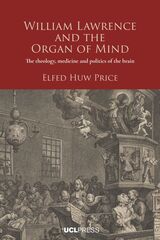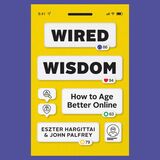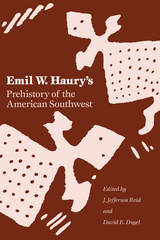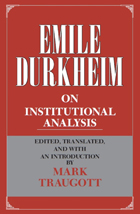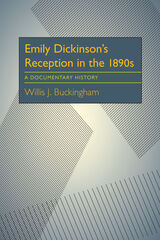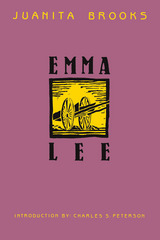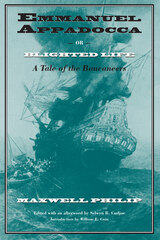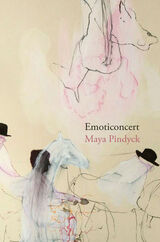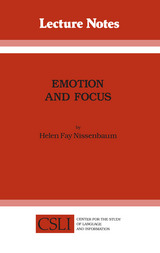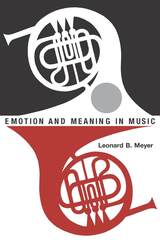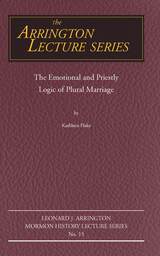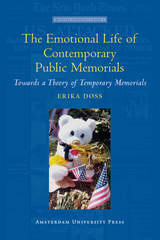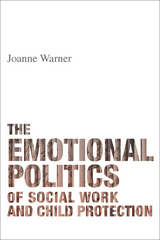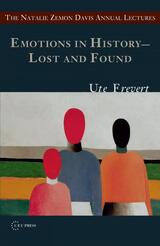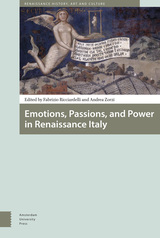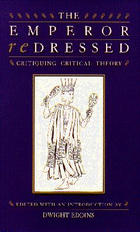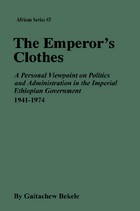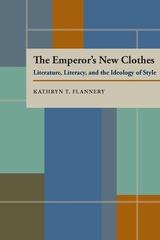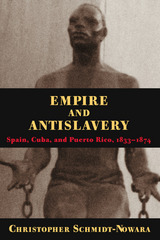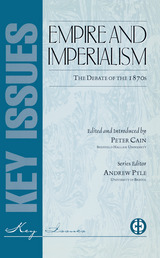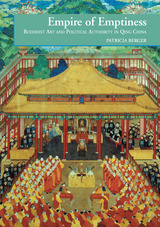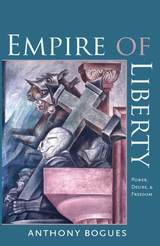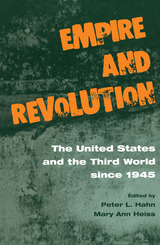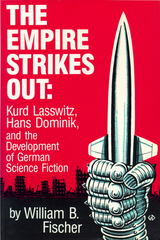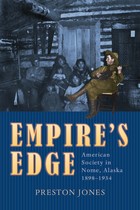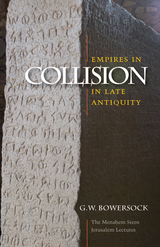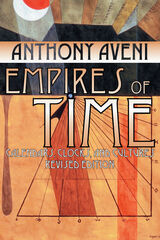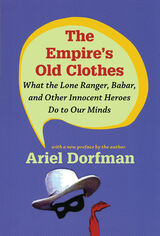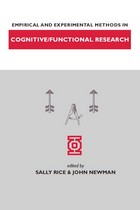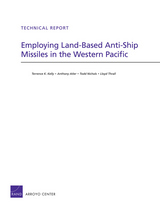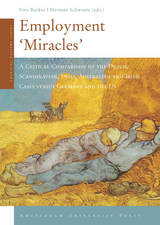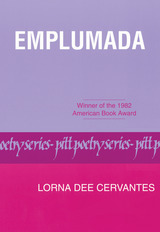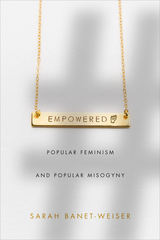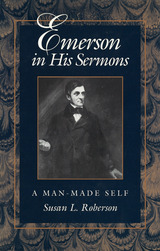 Emerson in His Sermons: A Man-Made Self
Susan L. Roberson
University of Missouri Press, 1994
Ralph Waldo Emerson is universally recognized as one of America's most influential authors and thinkers. Before achieving eminence as lecturer, essayist, and poet, though, he was a Unitaarian preacher. Emerson in His Sermons is the first major study of the sermons since the publication of The Complete Sermons of Ralph Waldo Emerson. Susan Roberson examines Emerson's ministerial career from 1826 to 1832, shedding new light on those early, crucial years in Emerson's personal and intellectual development.
Treating the sermons extensively as an autobiographical text, Roberson establishes that Emerson's years in the pulpit were pivotal and that his sermons are key texts in revealing the essential development of his thought. Central to Roberson's explication of the sermons is Emerson's conception of self-reliance, his invention of a new hero for a new age, and his merging of his own identity with that heroic idea.
Roberson focuses on Emerson's reaction to what was perhaps the most signifcant event in his personal life: the death of his young wife, Ellen, of tuberculosis in 1831, after only sixteen months of marriage. Roberson's correlation of the sermons written during that time with the complexity of Emerson's emotional and intellectual response to the tragedy of Ellen's illness and death is the most detailed and sophisticated treatment of that material to date.
Roberson understands Emerson's emergence from the ministry as his rejection of ready-made institutions and sytems of thought. Through her careful readings of the sermons, Roberson finds that Emerson's objective was less the translation of his life into writing than the translation of his life through writing. By considering the sermons in this way, Roberson is able to enrich our understanding of the private and passionte impulses of this seminal thinker.
Emerson in His Sermons offers the first real look at how the sermons fit into Emerson's own development and will have a far-reaching impact on Emerson scholarship. Anyone concerned with the cultural and religious history of America will find this book invaluable.
 The Emerson Museum: Practical Romanticism and the Pursuit of the Whole
Lee R. Brown
Harvard University Press, 1997 In 1832, Ralph Waldo Emerson had come to a critical pass. He had lost his wife and was on the brink of leaving his career as a minister. In this reduced state he traveled to New Hampshire, where he made his famous decision to pursue wholeness--in his life and in his writing. This book reveals how Emerson went about achieving this purpose--and how he conceived a uniquely American literary practice.
Central to this project were the aims and methods of natural science, which Emerson discovered in spectacular form at the Museum of Natural History (Jardin des Plantes) in Paris exactly a year after his momentous decision. Lee Rust Brown describes Emerson's use of these scientific techniques to integrate a disparate, constantly enlarging field of subject matter--ultimately, to reconceive himself as an institution of private research and public presentation not unlike the museum itself, methodically gathering specimens from the exotic frontiers of experience and setting them out, in their manifold affinities, on common ground.
The Emerson Museum shows how this undertaking transformed the legacy of European romanticism into a writing project answerable to American urgencies. The natural science of the time was itself informed by romantic demands for wholeness of prospect, and its methods offered Emerson a way to confront an American reality in which any manifestation of unity--literary, political, philosophical, psychological--had to embrace an expanding and fragmenting field of objective elements. In the experimental format of Emerson's essays, Brown identifies the evolution of this new approach and the emergence of wholeness as a national literary project.
Emerson: Prospect and Retrospect
Joel Porte
Harvard University Press, 1982 Published to mark the centenary of his death, this book helps us take measure of the work and influence of one of America's foremost thinkers, Ralph Waldo Emerson. These nine essays attempt both to come to terms with Emerson's modernity and to look back at his origins and development. They suggest how extensively Emerson is linked to the present and show how firmly he was rooted in America's past. Though Transcendentalism has often been considered synonymous with aloofness and high-minded abstraction, the essays show that Emerson in fact aimed at the greatest possible inclusiveness in his own thought and writing. His work constitutes a great storehouse of reflection on every subject conceivable to a capacious nineteenth-century imagination; it continues to invite criticism proportionate to its own scope.
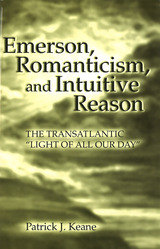 Emerson, Romanticism, and Intuitive Reason: The Transatlantic "Light of All Our Day"
Patrick J. Keane
University of Missouri Press, 2005
Emerson, Romanticism, and Intuitive Reason is a comparative study in transatlantic Romanticism, focusing on Emerson’s part in the American dialogue with British Romanticism and, as filtered through Coleridge, German Idealist philosophy. The book’s guiding theme is the concept of intuitive Reason, which Emerson derived from Coleridge’s distinction between Understanding and Reason and which Emerson associated with that “light of all our day” in his favorite stanza of Wordsworth’s “Ode: Intimations of Immortality.” Intuitive Reason became the intellectual and emotional foundation of American Transcendentalism. That light radiated out to illuminate Emerson’s life and work, as well as the complex and often covert relationship of a writer who, however fiercely “self-reliant” and “original,” was deeply indebted to his transatlantic precursors.
The debt is intellectual and personal. Emerson’s supposed indifference to, or triumph over, repeated familial tragedy is often attributed to his Idealism—a complacent optimism that blinded him to any vision of the tragic. His “art of losing” may be better understood as a tribute to the “healing power,” the consolation in distress, which Emerson considered Wordsworth’s principal value. The second part of this book traces Emerson’s struggle—with the help of the “benignant influence” shed by that “light of all our day”—to confront and overcome personal tragedy, to attain the equilibrium epitomized in Wordsworth’s “Elegiac Stanzas”: “Not without hope we suffer and we mourn.”
As a study in what has been called “the paradox of originality,” the book should appeal to those interested in the Anglo-American Romantic tradition and the innovations of the individual talent—especially in the capacity of a writer such as Emerson not only to absorb his precursors but also to use them as a stimulus to his own creative power.
 Emerson’s Daughters: Ellen Tucker Emerson, Edith Emerson Forbes, and Their Family Legacy
Kate Culkin
University of Massachusetts Press, 2025 Ellen Tucker Emerson and Edith Emerson Forbes, the daughters of Lidian Jackson and Ralph Waldo Emerson, grew up in the heart of Concord, Massachusetts’s famed literary community. In a culture that celebrated self-reliance, Ellen and Edith formed a partnership that only strengthened as their paths diverged, with Ellen remaining in the family home and Edith marrying William Forbes, moving to Milton, Massachusetts, and having eight children. The partnership allowed them to tend to the demands and opportunities created by their father’s career, including serving as his secretaries and editors, and helped them shape his posthumous image. It also enabled them to adapt to historical developments stretching from the Civil War to American imperialism as well as personal ones, including Edith’s growing family and travel and study abroad, and inevitable ones brought on by the aging processes of their parents and themselves.
Emerson’s Daughters is a biography of a sisterhood, the first full-length study of Ellen’s and Edith’s lives. Building on archival research into the extensive correspondence between the sisters, it adds to the growing body of work on women’s contribution to Transcendentalism while opening a window onto the rich, and understudied, family life of the “Sage of Concord.”
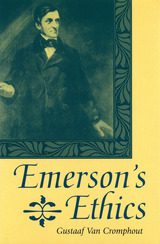 Emerson's Ethics
Gustaaf Van Cromphout
University of Missouri Press, 1999
Everyone knows that Emerson was a moralist, but what does that really mean? In an attempt to answer that question, Gustaaf Van Cromphout provides in Emerson's Ethics a detailed and philosophically grounded discussion of Emerson's moral thought. In this first comprehensive study of Emerson's ethics in the broader context of ethical theory, Van Cromphout explores Emerson's answers to what he considered the basic question facing any thinking human being: "How should I live?"
Van Cromphout begins by examining Emerson's college essays on ethics—essays that reflect his response to the moral thought prevailing in his intellectual environment. He then discusses the mature Emerson's attempt to establish ethics on a surer foundation than the religion inherited from his forebears, showing that Emerson was influenced significantly by Kant's moral thought.
He goes on to examine Emerson's search for a morally competent self in an age when the very notion of "self" was under serious threat. The ethical dimension of Emerson's politics and his theories of friendship and love, as well as the quest for a life worth living in the modern world, are also addressed. The last chapters are devoted to nature and literature. Van Cromphout explores Emerson's understanding of nature as a focus of ethical responsibility, and he examines the corruptibility of language, the ethics of self- expression, and the moral responsibilities of writers toward their audiences. Emerson believed that ethics permeated every aspect of human life. By examining Emerson's understanding of ethics and his contribution to ethical thought, Emerson's Ethics shows one of the truly great minds in American culture confronting issues of fundamental relevance to all human beings. Filling an important gap in Emerson studies, this book will appeal not only to readers interested in Emerson and his significance in American thought and literature but also to readers concerned with ethics and, more generally, with the interrelations of literature and philosophy.
 Emerson’s Liberalism
Neal Dolan
University of Wisconsin Press, 2009 Emerson’s Liberalism explains why Ralph Waldo Emerson has been and remains the central literary voice of American culture: he gave ever-fresh and lasting expression to its most fundamental and widely shared liberal values. Liberalism, after all, is more than a political philosophy: it is a form of civilization, a set of values, a culture, a way of representing and living in the world. This book makes explicit what has long been implicit in America’s embrace of Emerson.
Neal Dolan offers the first comprehensive and historically informed exposition of all of Ralph Waldo Emerson’s writings as a contribution to the theory and practice of liberal culture. Rather than projecting twentieth-century viewpoints onto the past, he restores Emerson’s great body of work to the classical liberal contexts that most decisively shaped its general political-cultural outlook—the libertarian-liberalism of John Locke, the Scottish Enlightenment, the American founders, and the American Whigs.
In addition to in-depth consideration of Emerson’s journals and lectures, Dolan provides original commentary on many of Emerson’s most celebrated published works, including Nature, the “Divinity School Address,” “History,” “Compensation,” “Experience,” the political addresses of the early 1840s, “An Address . . . on . . . The Emancipation of the Negroes in the British West Indies,” Representative Men, English Traits, and The Conduct of Life. He considers Emerson’s distinctive elaborations of foundational liberal values—progress, reason, work, property, limited government, rights, civil society, liberty, commerce, and empiricism. And he argues that Emerson’s ideas are a morally bracing and spiritually inspiring resource for the ongoing sustenance of American culture and civilization, reminding us of the depth, breadth, and strength of our common liberal inheritance.
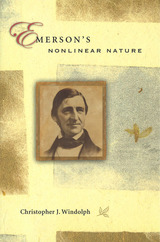 Emerson's Nonlinear Nature
Christopher J. Windolph
University of Missouri Press, 2007
In this provocative study, Christopher Windolph analyzes Emersonian naturalism from the standpoint of nonlinearity, offering new ways of reading and thinking about Emerson’s stance toward naturalism and the influence of science on his thought. Drawing on ideas in perspective theory, architecture, and nonlinear dynamics to argue that Emerson’s natural philosophy follows from his analysis of the development of organic forms, Windolph breaks new ground in Emerson studies by exploring how considerations of shape and the act of seeing underpin all of Emerson’s theories about nature.
Bringing to his study a focused attention to the history of Western science and philosophy, Windolph reexamines Emerson’s understanding of how the act of seeing occurs and of the eye’s ability to see through appearances to organizing principles, showing how Emerson’s naturalism extends beyond the narrow confines of traditional linear science. Through extensive readings of Emerson’s journals, essays, and lectures, Windolph shows that Emerson was an empirical idealist who integrated a scientific approach to nature with an exploration of nonlinear principles, revealing him to be more prescient in his writings about certain recent developments in scientific thought than has been realized.
This work makes a major contribution to the ongoing study of Emerson and science, expanding Emerson’s role as a major American philosopher while rebutting those who see him primarily as a rhetorician or poetic propagandist. Emerson’s Nonlinear Nature opens new ways of thinking about Emerson’s work in its nineteenth-century contexts, reassesses his reception in twentieth-century criticism, and makes a strong case for his continuing relevance in the century ahead.
EMI Troubleshooting Cookbook for Product Designers
Patrick G. André
The Institution of Engineering and Technology, 2014 EMI Troubleshooting Cookbook for Product Designers provides the 'recipe' for identifying why products fail to meet EMI/EMC regulatory standards. It also outlines techniques for tracking the noise source, and discovering the coupling mechanism, that is causing the undesired effects.
 Emigrant Nation: The Making of Italy Abroad
Mark I. Choate
Harvard University Press, 2008 Between 1880 and 1915, thirteen million Italians left their homeland, launching the largest emigration from any country in recorded world history. As the young Italian state struggled to adapt to the exodus, it pioneered the establishment of a “global nation”—an Italy abroad cemented by ties of culture, religion, ethnicity, and economics.
In this wide-ranging work, Mark Choate examines the relationship between the Italian emigrants, their new communities, and their home country. The state maintained that emigrants were linked to Italy and to one another through a shared culture. Officials established a variety of programs to coordinate Italian communities worldwide. They fostered identity through schools, athletic groups, the Dante Alighieri Society, the Italian Geographic Society, the Catholic Church, Chambers of Commerce, and special banks to handle emigrant remittances. But the projects aimed at binding Italians together also raised intense debates over priorities and the emigrants’ best interests. Did encouraging loyalty to Italy make the emigrants less successful at integrating? Were funds better spent on supporting the home nation rather than sustaining overseas connections?
In its probing discussion of immigrant culture, transnational identities, and international politics, this fascinating book not only narrates the grand story of Italian emigration but also provides important background to immigration debates that continue to this day.
 The Emigrants
George Lamming
University of Michigan Press, 1994 The Emigrants is an elaborately conceived novel, dense with dynamic characters and evocative details. First published in 1954, it focuses initially on the emigrant journey, then on the settling-in process. The journey by sea and subsequent attempts at resettlement provide the fictional framework for Lamming's exploration of the alienation and displacement caused by colonialism.
This is the epic journey of a group of West Indians who emigrate to Great Britain in the 1950s in search of educational opportunities unattainable at home. Seeking to redefine themselves in the "mother country," an idealized landscape that they have been taught to revere, the emigrants settle uncomfortably in England's industrial cities. Within two years, ghettoization is firmly in place. The emigrants discover the meaning of their marginality in the British Empire in an environment that is unexpectedly hostile and strange. For some, alienation prompts a new sense of community, a new sense of identity as West Indians. For others, alienation leads to a crisis of confrontation with the law and fugitive status.
There is a wealth of information here about the genesis of the black British community and about the cultural differences between the black British and West Indian/Caribbean.
Emil W. Haury's Prehistory of the American Southwest
Edited by J. Jefferson Reid and David E. Doyel
University of Arizona Press, 1986 "Emil Haury stands as one of the finest archaeologists of the American Southwest. He skills were sharpened by the best mentors—Cummings, Douglass, Gladwin—and eventually Haury's excavations became the definitive work on the Mogollon and Hohokam cultures. . . . This work is a 'best of Haury' collection of many of his previously published works, with excellent introductory essays by colleagues and noted archaeologists—gathered into one, readable volume."—Choice
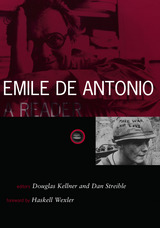 Emile De Antonio: A Reader
Douglas Kellner
University of Minnesota Press, 2000 An absorbing collection of writings by and about an American original. Innovative documentary filmmaker; friend of Andy Warhol, John Cage, Jasper Johns, Robert Rauschenberg, and other leading figures of the New York art world; radical leftist critic of the Establishment; and legendary bon vivant: Emile de Antonio (1919-1989) was a larger-than-life personality and a key figure in the development of postwar American cinema. The films de Antonio made between 1963 and 1989—including Point of Order, Rush to Judgment, In the Year of the Pig, Painters Painting, and Millhouse: A White Comedy—revolutionized the documentary format and inspired a generation of artists and filmmakers. A decade after his death, his cinematic legacy—ranging from the brilliantly edited compilation of the 1954 Army-McCarthy hearings that helped construct Senator Joseph McCarthy’s reputation as a rogue demagogue (Point of Order) to a meditative juxtaposition of documents about F.B.I. director J. Edgar Hoover and intimate footage drawn from the filmmaker’s own life (Mr. Hoover and I)-remains unparalleled in American documentary film. Emile de Antonio: A Reader is the first full-length volume devoted to this major American filmmaker. It collects interviews with and writings by de Antonio; reviews and other critical material that detail the genesis, production history, and reception of his films; a comprehensive filmography; and an in-depth biographical essay. Offering a long-overdue assessment of de Antonio’s career, this indispensable book also makes a significant contribution to our understanding of American independent cinema at its most politically engaged.
Emile Durkheim on Institutional Analysis
Emile Durkheim
University of Chicago Press, 1978 Ranging from Durkheim's original lecture in sociology to an excerpt from the work incomplete at his death, these selections illuminate his multiple approaches to the crucial concept of social solidarity and the study of institutions as diverse as the law, morality, and the family. Durkheim's focus on social solidarity convinced him that sociology must investigate the way that individual behavior itself is the product of social forces. As these writings make clear, Durkheim pursued his powerful model of sociology through many fields, eventually synthesizing both materialist and idealist viewpoints into his functionalist model of society.
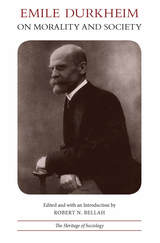 Emile Durkheim on Morality and Society
Emile Durkheim
University of Chicago Press, 1975 Emile Durkheim is best known in this country as a great sociologist and methodologist. Yet it was Durkheim's reflections on morality and society that spoke most deeply of his vital concerns. In his informative introduction to this work, Robert N. Bellah describes Durkheim as moralist, philosopher, theologian, and prophet, as well as sociologist, and the selections in this volume are representative of these aspects of Durkheim's many-faceted scholarship.
The first two selections of the volume set the context for the development of Durkheim's sociology of morality. Section I, "The French Tradition of Social Thought," gives Durkheim's picture of how his sociology is to be situated relative to the general French tradition. Section II, "Sociology and Social Action," shows Durkheim grappling with moral and political issues in his society and indicates the immediate social context of his thinking.
The remaining selections indicate some of the major substantive areas of Durkheim's sociology of morality. Section III, taken from The Division of Labor in Society, demonstrates his basically evolutionary approach to the development of moral norms in society. Section IV, "The Learning of Morality," gives examples of Durkheim's work on socialization. Section V, "Social Creativity," deals with the important question of how new moral norms arise in society.
 Emily Davies: Collected Letters, 1861-1875
Emily Davies
University of Virginia Press, 2004 Sarah Emily Davies (1830-1921) lived and crusaded during a time of profound change for education and women's rights in England. At the time of her birth, women's suffrage was scarcely open to discussion, and not one of England's universities (there were four) admitted women. By the time of her death, not only had the number of universities grown to twelve, all of which were open to women; women had also begun to get the vote. Davies's own activism in the women's movement and in the social and educational reform movements of the time culminated in her founding of Girton College, Cambridge University, the first residential college of higher education for women.
Much of the social change that Davies witnessed--and helped to effect--was discussed, encouraged, and elicited through her personal correspondence. These letters, written to friends, allies, and potential supporters during the years of Davies's greatest political and social activity, reveal the evolution of her skill and sophistication as an activist. They also show the development of women's suffrage, education, and journalism movements from a group of loosely affiliated like-minded friends to an astute and organized political network of reformers. In these letters-most of which have never been published-we see Davies struggle to understand and theorize about the role of women, cajole and encourage potential supporters, explore complexities of various reform movements, and demonstrate her formidable attention to detail in inventing and constructing an imaginable new institution. Her intensely engaged life placed Davies at the very heart of the events that transformed her era.
--------------------------------------------------------------------------------
Ann B. Murphy is Associate Professor of English at Assumption College. Deirdre Raftery, Lecturer in Education at University College Dublin, is the author of Women and Learning in English Writing, 1600-1900.
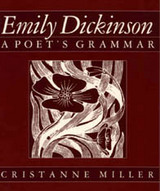 Emily Dickinson: A Poet’s Grammar
Cristanne Miller
Harvard University Press, 1987 In this inventive work on Emily Dickinson’s poetry, Cristanne Miller traces the roots of Dickinson’s unusual, compressed, ungrammatical, and richly ambiguous style, finding them in sources as different as the New Testament and the daily patterns of women’s speech. Dickinson writes as she does both because she is steeped in the great patriarchal texts of her culture, from the Bible and hymns to Herbert’s poetry and Emerson’s prose, and because she is conscious of writing as a woman in an age and culture that assume great and serious poets are male.
Miller observes that Dickinson’s language deviates from normal construction along definable and consistent lines; consequently it lends itself to the categorical analysis of an interpretive “grammar” such as the one she has constructed in this book. In order to facilitate the reading of Dickinson’s poems and to reveal the values and assumptions behind the poet’s manipulations of language, Miller examines in this grammar how specific elements of the poet’s style tend to function in various contexts. Because many, especially modernist, poets use some of the same techniques, the grammar throws light on the poetic syntax of other writers as well.
In the course of her analysis, Miller draws not only on traditional historical and linguistic sources but also on current sociolinguistic studies of gender and speech and on feminist descriptions of women’s writing. Dickinson’s language, she concludes, could almost have been designed as a model for twentieth-century theories of what a women’s language might be. As a critical examination of the relationship between linguistic style and literary identity in America’s greatest woman poet, Emily Dickinson: A Poet’s Grammar provides a significant addition to feminist literary studies.
 Emily Dickinson and the Labor of Clothing
Daneen Wardrop
University of New Hampshire Press, 2009 Daneen Wardrop's Emily Dickinson and the Labor of Clothing begins by identifying and using the dating tools of fashion to place the references to clothing in Dickinson's letters and poems, and to locate her social standing through examining her fashion choices in the iconic daguerreotype. In addition to detailing the poetics of fashion in Dickinson's work, the author argues that close examination of Dickinson and fashion cannot be separated from the changing ways that garments were produced during the nineteenth century, embracing issues of domestic labor, the Lowell textile mills, and the Amherst industry of the Hills Hat Factory located almost next door to Dickinson's Homestead. The recent retrieval of clothing from approximately thirty trunks found in the attic of the Evergreens house, which formerly belonged to Dickinson's brother and sister-in-law, further enhances this remarkable and original interdisciplinary work.
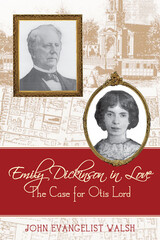 Emily Dickinson in Love: The Case for Otis Lord
Walsh, John Evangelist
Rutgers University Press, 2012 From the award-winning author of Poe the Detective: The Curious Circumstances Behind "The Mystery of Marie Roget" comes a compelling argument for the identity of Emily Dickinson’s true love Proud of my broken heart Since thou didst break it, Proud of the pain I Did not feel till thee . . . Those words were written by Emily Dickinson to a married man. Who was he? For a century or more the identity of Emily Dickinson’s mysterious “Master” has been eagerly sought, especially since three letters from her to him were found and published in 1955. In Emily Dickinson in Love, John Evangelist Walsh provides the first book-length treatment of this fascinating subject, offering a solution based wholly on documented facts and the poet’s own writings. Crafting the affair as a love story of rare appeal, and writing with exquisite attention to detail, in Part I Walsh reveals and meticulously proves the Master to be Otis Lord, a friend of the poet’s father and a man of some reputation in law and politics. Part II portrays the full dimensions of their thirty-year romance, most of it clandestine, including a series of secret meetings in Boston. After uncovering and confirming the Master’s identity, Walsh fits that information into known events of Emily’s life to make sense of facts long known but little understood—Emily’s decision to dress always in white, for instance, or her extreme withdrawal from a normal existence when she had previously been an active, outgoing friend to many men and women. In a lengthy section of Notes and Sources, Walsh presents his proofs in abundant detail, demonstrating that the evidence favors one man so irresistibly that there is left no room for doubt. Each reader will decide if he has truly succeeded in making the case for Otis Lord.
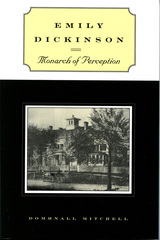 Emily Dickinson: Monarch of Perception
Domhnall Mitchell
University of Massachusetts Press, 2000 Emily Dickinson has often been pictured as a sensitive but isolated poet--someone who published very little in her lifetime and limited herself to lyrics, considered to be the kind of poems most removed from social and political life. In recent years, scholars have challenged that view, and this book extends the discussion in valuable new directions.
Domhnall Mitchell begins by focusing on three historical phenomena--the railroad, the Dickinson homestead, and horticulture--and argues that poems about trains, home, and flowers engage with thei meanings in ways that extend beyond the confines of the aesthetic. He shows how Dickinson's poems and letters reveal the full complexity of her position as a woman situated within a larger social and economic class.
In the second half of the book, Mitchell considers the ideological, textual, and editorial implications of Dickinson's strategic privatization of her art. He relates the particular forms of her manuscripts' appearance, distribution, and collation to aspects of her social as well as her literary consciousness. In a chapter that is certain to provoke debate, he explores what it means to read individual poems and letters in manuscript versions rather than in printed editions. By paying close attention to textual evidence, he makes the case that various features of the manuscripts are actually matters of accident or immediate convenience rather than the visual markers of a new aestheic principle.
Mitchell closes by using the theories of Mikhail Bakhtin to explore the contradictions of a "private" poetry that engages verbally in multiple areas of nineteenth-century life and discourse. By attending to the contemporaneous particularities of recurrent words and images, he demonstrates that Dickinson could stay at home and still be at home in history, too.
Emily Dickinson: Selected Letters
Emily Dickinson
Harvard University Press When the complete Letters of Emily Dickinson appeared in three volumes in 1958, Robert Kirsch welcomed them in the Los Angeles Times, saying “The missives offer access to the mind and heart of one of America’s most intriguing literary personalities.” This one-volume selection is at last available in paperback. It provides crucial texts for the appreciation of American literature, women’s experience in the nineteenth century, and literature in general.
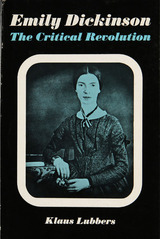 Emily Dickinson: The Critical Revolution
Klaus Lubbers
University of Michigan Press, 2025 Emily Dickinson's rise to fame exemplifies the revolution in literary values that has occured during the past century. In this book Klaus Lubbers examines the changing course of Dickinson criticism in America and England from the beginnings up to recent years. His study throws much light on shifting critical standards, and through its discussion of widely varying evaluations it provides a heightened understanding of her art. Lubbers shows that even during the 1890's, when the first volumes were posthumously published, there were perceptive spirits who valued Emily Dickinson's poetry. Among these were Mabel Loomis Todd, Thomas Wentworth Higginson, and William Dean Howells. Yet American critics generally were baffled and grudging. In Great Britain the Scottish arbiter Andrew Lang was flatly hostile. As for the reading public, Higginson and Mrs. Todd felt it necessary, in editing the poems for publication, to make scores of textual changes in order to render them more acceptable to a generation accustomed to Whittier and Longfellow. It was during the creative and critical renaissance of the second decade of the twentieth century, Lubbers finds, that Emily Dickinson began to be discovered as one of the great American poets. In 1914 Harriet Monroe granted her, writes Lubbers, "honorary membership in the Imagist movement." In the period that followed, others to take up her cause included Robert Hillyer, Herbert Gorman, Amy Lowell, Louis Untermeyer, Conrad Aiken, and Carl and Mark Van Doren. "Year by year," Lubbers quotes Robert Hillyer, "the knowledge of her secret spreads, as friend whispers to friend and confides the inimitable poet to a new lover." Lubbers marks the period from 1930 to the 1960's as that in which Emily Dickinson's reputation has been consolidated. In the 1930's the New Critics, notably Allen Tate, Richard Blackmur, and Yvor Winters, contributed important insights to the understanding of her poetry. The thirties also saw the publication of George F. Whicher's critical biography, This Was A Poet. In the fifties and sixties came Thomas H. Johnson's critical edition of the poems and Charles R. Anderson's interpretive study, Emily Dickinson's Poetry: Stairway of Surprise. All these commentaries and many more are judiciously weighed in Lubbers' impressively documented survey. In addition, this book unravels the tangled publication history of the poems; it investigates the textual changes in editions before Johnson's; and it points to the growing interest in Emily Dickinson reflected in novels and plays based on her life. Its list of more than 1,000 sources is by far the most complete Dickinson bibliography in print. Lubbers has, in short, produced a comprehensive work of scholarship that will be invaluable to students of criticism and readers of Emily Dickinson.
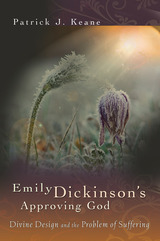 Emily Dickinson's Approving God: Divine Design and the Problem of Suffering
Patrick J. Keane
University of Missouri Press, 2008
As much a doubter as a believer, Emily Dickinson often expressed views about God in general—and God with respect to suffering in particular. In many of her poems, she contemplates the question posed by countless theologians and poets before her: how can one reconcile a benevolent deity with evil in the world?
Examining Dickinson’s perspectives on the role played by a supposedly omnipotent and all-loving God in a world marked by violence and pain, Patrick Keane initially focuses on her poem “Apparently with no surprise,” in which frost, a “blonde Assassin,” beheads a “happy Flower,” a spectacle presided over by “an Approving God.” This tiny lyric,Keane shows, epitomizes the poet’s embattled relationship with the deity of her Calvinist tradition.
Although the problem of sufferingis usually couched in terms of natural disasters or human injustice, Dickinson found new ways of considering it. By choosing a flower as her innocent “victim,” she bypassed standard “answers” to the dilemma (suffering as justified punishment for wickedness, or as attributable to the assertion of free will) in order to focus on the problem in its purest symbolic form. Keane goes on toprovide close readings of many of Dickinson’s poems and letters engaging God, showing how she addressed the challenges posed—by her own experience and by an innate skepticism reinforced by a nascent Darwinism—to the argument from design and the concept of a benevolent deity.
More than a dissection of a single poem, Keane’s book is a sweeping personal reflection on literature and religion, faith and skepticism, theology and science. He traces the evolving history of the Problem of Suffering from the Hebrew Scriptures (Job and Ecclesiastes), through the writings of Paul, Augustine, and Aquinas, to the most recent theological and philosophical studies of the problem. Keane is interested in how readers today respond to Emily Dickinson’s often combative poems about God; at the same time, she is located as a poet whose creative life coincided with the momentous changes and challenges to religious faith associated with Darwin andNietzsche.Keane also considers Dickinson’s poems and letters in the context of the great Romantic tradition, as it runs fromMilton throughWordsworth, demonstrating how thework of these poets (perhaps surprisingly in the case of the latter)helps illuminate Dickinson’s poetry and thought.
Because Dickinson the poet was also Emily the gardener, her love of flowers was an appropriate vehicle for her observations on mortality and her expressions of doubt. Emily Dickinson’s Approving God is a graceful study that reveals not only the audacity of Dickinson’s thought but also its relevance to modern readers. In light of ongoing confrontations between Darwinism and design, science and literal conceptions of a divine Creator, it is an equally provocative read for students of literature and students of life.
 Emily Dickinson'S Gothic: Goblin With A Gauge
Daneen Wardrop
University of Iowa Press, 1996 Emily Dickinson should stand as a major gothic author among her nineteenth-century American contemporaries, but two factors have previously prevented her inclusion in such company. Perhaps the most obvious is the problem of the genre: Dickinson writes gothic poetry, whereas gothic fiction defines the genre. In addition, her poetic personae have served over the decades to prompt critics to “protect” her; traditional critics concentrated on the sweet, romantic elements of her oeuvre. More recent readers, notably Sandra Gilbert and Susan Gubar, Jane Egerwein, and Cynthia Griffin Wolff, have begun studying Dickinson's gothic traits; Emily Dickinson's Gothic explores Dickinsonian gothicism with the systematic rigor it demands and deserves. Emily Dickinson's Gothic also addresses sociohistorical concerns, from hallowed gothic conventions dating from Horace Walpole's eighteenth century to such modernist neogothic topics as rape, the void, and disjunctive language that appear in the latter nineteenth and early twentieth centuries. Wardrop recognizes the full extent to which the gothic pervades Dickinson's canon and the means by which the gothic determines her aesthetic. Such full consideration of women's gothicism allows the placement of Dickinson within a literary context, both in terms of American writers and in terms of women writers.
 Emily Dickinson's Herbarium: A Facsimile Edition
Emily Dickinson
Harvard University Press, 2006 In a letter from 1845, the 14-year-old Emily Dickinson asked her friend Abiah Root if she had started collecting flowers and plants for a herbarium: "it would be such a treasure to you; 'most all the girls are making one." Emily's own album of more than 400 pressed flowers and plants, carefully preserved, has long been a treasure of Harvard's Houghton Library. This beautifully produced, slipcased volume now makes it available to all readers interested in the life and writings of Emily Dickinson.
The care that Emily put into her herbarium, as Richard Sewall points out, goes far beyond what one might expect of a botany student her age: "Take Emily's herbarium far enough, and you have her." The close observation of nature was a lifelong passion, and Emily used her garden flowers as emblems in her poetry and her correspondence. Each page of the album is reproduced in full color at full size, accompanied by a transcription of Dickinson's handwritten labels. Introduced by a substantial literary and biographical essay, and including a complete botanical catalog and index, this volume will delight scholars, gardeners, and all readers of Emily Dickinson's poetry.
Emily Dickinson’s Letters to Dr. and Mrs. Josiah Gilbert Holland
Emily Dickinson
Harvard University Press The ninety-three letters—and the poems, over thirty in all, which she included in the letters or sent in place of them—written by Emily Dickinson to her dear friends the Hollands, are intimate, spontaneous, and at the same time as characteristically poetic as everything Emily ever wrote or said. They span the major portion of Emily's adult life, from her twenties to her death. A detailed study of handwriting and paper has made possible a new historical approach to her life, her prose, and her poetry.
This is the first of the books made possible by Harvard's acquisition of the Dickinson papers and the rights connected with them.
 Emily Dickinson's Music Book and the Musical Life of an American Poet
George Boziwick
University of Massachusetts Press, 2022 After years of studying piano as a young woman in her family home in Amherst, Massachusetts, Emily Dickinson curated her music book, a common practice at the time. Now part of the Dickinson Collection in the Houghton Library of Harvard University, this bound volume of 107 pieces of published sheet music includes the poet’s favorite instrumental piano music and vocal music, ranging from theme and variation sets to vernacular music, which was also enjoyed by the family’s servants. Offering a fresh historical perspective on a poetic voice that has become canonical in American literature, this original study brings this artifact to life, documenting Dickinson’s early years of musical study through the time her music was bound in the early 1850s, which tellingly coincided with the writing of her first poems. Using Dickinson’s letters and poems alongside newspapers and other archival sources, George Boziwick explores the various composers, music sellers, and publishers behind this music and Dickinson’s attendance at performances, presenting new insights into the multiple layers of meaning that music held for her.
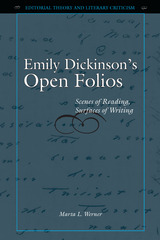 Emily Dickinson's Open Folios: Scenes of Reading, Surfaces of Writing
Marta L. Werner
University of Michigan Press, 1996 Emily Dickinson's Open Folios: Scenes of Reading, Surfaces of Writing is a fine facsimile edition and aesthetic exploration of a group of forty late drafts and fragments hitherto known as the "Lord letters." The drafts are presented in facsimile form on high-quality paper alongside typed transcriptions that reproduce as fully as possible the shock of script and startling array of visual details inscribed on the surfaces of the manuscripts.Werner argues that a redefinition of the editorial enterprise is needed to approach the revelations of these writings-- the details that have been all but erased by editorial interventions and print conventions in the twentieth century. Paradoxically, "un-editing" them allows an exploration of the relationship between medium and messages. Werner's commentary forsakes the claims to comprehensiveness generally associated with scholarly narrative in favor of a series of speculative and fragmentary "close-ups"--a portrait in pieces. Finally, she proposes the acts of both reading and writing as visual poems.A crucial reference for Dickinson scholars, this book is also of primary importance to textual scholars, editorial theorists, and students of gender and cultural studies interested in the production, dissemination, and interpretation of works by women writers.This publication has been supported by a grant from the National Endowment for the Humanities.
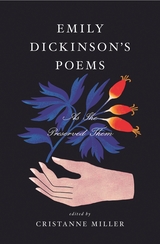 Emily Dickinson’s Poems: As She Preserved Them
Emily Dickinson
Harvard University Press, 2016 Widely considered the definitive edition of Emily Dickinson’s poems, this landmark collection presents her poems here for the first time “as she preserved them,” and in the order in which she wished them to appear. It is the only edition of Dickinson’s complete poems to distinguish clearly those she took pains to copy carefully onto folded sheets in fair hand—presumably to preserve them for posterity—from the ones she kept in rougher form. It is also unique among complete editions in presenting the alternate words and phrases Dickinson chose to use on the copies of the poems she kept, so that we can peer over her shoulder and see her composing and reworking her own poems.
The world’s foremost scholar of Emily Dickinson, Cristanne Miller, guides us through these stunning poems with her deft and unobtrusive notes, helping us understand the poet’s quotations and allusions, and explaining how she composed, copied, and circulated her poems. Miller’s brilliant reordering of the poems transforms our experience of them.
A true delight, this award-winning collection brings us closer than we have ever been to the writing practice of one of America’s greatest poets. With its clear, uncluttered page and beautiful production values, it is a gift for students of Emily Dickinson and for anyone who loves her poems.
Emily Dickinson’s Reception in the 1890s: A Documentary History
Willis J. Buckingham
University of Pittsburgh Press, 1986
This work reprint, annotates, and indexes virtually all mention of Emily Dickinson in the first decade of her publication, tripling the known references to the poet during the nineties. Much of this material, drawn from scrapbooks of clippings, rare journals, and crumbling newspapers, was on the verge of extinction.
Modern audiences will be struck by the impact of Dickinson’s poetry on her first readers. We learn much about the taste of the period and the relationship between publishers, reviewers, and the reading public. It demonstrates that Dickinson enjoyed a wider popular reception than had been realized: readers were astonished by her creative brilliance.
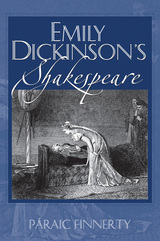 Emily Dickinson's Shakespeare
Paraic Finnerty
University of Massachusetts Press, 2006 One of the messages that Emily Dickinson wanted to communicate to the world was her great love of William Shakespeare—her letters abound with references to him and his works. This book explores the many implications of her admiration for the Bard.
Páraic Finnerty clarifies the essential role that Shakespeare had in Dickinson's life by locating her allusions to his writings within a nineteenth-century American context and by treating reading as a practice that is shaped, to a large extent, by culture. In the process, he throws new light on Shakespeare's multifaceted presence in Dickinson's world: in education, theater, newspapers, public lectures, reading clubs, and literary periodicals.
Through analysis of letters, journals, diaries, records, periodicals, newspapers, and marginalia, Finnerty juxtaposes Dickinson's engagement with Shakespeare with the responses of her contemporaries. Her Shakespeare emerges as an immoral dramatist and highly moral poet; a highbrow symbol of class and cultivation and a lowbrow popular entertainer; an impetus behind the emerging American theater criticism and an English author threatening American creativity; a writer culturally approved for women and yet one whose authority women often appropriated to critique their culture. Such a context allows the explication of Dickinson's specific references to Shakespeare and further conjecture about how she most likely read him.
Finnerty also examines those of Dickinson's responses to Shakespeare that deviated from what might have been expected and approved of by her culture. Imaginatively departing from the commonplace, Dickinson chose to admire three of Shakespeare's most powerful and transgressive female characters—Cleopatra, Queen Margaret, and Lady Macbeth—instead of his more worthy and virtuous heroines. More startling, although the poet found resonance for her own life in Hamlet, Romeo and Juliet, and Macbeth, she chose, in the racially charged atmosphere of nineteenth-century America, to identify with Shakespeare's most controversial character, Othello, thereby defying expectations once again.
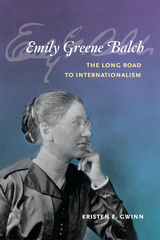 Emily Greene Balch: The Long Road to Internationalism
Kristen E. Gwinn
University of Illinois Press, 2010 A well-known American academic and cofounder of Boston's first settlement house, Emily Greene Balch was an important Progressive Era reformer and advocate for world peace. Balch served as a professor of economics and sociology at Wellesley College for twenty years until her opposition to World War I resulted with the board of trustees to refusing to renew her contract. Afterwards, Balch continued to emphasize the importance of international institutions for preventing and reconciling conflicts. She was awarded a Nobel Peace Prize in 1946 for her efforts in cofounding and leading the Women's International League for Peace and Freedom (WILPF). In tracing Balch's work at Wellesley, for the WILPF, and for other peace movements, Kristen E. Gwinn draws on a rich collection of primary sources such as letters, lectures, a draft of Balch's autobiography, and proceedings of the WILPF and other organizations in which Balch held leadership roles. Gwinn illuminates Balch's ideas on negotiated peace, internationalism, global citizenship, and diversity while providing pointed insight into her multifaceted career, philosophy, and temperament. Detailing Balch's academic research on Slavic immigration and her arguments for greater cultural and monetary cohesion in Europe, Gwinn shows how Balch's scholarship and teaching reflected her philosophical development. This first scholarly biography of Balch helps contextualize her activism while taking into consideration changes in American attitudes toward war and female intellectuals in the early twentieth century.
 Eminent Bostonians
Thomas H. O'Connor
Harvard University Press, 2002 The history of Boston is inseparable from the life stories of its people--from the Puritans and Native Americans of the seventeenth century to the civic leaders and celebrities of today. In Eminent Bostonians, Thomas H. O'Connor, the preeminent historian of Boston, offers a personal selection of entertaining and enlightening brief lives of notable residents of the city.
Eminent Bostonians includes some 130 figures of local and national significance from the arts, literature, religion, politics, science and medicine, business, education, and sports. Some would be on every list of prominent Bostonians, and some will come as a genuine surprise. As at a large dinner party, part of the fun is seeing who is seated next to whom: the fictional Proper Bostonian George Apley, a creation of John P. Marquand, followed by Anthony Athanas, the Albanian immigrant owner of Anthony's Pier 4 restaurant, followed by Crispus Attucks, a victim of the Boston Massacre in 1770. Or Lucy Stone, a pioneering feminist, next to Gilbert Stuart, the eighteenth-century portraitist, next to John L. Sullivan, the early-twentieth-century champion boxer. Or the Red Sox legend Ted Williams between Phillis Wheatley, an eighteenth-century African-American poet, and the Puritan founder John Winthrop.
And so it goes, from Abigail Adams to Leonard P. Zakim: a gallery of Brahmins and immigrants, workers and scholars, reformers and reactionaries, dreamers and schemers. Eminent Bostonians introduces longtime residents and newcomers alike to their neighbors--those who made Boston what it was and what it is today.
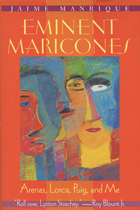 Eminent Maricones: Arenas, Lorca, Puig, and Me
Jaime Manrique
University of Wisconsin Press, 2001 Jaime Manrique weaves into his own memoir the lives of three important twentieth-century Hispanic writers: the Argentine Manuel Puig, author of Kiss of the Spider Woman; the Cuban Reinaldo Arenas, author of Before Night Falls; and Spanish poet and playwright Federico García Lorca. Manrique celebrates the lives of these heroic writers who were made outcasts for both their homosexuality and their politics.
"Manrique's double vision yields insights into Puig, Arenas, and Lorca unavailable to a writer less attuned to the complex interplay of culture and sexuality, as well as that of race and class in Latino and Anglo societies."—George DeStefano, The Nation
"A splendid memoir of Manuel Puig. It evokes him—how he really was—better than anything I've read."—Susan Sontag
"Where Manrique's tale differs from others is in its unabashed and sensitive treatment of sexuality. One reads his autobiographical account with pleasure and fascination."—Jose Quiroga, George Washington University
"Manrique's voice is wise, brave, and wholly original. This chronicle of self-discovery and literary encounters is heartening and deep."—Kennedy Fraser
"In this charmingly indiscreet memoir, Jaime Manrique writes with his customary humor and warm sympathy, engaging our delighted interest on every page. He has the rare gift of invoking and inviting intimacy, in this case a triangulated intimacy between himself, his readers, and his memories. These are rich double portraits."—Phillip Lopate
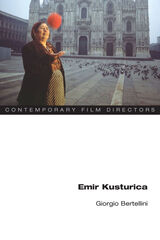 Emir Kusturica
Emir Kusturica
University of Illinois Press, 2015 Emir Kusturica is one of Eastern Europe's most celebrated and influential filmmakers. Over the course of a thirty-year career, Kusturica has navigated a series of geopolitical fault lines to produce subversive, playful, often satiric works. On the way he won acclaim and widespread popularity while showing a genius for adjusting his poetic pitch--shifting from romantic realist to controversial satirist to sentimental jester.
Leading scholar-critic Giorgio Bertellini divides Kusturica's career into three stages--dissention, disconnection, and dissonance--to reflect both the historic and cultural changes going on around him and the changes his cinema has undergone. He uses Kusturica's Palme d'Or winning Underground (1995)--the famously inflammatory take on Yugoslav history after World War II--as the pivot between the tone of romantic, yet pungent critique of the director's early works and later journeys into Balkanist farce marked by slapstick and a self-conscious primitivism.
Eschewing the one-sided polemics Kusturica's work often provokes, Bertellini employs balanced discussion and critical analysis to offer a fascinating and up-to-date consideration of a major figure in world cinema.
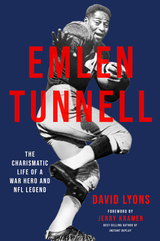 Emlen Tunnell: The Charismatic Life of a War Hero and NFL Legend
David Lyons
Temple University Press, 2024 The most successful Black football star of his era, and, in 1967, the first Black inductee to the Pro Football Hall of Fame, Emlen Tunnell is, sadly, almost forgotten now. A WWII hero who served with distinction in the Coast Guard, Tunnell followed his service with a groundbreaking career in the NFL. He held league records for interceptions, interception return yards, punt returns, and punt return yardage. In 1948, he broke the color barrier to become the first Black player on the New York Giants. He was later a player, coach, and scout for Vince Lombardi’s Green Bay Packers.
David Lyons’s poignant biography, Emlen Tunnell, chronicles this amazing athlete, nicknamed “the Gremlin” for his returns and aerial attacks that wreaked havoc reminiscent of the damage caused by phantom gremlins of WWII. Tunnell was also a game changer, revolutionizing his defensive position as a safety, making it as exciting as a running back.
While Tunnell encountered racism and discrimination on and off the gridiron, the gregarious athlete had a charm and charisma that was disarming. He often mentored teammates and introduced them to Black culture. After his stint in the NFL and until his death, Tunnell was an NFL scout and the first Black assistant coach for the Giants.
Emlen Tunnell thoroughly recounts the extraordinary life and career of this great athlete and does justice to his remarkable legacy.
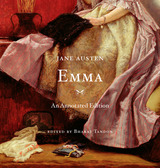 Emma: An Annotated Edition
Jane Austen
Harvard University Press, 2012 “Jane Austen lovers worldwide will cherish these books...Prepare yourself for a major treat.”
—Christian Science Monitor
Handsome, clever, and rich—just like Emma.
Emma is one of Jane Austen’s most beloved novels, and perhaps her most technically accomplished. It’s a timeless tale of friendship, self-discovery, and love. Inspiring countless adaptations for stage and screen, Emma is the story of a smart but superficial girl who finds her ultimate happiness through humility. If we loved this extraordinary edition less, we might be able to talk about it more.
For beginners and experts alike—immerse yourself in Jane Austen’s world: For the modern reader, our annotations provide clear explanations and illuminating context for period language and references. For the enthusiast, they offer fresh, exciting analysis—a passionate friend in the margins.
A work of art—the ideal gift: Perfect for gifting, collecting, and cherishing, this grand hardcover (9” x 9.5”) brims with hundreds of full-color illustrations that vividly recreate Austen’s world—its fashions, carriages, libraries, and estates.
The story: Emma Woodhouse is in no rush to find a husband. She’s “handsome, clever, and rich,” with “very little to distress or vex her,” and more than a little spoiled. Fancying herself a matchmaker, Emma insinuates herself into others’ lives, mostly ignorant of the risks. When her headstrong nature causes hurt to others, she is corrected by the older, down-to-earth Mr. Knightley. After weaving herself unwittingly into a number of love triangles, Emma is forced to confront her feelings for her only critic.
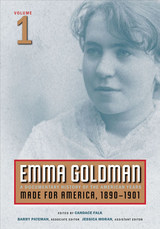 Emma Goldman: A Documentary History of the American Years, Volume 1: Made for America, 1890-1901
Emma Goldman. Edited by Candace Falk; Barry Pateman, Assoc Ed; Jessica Moran, A
University of Illinois Press, 2007 Emma Goldman: A Documentary History of the American Years reconstructs the life of Emma Goldman through significant texts and documents. These volumes collect personal letters, lecture notes, newspaper articles, court transcripts, government surveillance reports, and numerous other documents, many of which appear here in English for the first time. Supplemented with thorough annotations, multiple appendixes, and detailed chronologies, the texts bring to life the memory of this singular, pivotal figure in American and European radical history.
Volume 1: Made for America, 1890-1901 introduces readers to the young Emma Goldman as she begins her association with the international anarchist movement and especially with the German, Jewish, and Italian immigrant radicals in New York City. From early on, Goldman's movement through political and intellectual circles is marked by violence, from the attempted murder of industrialist Henry Clay Frick by Goldman's lover, Alexander Berkman, to the assassination of President William McKinley, in which Goldman was falsely implicated. The documents surrounding these events illuminate Goldman's struggle to balance anarchism's positive gains and its destructive costs. This volume introduces many of the themes that would pervade much of Goldman's later writings and speeches: the untold possibilities of anarchism; the transformative power of literature; the interplay of human relationships; and the importance of free speech, education, labor, women's freedom, and radical social reform.
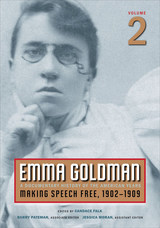 Emma Goldman, Vol. 2: A Documentary History of the American Years, Volume 2: Making Speech Free, 1902-1909
Emma Goldman. Edited by Candace Falk; Barry Pateman, Assoc Ed; Jessica Moran, As
University of Illinois Press, 2007 Emma Goldman: A Documentary History of the American Years reconstructs the life of Emma Goldman through significant texts and documents. These volumes collect personal letters, lecture notes, newspaper articles, court transcripts, government surveillance reports, and numerous other documents, many of which appear here in English for the first time. Supplemented with thorough annotations, multiple appendixes, and detailed chronologies, the texts bring to life the memory of this singular, pivotal figure in American and European radical history.
Volume 2: Making Speech Free, 1902-1909 extends many of the themes introduced in the previous volume, including Goldman's evolving attitudes toward political violence and social reform, intensified now by documentary accounts of the fomenting revolution in Russia and the legal opposition toward anarchism and labor organizing in the United States. Always an impassioned defender of free expression, Goldman's launch of her magazine Mother Earth in 1906 signaled a desire to bring radical thought into wider circulation, and its pages brought together modern literary and cultural ideas with a radical social agenda, quickly becoming a platform for her feminist critique, among her many other challenges to the status quo. With abundant examples from her writings and speeches, this volume details Goldman's emergence as one of American history's most fiercely outspoken opponents of hypocrisy and pretension in politics and public life.
Emma Lee
Juanita Brooks
Utah State University Press, 1975 Emma Lee is the classic biography of one of John D. Lee's plural wives. Emma experienced the best and worst of polygamy and came as near to the Mountain Meadows Massacre as anyone could without participating first hand.
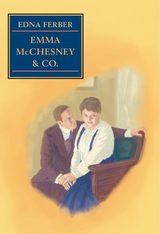 Emma McChesney and Co.
Edna Ferber
University of Illinois Press, 2002 Edna Ferber, the Pulitzer Prize-winning author of Show Boat and Giant, achieved her first great success with a series of stories featuring Emma McChesney: a smart, stylish, divorced mother who in a mere twelve years rose from stenographer to traveling sales representative to business manager and partner of the T. A. Buck Featherloom Petticoat Company.
In this final of three volumes chronicling the travels and trials of Emma McChesney, first published in 1915, Emma's son, Jock, has moved to Chicago with his new wife. Struggling with a newly emptied nest, Emma dives into a whirlwind South American sales tour to prove she hasn't lost her touch.
Back in New York, Emma and her business partner, T. A. Buck Jr., try to disguise their budding romance from colleagues. After months of acting like a "captain of finance when he feels like a Romeo," T. A. convinces Emma they should marry. Emma tries to "be what the yellow novels call a doll-wife" but trades in her fancy dressing gowns for more sensible business suits and heads back to the office.
With one hand writing advertising copy and the other wrapped around a pair of shears, Emma saves the company from financial peril amid the arrival of some flustering, if exciting, news from Jock. By turns sales pro, newlywed, fashion maven, and anxious grandmother, Emma symbolizes the ideal woman at the dawn of the twentieth century: sharp, capable, charming, and progressive. Emma McChesney and Co. is enhanced by the illustrations of James Montgomery Flagg, one of the most highly regarded book illustrators of the period.
Emmanuel Appadocca; or, Blighted Life: A Tale of the Boucaneers
Maxwell Philip
University of Massachusetts Press, 1997 This 1854 novel traces a mulatto son's quest for vengeance against his white father, a sugar planter who abandoned him and his mother. Intent on redeeming his mother's honor and outraged by the cruelty and greed that slavery has engendered Appodacca sails the seas with a band of ruthless pirates on a ship named the Black Schooner. The novel, written by the important activist and intellectual Michel Maxwell Philip (1829-1888) deals with themes, symbols, and literary techniques that are reminiscent of other major authors such as Melville, Douglass, and Stowe. This new edition with scholarly commentaries and annotations will reorient our understanding of the development of Caribbean literature in relation to English and American literary production.
 The Emmanuel Movement: The Origins of Group Treatment and the Assault on Lay Psychotherapy
Sanford Gifford
Harvard University Press “The Emmanuel Movement” was a name given by the contemporary press to a combined method of group and individual psychotherapy introduced in 1906 by the Rev. Elwood Worcester, Rector of the Emmanuel Church in Boston. This treatment method for the common neuroses, offered to the public free of charge and open to all social classes and religious denominations, was first welcomed with great popular acclaim but later ravaged by the widespread newspaper publicity it attracted. The movement continued its stormy existence for a decade beyond Worcester’s retirement in 1929. His successors applied his methods—including group treatment, the first to be employed in psychotherapy anywhere—to the treatment of alcoholics.
In The Emmanuel Movement, Sanford Gifford presents the definitive statement on this unique movement. He examines its position during a critical phase of American psychotherapy, and discusses the methods and personalities—both champions and detractors—associated with it.
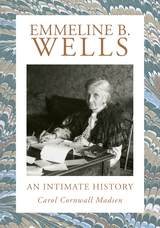 Emmeline B. Wells: An Intimate History
Carol Cornwall Madsen
University of Utah Press, 2016 Emmeline B. Wells was the most noted Utah Mormon woman of her time. Lauded nationally for her energetic support of the women’s rights movement of the nineteenth century, she was a self-made woman who channeled her lifelong sense of destiny into ambitious altruism. Her public acclaim and activism belied the introspective, self-appraising, and emotional persona she expressed in the pages of her forty-seven extant diaries. Yet she wrote, “I have risen triumphant,” after reconciling herself to the heartaches of plural marriage, and she pursued a self-directed life in earnest.
This new biography tells the story of the private Emmeline. The unusual circumstances of her marriages, the complicated lives of her five daughters, losses and disappointments interspersed with bright moments and achievements, all engendered the idea that her life was a romance, with all the mysterious, tragic, and sentimental elements of that genre. Her responses to that perception made it so. This volume, drawing heavily on Emmeline Wells’s own words, tells the complicated story of a woman of ambition, strength, tenderness, and faith.
Winner of the Mormon History Association's Best Biography Award.
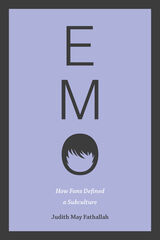 Emo: How Fans Defined a Subculture
Judith May Fathallah
University of Iowa Press, 2020 For many, the word “emo” calls to mind angsty teenagers, shaggy black haircuts, and skinny jeans. A popular music phenomenon in the early 2000s, emo is short for “emotional hardcore,” and refers to both a music genre and a youth scene notable for its androgynous style. Judith May Fathallah pushes beyond the stereotypes and social stigma to explore how online fandom has shaped the definition of emo, with significant implications both for millennial constructs of gender and for contemporary fan studies. First laying out the debate over what emo is, Fathallah walks superfans and newcomers through the culture surrounding thegenre’s major bands, including the emo holy trinity: My Chemical Romance, Fall Out Boy, and Panic! At the Disco. Next she examines fans’ main mode of participation in the emo subculture—online communities such as LiveJournal, Tumblr, MySpace, and band websites. Taking a hard look at the gender politics that dominated those spaces, she unearths a subculture that simultaneously defines itself by its sensitivity and resistance to traditional forms of masculinity, yet ruthlessly enforces homophobic and sexist standards. Fathallah demonstrates fandom’s key role in defining emo as a concept and genre after 2001, with probing insight into its implications for gender constructions through popular music.
Emoticoncert
Maya Pindyck
Four Way Books, 2016 Emoticoncert follows intensities and absences across different bodies and scales. Broken up into musical “movements,” each section serves as its own composition. As a whole, the book works as a concert of intensities associated with loss, nationalism, and the slippery boundary between human and animal. Moving across both real and dreamed terrains, Emoticoncert is a dislocated kind of traveling linked by a sense of musicality and a desire to record the intensities that arise in the author’s entanglements with things both present and gone.
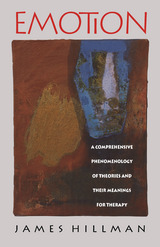 Emotion: A Comprehensive Phenomenology of Theories and Their Meanings for Therapy
James Hillman
Northwestern University Press, 1962 What is the meaning of strong emotions? What is emotion itself? What is really happening in therapy when people "express their emotions?"
As James Hillman writes in his new preface to this sweeping study, he intends nothing less than "to vitalize a standard topic of academic psychology by making the theory of emotion as crucial as is emotion itself in our lives." Hillman offers an informative and readable survey of a range of theories of emotion, focusing on the twentieth century but moving also from Greek thought to early Christianity to nineteenth-century German physiology. The work challenges readers to rethink our concepts and thereby to re-experience emotional phenomena.
Hillman's study contributes to today's renewed interest in the history of the body. Furthermore, his understanding of emotions in terms of epiphany makes a stimulating contribution to phenomenology. It is equally thought-provoking for the therapist, the philosopher, the intellectual historian, and the general reader.
Emotion and Devotion: The Meaning of Mary in Medieval Religious Cultures
Miri Rubin
Central European University Press, 2009 In Emotion and Devotion Miri Rubin explores the craft of the historian through a series of studies of medieval religious cultures. In three original chapters she approaches the medieval figure of the Virgin Mary with the aim of unravelling meaning and experience. Hymns and miracle tales, altarpieces and sermons – a wide range of sources from many European regions – are made to reveal the creativity and richness which they elicited in medieval people, women and men, clergy and laity, people of status and riches as well as those of modest means.
Emotion and Focus
Helen Nissenbaum
CSLI, 1985 The author's aim to discover the conception of emotion that is couched in a commonsense view of the world and is reflected in ordinary discourse.
Emotion and Meaning in Music
Leonard B. Meyer
University of Chicago Press, 1961 "Altogether it is a book that should be required reading for any student of music, be he composer, performer, or theorist. It clears the air of many confused notions . . . and lays the groundwork for exhaustive study of the basic problem of music theory and aesthetics, the relationship between pattern and meaning."—David Kraehenbuehl, Journal of Music Theory "This is the best study of its kind to have come to the attention of this reviewer."—Jules Wolffers, The Christian Science Monitor
"It is not too much to say that his approach provides a basis for the meaningful discussion of emotion and meaning in all art."—David P. McAllester, American Anthropologist
"A book which should be read by all who want deeper insights into music listening, performing, and composing."—Marcus G. Raskin, Chicago Review
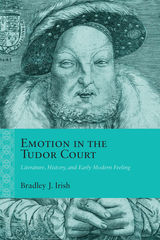 Emotion in the Tudor Court: Literature, History, and Early Modern Feeling
Bradley J. Irish
Northwestern University Press, 2018 Deploying literary analysis, theories of emotion from the sciences and humanities, and an archival account of Tudor history, Emotion in the Tudor Court examines how literature both reflects and constructs the emotional dynamics of life in the Renaissance court. In it, Bradley J. Irish argues that emotionality is a foundational framework through which historical subjects embody and engage their world, and thus can serve as a fundamental lens of social and textual analysis.
Spanning the sixteenth century, Emotion in the Tudor Court explores Cardinal Thomas Wolsey and Henrician satire; Henry Howard, Earl of Surrey, and elegy; Sir Philip Sidney and Elizabethan pageantry; and Robert Devereux, Earl of Essex, and factional literature. It demonstrates how the dynamics of disgust,envy, rejection, and dread, as they are understood in the modern affective sciences, can be seen to guide literary production in the early modern court.
By combining Renaissance concepts of emotion with modern research in the social and natural sciences, Emotion in the Tudor Court takes a transdisciplinary approach to yield fascinating and robust ways to illuminate both literary studies and cultural history.
Emotional and Priestly Logic of Plural Marriage, The
Kathleen Flake
Utah State University Press, 2010 Kathleen Flake, associate professor of American religious history at Vanderbilt University examines the logic of those women who thrived, rather than suffered, in early Mormon polygamy, and finds that the marriage covenant granted them priestly rights and independence through the powers of heaven.
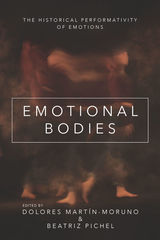 Emotional Bodies: The Historical Performativity of Emotions
Edited by Dolores Martín Moruno and Beatriz Pichel
University of Illinois Press, 2019 What do emotions actually do? Recent work in the history of emotions and its intersections with cultural studies and new materialism has produced groundbreaking revelations around this fundamental question. In Emotional Bodies, contributors pick up these threads of inquiry to propose a much-needed theoretical framework for further study of materiality of emotions, with an emphasis on emotions' performative nature. Drawing on diverse sources and wide-ranging theoretical approaches, they illuminate how various persons and groups—patients, criminals, medieval religious communities, revolutionary crowds, and humanitarian agencies—perform emotional practices. A section devoted to medical history examines individual bodies while a section on social and political histories studies the emergence of collective bodies. Contributors: Jon Arrizabalaga, Rob Boddice, Leticia Fernández-Fontecha, Emma Hutchison, Dolores Martín-Moruno, Piroska Nagy, Beatriz Pichel, María Rosón, Pilar León-Sanz, Bertrand Taithe, and Gian Marco Vidor.
Emotional Decisions: Trade off Difficulty and Coping in Consumer Choice
Mary Frances Luce, James R. Bettman, and John W. Payne
University of Chicago Press, 2001 Decision-making can be difficult and often results in necessary trade-offs, e.g., safety versus price in the purchasing of an automobile. This work provides a model of trade-off difficulty, focusing on its antecedents and consequences. The authors advance a new framework for the integration of the emotional and cognitive aspects of decision-making and argue that consumers perceive and appraise their choices in light of their goals and potential coping strategies.
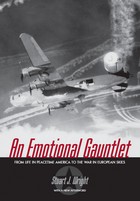 An Emotional Gauntlet: From Life in Peacetime America to the War in European Skies
Stuart J. Wright
University of Wisconsin Press, 2008 Stuart J. Wright tells the gripping story of a World War II American aircrew flying missions from England in a B-24 Liberator bomber they nicknamed Corky. This is a true account based on years of research and correspondence with crewmembers and their families. Wright adds a dimension rarely explored in other World War II memoirs and narratives, beginning the chronicle during peacetime when the men of the aircrew are introduced as civilians-kids during the 1920s. As they mature through the years of the Great Depression to face a world at war, questions are raised about "just" and "unjust" wars, imperialism, and patriotism. Jingoistic sentimentality is resisted in favor of objectivity, as the feelings and motivations of the crewmembers are explored: the Chinese American air gunner had hoped to serve in the U.S. Army Air Force to fight against the Japanese invaders of his homeland; the Jewish navigator felt compelled to join the battle against Nazi Germany.
In recounting the harrowing conditions and horrors of bombing missions over Europe, An Emotional Gauntlet emphasizes the interpersonal relationships within the crew and the spirit these men shared. Corky's crew served under Operations Officer Major James Stewart (the Hollywood movie star.) They often returned from arduous bombing missions to sleep in half-empty huts—their friends in other planes had not been so lucky. Pilot Jack Nortridge regularly assured his crew, "If you fly with me, I'm going to bring you home." This book is a testament to their strength and determination.
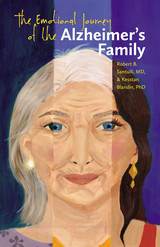 The Emotional Journey of the Alzheimer's Family
Robert B. Santulli and Kesstan Blandin
Dartmouth College Press, 2015 Alzheimer’s disease is a growing public health crisis. According to the Alzheimer’s Association, there are 5.4 million victims of this disease; by 2050, there will be close to 15 million people who suffer from this debilitating disorder of memory, thinking, personality, and functioning. The disease profoundly affects immediate family members, close friends, and neighbors. These people—the Alzheimer’s family—undergo tremendous psychological and emotional change as they witness the cruel and relentless progression of the disease in their loved one. Incorporating over thirty years of experience with Alzheimer’s patients and their families with current medical knowledge, the authors chart the complex emotional journey of the Alzheimer’s family from the onset of the disease through the death of the loved one. They discuss the anger that rises in the face of discordant views of the disease, the defenses that emerge when family members are unwilling to accept a dementia diagnosis, and the common emotions of anxiety, guilt, anger, and shame. They focus especially on grief as the core response to losing a loved one to dementia, and describe the difficult processes of adaptation and acceptance, which lead to personal growth. Final chapters emphasize the importance of establishing a care community and how to understand and cope with personal stress. This volume will be useful to medical professionals and ordinary people close to or caring for a person with dementia.
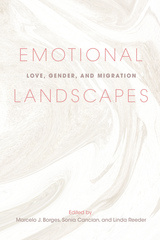 Emotional Landscapes: Love, Gender, and Migration
Edited by Marcelo J. Borges, Sonia Cancian, and Linda Reeder
University of Illinois Press, 2020 Love and its attendant emotions not only spur migration—they forge our response to the people who leave their homes in search of new lives. Emotional Landscapes looks at the power of love, and the words we use to express it, to explore the immigration experience. The authors focus on intimate emotional language and how languages of love shape the ways human beings migrate but also create meaning for migrants, their families, and their societies. Looking at sources ranging from letters of Portuguese immigrants in the 1880s to tweets passed among immigrant families in today's Italy, the essays explore the sentimental, sexual, and political meanings of love. The authors also look at how immigrants and those around them use love to justify separation and loss, and how love influences us to privilege certain immigrants—wives, children, lovers, refugees—over others.
Affecting and perceptive, Emotional Landscapes moves from war and transnational families to gender and citizenship to explore the crossroads of migration and the history of emotion.
Contributors: María Bjerg, Marcelo J. Borges, Sonia Cancian, Tyler Carrington, Margarita Dounia, Alexander Freund, Donna R. Gabaccia, A. James Hammerton, Mirjam Milharčič Hladnik, Emily Pope-Obeda, Linda Reeder, Roberta Ricucci, Suzanne M. Sinke, and Elizabeth Zanoni
The Emotional Life of Contemporary Public Memorials: Towards a Theory of Temporary Memorials
Erika Doss
Amsterdam University Press, 2008
From the commemoration of September 11 to the Holocaust memorial in Berlin to the 2004 unveiling of the National World War II Memorial in Washington D.C., recent decades have witnessed a substantial increase in the number of new public memorials built in both Europe and the United States. This volume considers the contemporary explosion of public commemoration in terms of changed cultural and social practices of mourning, memory, and public feeling. Positing memorials as the physical and visual embodiment of our affective responses to loss, Erika Doss focuses especially on the memorial ephemera of flowers, candles, balloons, and cards placed at sites of tragic death in order to better comprehend how grief is mediated in contemporary commemorative cultures.
 The Emotional Mind: The Affective Roots of Culture and Cognition
Stephen T. Asma and Rami Gabriel
Harvard University Press, 2019 Tracing the leading role of emotions in the evolution of the mind, a philosopher and a psychologist pair up to reveal how thought and culture owe less to our faculty for reason than to our capacity to feel.
Many accounts of the human mind concentrate on the brain’s computational power. Yet, in evolutionary terms, rational cognition emerged only the day before yesterday. For nearly 200 million years before humans developed a capacity to reason, the emotional centers of the brain were hard at work. If we want to properly understand the evolution of the mind, we must explore this more primal capability that we share with other animals: the power to feel.
Emotions saturate every thought and perception with the weight of feelings. The Emotional Mind reveals that many of the distinctive behaviors and social structures of our species are best discerned through the lens of emotions. Even the roots of so much that makes us uniquely human—art, mythology, religion—can be traced to feelings of caring, longing, fear, loneliness, awe, rage, lust, playfulness, and more.
From prehistoric cave art to the songs of Hank Williams, Stephen T. Asma and Rami Gabriel explore how the evolution of the emotional mind stimulated our species’ cultural expression in all its rich variety. Bringing together insights and data from philosophy, biology, anthropology, neuroscience, and psychology, The Emotional Mind offers a new paradigm for understanding what it is that makes us so unique.
The Emotional Politics of Social Work and Child Protection
Joanne Warner
Bristol University Press, 2015 Social work and child protection systems have for several decades been subject to cycles of crisis and reform, with each crisis drawing intense media and political scrutiny. In this book, Joanne Warner argues that to understand the nature of these cycles, we have to pay attention to the importance of collective emotions such as anger, shame, and fear. To do so, she introduces the concept of emotional politics. Using a range of cases from the United Kingdom, the United States, the Netherlands, and New Zealand, Warner reveals that collective emotions are central to constructions of risk and blame—and that they are generated and reflected by official documents, politicians, and the media. She also suggests strategies for challenging emotional politics, including identifying models for a more politically engaged stance for the social work profession.
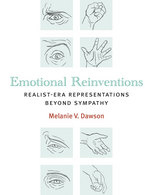 Emotional Reinventions: Realist-Era Representations Beyond Sympathy
Melanie V. Dawson
University of Michigan Press, 2015 Focusing on representational approaches to emotion during the years of American literary realism’s dominance and in the works of such authors as Edith Wharton, Alice Dunbar-Nelson, W. D. Howells, Charles Chesnutt, and others, Emotional Reinventions: Realist-Era Representations Beyond Sympathy contends that emotional representations were central to the self-conscious construction of high realism (in the mid-1880s) and to the interrogation of its boundaries. Based on realist-era authors’ rejection of “sentimentalism” and its reduction of emotional diversity (a tendency to stress what Karen Sanchez-Eppler has described as sentimental fiction’s investment in “overcoming difference”), Melanie Dawson argues that realist-era investments in emotional detail were designed to confront differences of class, gender, race, and circumstance directly. She explores the ways in which representational practices that approximate scientific methods often led away from scientific theories and rejected rigid attempts at creating emotional taxonomies. She argues that ultimately realist-era authors demonstrated a new investment in individuated emotional histories and experiences that sought to honor all affective experiences on their own terms.
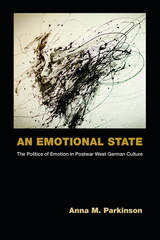 An Emotional State: The Politics of Emotion in Postwar West German Culture
Anna M. Parkinson
University of Michigan Press, 2015 This literary-historical study seeks to dismantle the prevailing notion that Germany, in the period following the Second World War, exhibited an “inability to mourn,” arguing that in fact this period experienced a surge of affect. Anna Parkinson examines the emotions explicitly manifested or addressed in a variety of German cultural artifacts, while also identifying previously unacknowledged (and undertheorized) affective structures implicitly at work during the country’s national crisis. Much of the scholarship in the expanding field of affect theory distrusts Freudian psychoanalysis, which does not differentiate between emotion and affect.
One of the book’s major contributions is that it offers an analytical distinction between emotion and affect, finding a compelling way to talk about affect and emotion that is informed by affect theory but that integrates psychoanalysis. The study draws on the psychoanalytic writings of Freud, Margarete and Alexander Mitscherlich, and André Green, while engaging with interdisciplinary theorists of affect including Barbara Rosenwein, Lauren Berlant, Ann Cvetkovich, and Eve Kosofsky Sedgwick among many others.
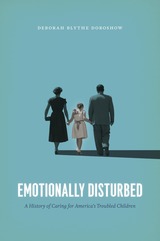 Emotionally Disturbed: A History of Caring for America's Troubled Children
Deborah Blythe Doroshow
University of Chicago Press, 2019 Before the 1940s, children in the United States with severe emotional difficulties would have had few options for care. The first option was usually a child guidance clinic within the community, but they might also have been placed in a state mental hospital or asylum, an institution for the so-called feebleminded, or a training school for delinquent children. Starting in the 1930s, however, more specialized institutions began to open all over the country. Staff members at these residential treatment centers shared a commitment to helping children who could not be managed at home. They adopted an integrated approach to treatment, employing talk therapy, schooling, and other activities in the context of a therapeutic environment.
Emotionally Disturbed is the first work to examine not only the history of residential treatment but also the history of seriously mentally ill children in the United States. As residential treatment centers emerged as new spaces with a fresh therapeutic perspective, a new kind of person became visible—the emotionally disturbed child. Residential treatment centers and the people who worked there built physical and conceptual structures that identified a population of children who were alike in distinctive ways. Emotional disturbance became a diagnosis, a policy problem, and a statement about the troubled state of postwar society. But in the late twentieth century, Americans went from pouring private and public funds into the care of troubled children to abandoning them almost completely. Charting the decline of residential treatment centers in favor of domestic care–based models in the 1980s and 1990s, this history is a must-read for those wishing to understand how our current child mental health system came to be.
Emotions at Work: Normative Control, Organizations, and Culture in Japan and America
Aviad E. Raz
Harvard University Press, 2002 Our work life is filled with emotions. How we feel on the job, what we say we feel, and what feelings we display—all these are important aspects of organizational behavior and workplace culture. Rather than focusing on the psychology of personal emotions at work, however, this study concentrates on emotions as role requirements, on workplace emotions that combine the private with the public, the personal with the social, and the authentic with the masked. In this cross-cultural study of "emotion management," the author argues that even though the goals of normative control in factories, offices, and shops may be similar across cultures, organizational structure and the surrounding culture affect how that control is discussed and conceived.
Emotions in History – Lost and Found
Ute Frevert
Central European University Press, 2011 Coming to terms with emotions and how they influence human behaviour, seems to be of the utmost importance to societies that are obsessed with everything "neuro." On the other hand, emotions have become an object of constant individual and social manipulation since "emotional intelligence" emerged as a buzzword of our times. Reflecting on this burgeoning interest in human emotions makes one think of how this interest developed and what fuelled it. From a historian's point of view, it can be traced back to classical antiquity. But it has undergone shifts and changes which can in turn shed light on social concepts of the self and its relation to other human beings (and nature). The volume focuses on the historicity of emotions and explores the processes that brought them to the fore of public interest and debate.
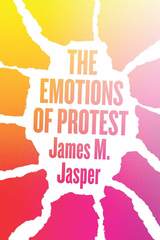 The Emotions of Protest
James M. Jasper
University of Chicago Press, 2018 In Donald Trump’s America, protesting has roared back into fashion. The Women’s March, held the day after Trump’s inauguration, may have been the largest in American history, and resonated around the world. Between Trump’s tweets and the march’s popularity, it is clear that displays of anger dominate American politics once again.
There is an extensive body of research on protest, but the focus has mostly been on the calculating brain—a byproduct of structuralism and cognitive studies—and less on the feeling brain. James M. Jasper’s work changes that, as he pushes the boundaries of our present understanding of the social world. In The Emotions of Protest, Jasper lays out his argument, showing that it is impossible to separate cognition and emotion. At a minimum, he says, we cannot understand the Tea Party or Occupy Wall Street or pro- and anti-Trump rallies without first studying the fears and anger, moral outrage, and patterns of hate and love that their members feel.
This is a book centered on protest, but Jasper also points toward broader paths of inquiry that have the power to transform the way social scientists picture social life and action. Through emotions, he says, we are embedded in a variety of environmental, bodily, social, moral, and temporal contexts, as we feel our way both consciously and unconsciously toward some things and away from others. Politics and collective action have always been a kind of laboratory for working out models of human action more generally, and emotions are no exception. Both hearts and minds rely on the same feelings racing through our central nervous systems. Protestors have emotions, like everyone else, but theirs are thinking hearts, not bleeding hearts. Brains can feel, and hearts can think.
Emotions, Passions, and Power in Renaissance Italy
Fabrizio Ricciardelli
Amsterdam University Press, 2015 Emotions depend on language, cultural practices, expectation and moral beliefs. Hate, fear, cruelty and love are always turning history into the history of passion and lust, because emotional life is always ready to overflow intellectual life. This fascinating study of emotion in Renaissance Italy shows that emotions are built and created by the society in which they are expressed and conditioned. The contributors examine, among others, the emotional language of the court, around public execution, religious practices and during outbreaks of disease.
 Empathic Design: Perspectives on Creating Inclusive Spaces
Edited by Elgin Cleckley
Island Press, 2024 How do you experience a public space? Do you feel safe? Seen? Represented? The response to these questions may differ based on factors including your race, age, ethnicity, or gender identity. In the architecture and design professions, decisions about the articulation of public spaces and who may be honored in them have often been made by white men. How do designers rethink design processes to produce works that hold space for the diversity of people using them?
In Empathic Design, designer and architecture professor Elgin Cleckley brings together leaders and visionary practitioners in architecture, urban design, planning, and design activism to help explore these questions. Cleckley explains that empathic designers need to approach design as iterative, changing, and shifting to say, “we see you”, “we hear you”. Part of an emerging design framework, empathic designers work with and in the communities affected. They acknowledge the full history of a place and approach the lived experience and memories of those in the community with respect.
Early chapters explore broader conceptual approaches, proposing definitions of empathy in the context of design, disrupting colonial narratives, and making space for grief. Other chapters highlight specific design projects, including the Harriet Tubman Memorial in Newark, The Camp Barker Memorial in Washington, D.C., the Freedom Center in Oklahoma City, and the Charlottesville Memorial for Peace and Justice.
Empathic Design provides essential approaches and methods from multiple perspectives, meeting the needs of our time and holding space for readers to find themselves.
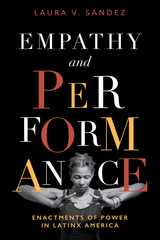 Empathy and Performance: Enactments of Power in Latinx America
Laura V. Sández
Vanderbilt University Press, 2024 Empathy and Performance advances a study of empathy and enactments of power by examining works from author-actors whose performances explore the boundaries between two kinship positions. Author Laura V. Sández studies the dramatized dilemma of cultural understanding in “Our America,” a notion that refers first to a collective political identity marking a common belonging in the Spanish-speaking America but also alludes to current struggles in the contemporary US. This book sees empathy as an affective response grounded in subjectivity and kinship. Sández argues that to conceptualize empathy one needs to understand how subjects organize, classify, and limit themselves, not only as agents, but also as interpreters. What sort of affiliations do these performances promote? How do they break, reinforce, or queer societal expectations about the Latinx body, the white body, or simply, the staged body?
To survey different answers to these queries, Sández studies Indigurrito (Nao Bustamante); Dominicanish (Josefina Báez); ¡Bienvenidos Blancos! or Welcome White People! (Alex Torra); the apology delivered by the group Veterans Stand with Standing Rock during protests against the Dakota Access Pipeline; and Kukuli Velarde’s body of work, from We, the Colonized Ones to A Mi Vida. In these artistic enactments, which range from 1992 to 2021, the historical construct of boundaries and bodies becomes evident. Following recent work on empathy by Lanzoni, Maibom, Calloway-Thomas, Bloom, Hogan, and Matravers, among others, Sández examines in-group/out-group divisions, the establishment of identity categories through performance, and the exploration of subaltern identities.
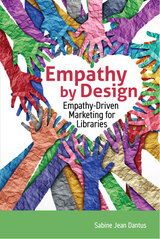 Empathy by Design: Empathy-Driven Marketing for Libraries
Sabine Jean Dantus
Association of College & Research Libraries, 2024 The library is a universal resource where knowledge and information meet. To advertise this resource and advance equal access in positive ways, libraries must develop strategies, campaigns, and messages that show they care about the lives of their diverse communities.
Empathy by Design: Empathy-Driven Marketing for Libraries offers step-by-step strategies for understanding why people visit the library and tailoring your marketing with personalization that resonates with users on a deeper level. It provides real-world solutions for understanding your target audience through empathy and demonstrates how to gather and use data to develop messages and programming that fosters meaningful connections and engagement. You’ll find ideas for understanding the customer journey, creating an empathic library brand, and creating empathy-driven marketing strategies, campaigns, content, and tactics.
Today’s library marketers should both understand the effectiveness of using empathy in marketing and use it as a radical tool for advancing our profession’s values of diversity, equity, inclusion, and access. The strategies outlined in Empathy by Design can give you the tools you need to make your marketing—and your library—more targeted and empathic.
 The Emperor
Makenzy Orcel
Seagull Books, 2024 A tragicomic novel that explores deep-seated tensions and social violence in Haiti.
After committing an irreparable crime, the narrator of The Emperor waits in his bedroom for the police to arrest him. His past reverberates inside of him like a drum: his youth spent in captivity as a zonbi, under the control of a charlatan Vodou leader, and many an alienating dawn delivering the daily newspaper through the cutthroat neighborhoods of Port-au-Prince, Haiti. He now has blood on his hands because of the woman on the bus—the only woman he had ever loved.
Part crime fiction, part fable gone awry, The Emperor invites readers to follow the narrator’s life as he moves from the Haitian countryside to the sprawling city, learning about the corruptible nature of power in his quest for freedom. Along the way, Makenzy Orcel blends the marvelous with the real by introducing readers to an unforgettable cast of characters including the Very Old Sheep, a deceitful Emperor, and the narrator’s so-called Enlightened Colleague. Written with Orcel’s distinctive verve, this novel offers readers a story set in contemporary Haiti that is rich in poetry and full of narrative intrigue.
 Emperor and Aristocracy in Japan, 1467–1680: Resilience and Renewal
Lee Butler
Harvard University Press, 2002 An institution in decline, possessing little power in an age dominated by warriors? Or a still-potent symbol of social and political legitimacy? Emperor and Aristocracy in Japan traces the fate of the imperial Japanese court from its lowest point during the turbulent, century-long sengoku, when the old society, built upon the strength and influence of the court, the priesthood, and a narrow warrior elite, was shaken to its foundations, to the Tokugawa era, when court culture displayed renewed vitality, and tea gatherings, flower arranging, and architecture flourished.
In determining how the court managed to persist and survive, Butler looks into contemporary documents, diaries, and letters to reveal the court's internal politics and protocols, hierarchies, finances, and ceremonial observances. Emperor and courtiers adjusted to the prominence of the warrior elite, even as they held on to the ideological advantages bestowed by birth, tradition, and culture. To this historical precedent the new wielders of power paid dutiful homage, ever mindful that ranks and titles, as well as the political blessing of the emperor, were advantageous marks of distinction.
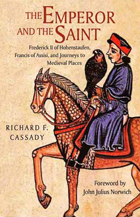 The Emperor and the Saint: Frederick II of Hohenstaufen, Francis of Assisi, and Journeys to Medieval Places
Richard F. Cassady
Northern Illinois University Press, 2011
The Emperor and the Saint is a vivid place-by-place telling of the life and times of the most enlightened, creative, and dynamic ruler of Medieval Europe, Frederick II of Hohenstaufen. St. Francis, who shared with Frederick a love of the natural world and was baptized in the same cathedral in Assisi, is a parallel and contrasting presence. Cassady enthusiastically guides the reader through the history and legends, pausing to describe the architecture of a cathedral, to marvel at the atmosphere of a town, to recommend the best place for a quiet picnic of local fare.
Frederick’s mother, Constance, was the daughter of the Norman Sicilian king, Roger II; Frederick’s father, Henry VI, was the scion of the German imperial family, son of the Holy Roman Emperor Frederick Barbarossa. When three-year-old Frederick was orphaned in 1198 he came under the guardianship of Pope Innocent III, marking the beginning of a conflict with the Papacy that was to last for the rest of his life—he was excommunicated twice. As a young boy he wandered freely through the streets of Palermo, a crossroad of Eastern and Western cultures. A man of insatiable curiosity, Frederick spent hours developing his knowledge of science and religion, art and philosophy. He traveled the length and breadth of Europe, even going to the Holy Land where, as commander of a Crusade, he negotiated a treaty with Sultan al-Kamil of Egypt, nephew of the great Saladin. Both respected and reviled, Frederick achieved great heights and faced grave disappointments. One failure was his dream to bring Italy and Sicily together in a united empire with a capital at Rome. When Frederick died in December 1250, he was robed in the white habit of a Cistercian monk to demonstrate his connection to both personal/political and religious worlds.
This engaging book is richly illustrated with photographs. Armchair historians, general readers of popular biography, and fans of travel literature will delight in Cassady’s lively presentation.
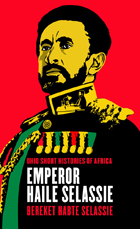 Emperor Haile Selassie
Bereket Habte Selassie
Ohio University Press, 2014 Emperor Haile Selassie was an iconic figure of the twentieth century, a progressive monarch who ruled Ethiopia from 1916 to 1974. This book, written by a former state official who served in a number of important positions in Selassie’s government, tells both the story of the emperor’s life and the story of modern Ethiopia. After a struggle for the throne in 1916, the young Selassie emerged first as regent and then as supreme leader of Ethiopia. Over the course of his nearly six-decade rule, the emperor abolished slavery, introduced constitutional reform, and expanded educational opportunity. The Italian invasion of Ethiopia in the 1930s led to a five-year exile in England, from which he returned in time to lead his country through World War II. Selassie was also instrumental in the founding of the Organization of African Unity in 1963, but he fell short of the ultimate goal of a promised democracy in Ethiopia. The corruption that grew under his absolute rule, as well as his seeming indifference to the famine that gripped Ethiopia in the 1970s, led finally to his overthrow by the armed forces that he had created. Haile Selassie was an enlightened monarch in many ways, but also a man with flaws like any other. This short biography is a sensitive portrayal of Selassie as both emperor and man, by one who knew him well.
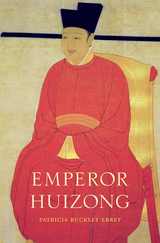 Emperor Huizong
Patricia Buckley Ebrey
Harvard University Press, 2014 China was the most advanced country in the world when Huizong ascended the throne in 1100 CE. In his eventful twenty-six year reign, the artistically-gifted emperor guided the Song Dynasty toward cultural greatness. Yet Huizong would be known to posterity as a political failure who lost the throne to Jurchen invaders and died their prisoner. The first comprehensive English-language biography of this important monarch, Emperor Huizong is a nuanced portrait that corrects the prevailing view of Huizong as decadent and negligent. Patricia Ebrey recasts him as a ruler genuinely ambitious—if too much so—in pursuing glory for his flourishing realm.
After a rocky start trying to overcome political animosities at court, Huizong turned his attention to the good he could do. He greatly expanded the court’s charitable ventures, founding schools, hospitals, orphanages, and paupers’ cemeteries. An accomplished artist, he surrounded himself with outstanding poets, painters, and musicians and built palaces, temples, and gardens of unsurpassed splendor. What is often overlooked, Ebrey points out, is the importance of religious Daoism in Huizong’s understanding of his role. He treated Daoist spiritual masters with great deference, wrote scriptural commentaries, and urged his subjects to adopt his beliefs and practices. This devotion to the Daoist vision of sacred kingship eventually alienated the Confucian mainstream and compromised his ability to govern.
Readers will welcome this lively biography, which adds new dimensions to our understanding of a passionate and paradoxical ruler who, so many centuries later, continues to inspire both admiration and disapproval.
Emperor Huizong and Late Northern Song China: The Politics of Culture and the Culture of Politics
Patricia Buckley Ebrey
Harvard University Press, 2006 Huizong was an exceptional emperor who lived through momentous times. A man of many talents, he wrote poetry and created his own distinctive calligraphy style; collected paintings, calligraphies, and antiquities on a large scale; promoted Daoism; and involved himself in the training of court artists, the layout of gardens, and reforms of music and medicine. The quarter century when Huizong ruled is just as fascinating. The greatly enlarged scholar-official class had come into its own but was deeply divided by factional strife. The long struggle between the Chinese state and its northern neighbors entered a new phase when Song proved unable to defend itself against the newly emergent Jurchen state of Jin. Huizong and thousands of members of his family and court were taken captive, and the Song dynasty had to recreate itself in the South.
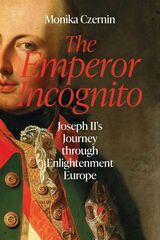 The Emperor Incognito: Joseph II's Journey through Enlightenment Europe
Monika Czernin
Haus Publishing, 2026 An emperor meets his people: the extraordinary journeys of Joseph II.
It is the end of the eighteenth century, and the European royal houses are beginning to falter. The young Habsburg emperor Joseph II realizes that reform is inevitable, and he eagerly soaks up Enlightenment ideas. Incognito, and without the usual pomp and entourage, he travels through his vast empire to see with his own eyes how his subjects live, suffer, and starve.
Along with princes and kings, he meets ordinary people and visits hospitals and factories in his search for new insights that will help him build a modern state. When he visits his sister Marie Antoinette in Versailles, he can see the French Revolution looming on the horizon. By the end of his journey, he had spent a quarter of his twenty-five-year reign on the road. With an introduction by Dominic Lieven and based on countless sources, Monika Czernin’s The Emperor Travels Incognito tells the story of an extraordinary man in an age of great upheaval, who was far ahead of his time.
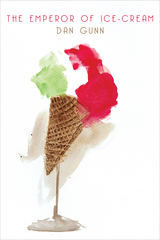 The Emperor of Ice-Cream
Dan Gunn
Seagull Books, 2014 In The Emperor of Ice-Cream, we are introduced to Lucia. Now in her eighties, this daughter of Italian immigrants looks back on her youth spent in Scotland during the 1920s and 30s. She remembers her three brothers, Dario, Giulio and Emilio, and the very different ways they lived through these decades: the eldest establishes the Edinburgh Fascist club, the second sets up a luxurious ice-cream parlor, the youngest hones his verbal skills for a future as a poet. Lucia learns what it is to be an immigrant and to wonder where ‘home’ is; she encounters religious sectarianism, idealism, and disillusionment. She experiences passion, hope, and disappointment.
When she falls in love in Rome, it appears that happiness is Lucia’s for the asking, until unstoppable forces intervene—in both of her countries. With mounting tension, her tale leads through the rise of Fascism to the terrible moment in June 1940 when Mussolini declares war, and British Italians are interned. When hundreds are herded as ‘enemy aliens’ onto a ship bound for exile, among their number are two of her brothers. Determined to tell their story before it is too late, Lucia gives an account of one of the most shameful episodes in Britain’s Second World War.
Through his portrayal of Lucia’s singular vision and voice, Dan Gunn has created an unforgettable character who, while registering the buffets of history, is—just possibly—writing herself toward some overdue inner peace.
The Emperor Redressed: Critiquing Critical Theory
Dwight Eddins
University of Alabama Press, 1995 There have been signs now, for some time, that poststructuralist hegemony is declining. This book helps us to understand the theoretical flaws that make this decline inevitable.
The essays in this volume represent a collective questioning of the poststructuralist ascendancy, and of the assumptions involved therin, by a group of our most prominent scholars. These scholars were charged with examining the truth-value, methodology, practice, and humanistic status of poststructuralist theories and with speculating on what their conclusions portend for the future of theory. They provide cogent evidence that the poststructuralist heyday has passed.
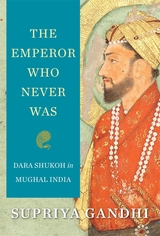 The Emperor Who Never Was: Dara Shukoh in Mughal India
Supriya Gandhi
Harvard University Press, 2019 The definitive biography of the eldest son of Emperor Shah Jahan, whose death at the hands of his younger brother Aurangzeb changed the course of South Asian history.
Dara Shukoh was the eldest son of Shah Jahan, the fifth Mughal emperor, best known for commissioning the Taj Mahal as a mausoleum for his beloved wife Mumtaz Mahal. Although the Mughals did not practice primogeniture, Dara, a Sufi who studied Hindu thought, was the presumed heir to the throne and prepared himself to be India’s next ruler. In this exquisite narrative biography, the most comprehensive ever written, Supriya Gandhi draws on archival sources to tell the story of the four brothers—Dara, Shuja, Murad, and Aurangzeb—who with their older sister Jahanara Begum clashed during a war of succession. Emerging victorious, Aurangzeb executed his brothers, jailed his father, and became the sixth and last great Mughal. After Aurangzeb’s reign, the Mughal Empire began to disintegrate. Endless battles with rival rulers depleted the royal coffers, until by the end of the seventeenth century Europeans would start gaining a foothold along the edges of the subcontinent.
Historians have long wondered whether the Mughal Empire would have crumbled when it did, allowing European traders to seize control of India, if Dara Shukoh had ascended the throne. To many in South Asia, Aurangzeb is the scholastic bigot who imposed a strict form of Islam and alienated his non-Muslim subjects. Dara, by contrast, is mythologized as a poet and mystic. Gandhi’s nuanced biography gives us a more complex and revealing portrait of this Mughal prince than we have ever had.
 The Emperor’s Four Treasuries: Scholars and the State in the Late Ch’ien-lung Era
R. Kent Guy
Harvard University Press The compilation of the Complete Library of the Four Treasuries (Ssu-k’u ch’üan-shu) was one of the most ambitious intellectual projects of the Ch’ing dynasty. Initiated by imperial command in 1772, the project sought to evaluate, edit, and reproduce the finest Chinese writings in the four traditional categories: Confucian classics, histories, philosophy, and belles lettres. The final products, created over a 22-year period, were an annotated catalog of some 10,000 titles and seven new manuscript libraries of nearly 3,600 titles. The project had its darker side as well, for together with the evaluation of books there developed a campaign of censorship and proscription.
R. Kent Guy’s study gives a balanced account of the project and its significance. Dozens of celebrated Chinese scholars willingly participated in the project, though it was sponsored by the Manchu emperor, and Guy explains their reasons for doing so. He also reconsiders the issue of censorship, arguing that it grew as much from tensions and jealousies within the intellectual elite as from imperial command. Guy’s work will be useful to all those interested in the relationship between intellectuals and the state in late imperial China.
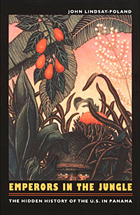 Emperors in the Jungle: The Hidden History of the U.S. in Panama
John Lindsay-Poland
Duke University Press, 2003 Emperors in the Jungle is an exposé of key episodes in the military involvement of the United States in Panama. Investigative journalism at its best, this book reveals how U.S. ideas about taming tropical jungles and people, combined with commercial and military objectives, shaped more than a century of intervention and environmental engineering in a small, strategically located nation. Whether uncovering the U.S. Army’s decades-long program of chemical weapons tests in Panama or recounting the invasion in December 1989 which was the U.S. military’s twentieth intervention in Panama since 1856, John Lindsay-Poland vividly portrays the extent and costs of U.S. involvement. Analyzing new evidence gathered through interviews, archival research, and Freedom of Information Act requests, Lindsay-Poland discloses the hidden history of U.S.–Panama relations, including the human and environmental toll of the massive canal building project from 1904 to 1914. In stunning detail he describes secret chemical weapons tests—of toxins including nerve agent and Agent Orange—as well as plans developed in the 1960s to use nuclear blasts to create a second canal in Panama. He chronicles sustained efforts by Panamanians and international environmental groups to hold the United States responsible for the disposal of the tens of thousands of explosives it left undetonated on the land it turned over to Panama in 1999. In the context of a relationship increasingly driven by the U.S. antidrug campaigns, Lindsay-Poland reports on the myriad issues that surrounded Panama’s takeover of the canal in accordance with the 1977 Panama Canal Treaty, and he assesses the future prospects for the Panamanian people, land, and canal area. Bringing to light historical legacies unknown to most U.S. citizens or even to many Panamanians, Emperors in the Jungle is a major contribution toward a new, more open relationship between Panama and the United States.
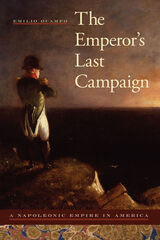 The Emperor's Last Campaign: A Napoleonic Empire in America
Emilio Ocampo
University of Alabama Press, 2009 Winner of the 2009 Literary Award, sponsored by the International Napoleonic Society/La Societe Napoleonienne Internationale of Montreal, Quebec's Literary Committee Napoleon’s last campaign didn’t end at Waterloo. After that fateful day on June 1815, hundreds if not thousands of veterans of Napoleon’s army emigrated to America. Many went farther south and joined the rebels fighting for independence in the Spanish colonies, from Mexico to Buenos Aires. The Bonapartists roiled the Western World as they sought fortune, fame, and glory in the expanding United States and in the tumultuous Spanish Americas suffering from repression and civil disorder, and even in the states of Europe. They were joined by adventurers from other nations who shared their admiration for the fallen emperor. This is the first full-length examination of the Bonapartists who emigrated from France after Napoleon’s defeat and exile, who formed a loose confederation with adventurers and romantics, and who contemplated a new empire in the Western Hemisphere. The scheme had the support and encouragement of the fallen emperor himself and his brother Joseph, former King of Spain, who lived in exile in the United States. Emilio Ocampo has examined archives on three continents and sources in several languages to ferret out the evidence—a monumental task considering that conspirators tried to leave no evidence of their plans, and that a failed plot, like failure in general, leaves few claimants. Ocampo reinterprets Latin American independence as an international event that drew in all the major powers. By illuminating the complex connections between the shattered France of the Bourbon restoration; an England threatened by radical politician inspired by the French Revolution; Napoleon in exile at St. Helena; the United States, where home-grown adventurers and French émigrés alike saw opportunity; and the collapsing Spanish colonial empire, where revolutionaries were allying themselves with the veterans of Napoleon’s Grande Armée, Ocampo brings together two bodies of scholarship: Napoleonic history and Latin American independence. He does so by tracing the steps of four of the most fascinating characters of the era: two Britons disaffected with their own government—Lord Thomas Cochrane and Sir Robert Wilson—and two former generals of Napolean’s army named Charles Lallemand and Michel Brayer. The Emperor’s Last Campaign is a fascinating story, well told, and peopled with all sorts of improbable characters and schemes that perhaps just missed coming to full fruition but that in the process contributed to one of the most important events of the nineteenth century: the breakdown of the Spanish empire in America and the rise of the United States as a world power.
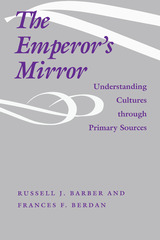 The Emperor's Mirror: Understanding Cultures through Primary Sources
Russell Barber
University of Arizona Press, 1998 Russell J. Barber and Frances F. Berdan have created the ultimate guide for anyone doing cross-cultural and/or document-driven research. Presenting the essentials of primary-source methodology, The Emperor's Mirror includes nine chapters on paleography, calendrics, source and quantitative analysis, and the visual interpretation of artifacts such as pictographs, illustrations, and maps.
As an introduction to ethnohistory, this book clearly defines terminology and provides practical and accessible examples, effectively integrating the concerns of historians and anthropologists as well as addressing the needs of anyone using primary sources for research in any academic field. A leading theme throughout the book is the importance of a researcher's awareness of the inherent biases of documents while doing research on another culture. Documents are the result of people interpreting reality through the filter of their own experience, personality, and culture.
Barber and Berdan's reality mediation model shows students how to analyze documents to detect the implicit biases or subtexts inherent in primary-source materials. Students and scholars working with primary sources will particularly appreciate the case studies that Barber and Berdan use to illustrate the practical implications of using each methodology. These case studies not only apply method to actual research but also are fascinating in their own right: they range from a discussion of the debate over Tupinamba cannibalism to the illustration of Nahuatl, Spanish, and hybrid place names of Tlaxcala, Mexico.
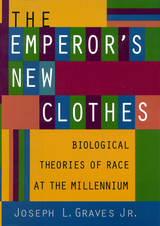 The Emperor's New Clothes: Biological Theories of Race at the Millennium
Graves Jr., Joseph L.
Rutgers University Press, 2003 In this groundbreaking book, Joseph Graves traces the development of biological thought about human genetic diversity. Greek philosophy, social Darwinism, New World colonialism, the eugenics movement, intelligence testing biases, and racial health fallacies are just a few of the topics he addresses. Graves argues that racism has persisted in our society because adequate scientific reasoning has not entered into the equation. He champions the scientific method and explains how we may properly ask scientific questions about the nature of population differentiation and how (if at all) we may correlate that diversity to observed human behavior. He also cautions us to think critically about scientific findings that have historically been misused in controversies over racial differences in intelligence heritability, criminal behavior, disease predisposition, and other traits. According to Graves, this country cannot truly address its racial problems until people understand the empirical evidence behind this truth that separate human races do not exist. With the biological basis for race removed, racism becomes an ideology, one that can and must be deleted.
The Emperor’s New Clothes: Literature, Literacy, and the Ideology of Style
Kathryn T. Flannery
University of Pittsburgh Press, 1995 Since the Renaissance, what has been considered the “best” style of writing has always been connected with the dominant cultural agenda of the time. In this book, Kathryn Flannery offers a demystifying perspective on theorists who have argued for an essential distinction between “content” and “style,” and focuses on the importance of understanding written prose style as a cultural asset. She addresses the development of prose criticism, the evolution of English teaching, the history of Francis Bacon and Richard Hooker's writing, and a modern discourse on stylistics.
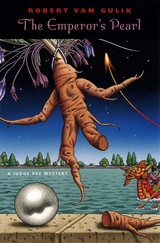 The Emperor's Pearl: A Judge Dee Mystery
Robert van Gulik
University of Chicago Press, 1963 A fiendishly clever mystery that can only be unraveled by the unflappable Judge Dee, whom the Los Angeles Times ranked with Sherlock Holmes
The latest puzzling mystery facing Jude Dee begins on the night of the Poo-yang dragonboat races in 699 A.D.: a drummer in the leading boat collapses, and the body of a beautiful young woman turns up in a deserted country mansion. There, Judge Dee—tribunal magistrate, inquisitor, and public avenger—steps in to investigate the murders and return order to the Tang Dynasty.
In The Emperor’s Pearl, the judge discovers that these two deaths are connected by an ancient tragedy involving a near-legendary treasure stolen from the Imperial Harem one hundred years earlier. The terrifying figure of the White Lady, a river goddess enshrined on a bloodstained altar, looms in the background of the investigation. Clues are few and elusive, but under the expert hand of Robert van Gulik, this mythic jigsaw puzzle assembles itself into a taut mystery.
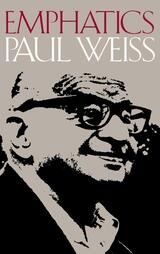 Emphatics
Paul Weiss
Vanderbilt University Press, 2000 Defining an "emphatic" as an intrusion that alters the import of what it intrudes on, Weiss sets the stage for an exquisitely systematic, speculative study of the major themes confronting modern metaphysics. The idea of an emphatic has its roots in Weiss's long-developed pluralistic ontology, with special focus on what we experience as an "emphasis." The most obvious examples are grammatical devices such as changed pitch in speech or exclamation and question marks in writing. Weiss also analyzes emphatics in etiquette, social status, nature, art, conventional behavior, encyclopedias, psychiatry, and religion. Brilliant in every respect, Emphatics rewrites Weiss's systematic ontology in new terms. Not only are the lineaments of the system reexamined, but this book floods the reader with new perspectives and insights on relationship, signs, truth, particularity, space-time causality, education, mind-body issues, Being and other ultimate philosophical categories, and good and evil. Weiss engages the various objections to his position in a series of question-and-answer epilogues at the end of each chapter that allow the reader to follow step-by-step a great philosophical mind at work. He takes his critics seriously, grapples with their objections, and answers them honestly. His discourse creatively revisits age-old questions and in reimagining new answers establishes the continuing relevance of philosophy as an academic discipline.
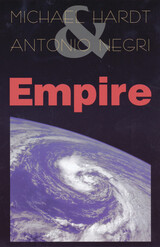 Empire
Michael Hardt and Antonio Negri
Harvard University Press, 2001 Imperialism as we knew it may be no more, but Empire is alive and well. It is, as Michael Hardt and Antonio Negri demonstrate in this bold work, the new political order of globalization. It is easy to recognize the contemporary economic, cultural, and legal transformations taking place across the globe but difficult to understand them. Hardt and Negri contend that they should be seen in line with our historical understanding of Empire as a universal order that accepts no boundaries or limits. Their book shows how this emerging Empire is fundamentally different from the imperialism of European dominance and capitalist expansion in previous eras. Rather, today’s Empire draws on elements of U.S. constitutionalism, with its tradition of hybrid identities and expanding frontiers.
Empire identifies a radical shift in concepts that form the philosophical basis of modern politics, concepts such as sovereignty, nation, and people. Hardt and Negri link this philosophical transformation to cultural and economic changes in postmodern society—to new forms of racism, new conceptions of identity and difference, new networks of communication and control, and new paths of migration. They also show how the power of transnational corporations and the increasing predominance of postindustrial forms of labor and production help to define the new imperial global order.
More than analysis, Empire is also an unabashedly utopian work of political philosophy, a new Communist Manifesto. Looking beyond the regimes of exploitation and control that characterize today’s world order, it seeks an alternative political paradigm—the basis for a truly democratic global society.
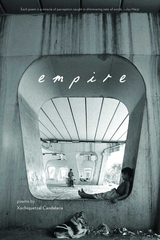 Empire
Xochiquetzal Candelaria
University of Arizona Press, 2011 Using both lyrical and narrative forms, these concise verses explore a family history set against the larger backdrop of Mexican history, immigration, and landscapes of the Southwest. The poet’s delicate touch lends these poems an organic quality that allows her to address both the personal and the political with equal grace. Straightforward without being simplistic or reductive, these poems manage to be intimate without seeming self-important.
This distinctive collection ranges from the frighteningly whimsical image of Cortés dancing gleefully around a cannon to the haunting and poignant discovery of a dead refugee boy seemingly buried within the poet herself. The blending of styles works to blur the lines between subjects, creating a textured narrative full of both imagination and nuance.
Ultimately, Empire situates individual experience in the wider social context, highlighting the power of poetry as song, performance, testimony, and witness. Addressing themes such as war, family, poverty, gender, race, and migration, Candelaria gives us a dialogue between historical and personal narratives, as well as discreet “conversations” between content and form.
Empire And Antislavery: Spain Cuba And Puerto Rico 1833-1874
Christopher Schmidt-Nowara
University of Pittsburgh Press, 1999 In 1872, there were more than 300,000 slaves in Cuba and Puerto Rico. Though the Spanish government had passed a law for gradual abolition in 1870, slaveowners, particularly in Cuba, clung tenaciously to their slaves as unfree labor was at the core of the colonial economies. Nonetheless, people throughout the Spanish empire fought to abolish slavery, including the Antillean and Spanish liberals and republicans who founded the Spanish Abolitionist Society in 1865. This book is an extensive study of the origins of the Abolitionist Society and its role in the destruction of Cuban and Puerto Rican slavery and the reshaping of colonial politics.
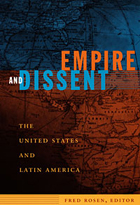 Empire and Dissent: The United States and Latin America
Fred Rosen, ed.
Duke University Press, 2008 Since the early nineteenth century, the United States has repeatedly intervened in the affairs of Latin American nations to pursue its own interests and to “protect” those countries from other imperial powers or from internal “threats.” The resentment and opposition generated by the encroachment of U.S. power has been evident in the recurrent attempts of Latin American nations to pull away from U.S. dominance and in the frequent appearance of popular discontent and unrest directed against imperialist U.S. policies. In Empire and Dissent, senior Latin Americanists explore the interplay between various dimensions of imperial power and the resulting dissent and resistance. Several essays provide historical perspective on contemporary U.S.–hemispheric relations. These include an analysis of the nature and dynamics of imperial domination, an assessment of financial relations between the United States and Latin America since the end of World War II, an account of Native American resistance to colonialism, and a consideration of the British government’s decision to abolish slavery in its colonies. Other essays focus on present-day conflicts in the Americas, highlighting various modes of domination and dissent, resistance and accommodation. Examining southern Mexico’s Zapatista movement, one contributor discusses dissent in the era of globalization. Other contributors investigate the surprisingly conventional economic policies of Brazil’s president, Luiz Inácio Lula da Silva; Argentina’s recovery from its massive 2001 debt default; the role of coca markets in the election of Bolivia’s first indigenous president, Evo Morales; and the possibilities for extensive social change in Venezuela. A readers’ guide offers a timeline of key events from 1823 through 2007, along with a list of important individuals, institutions, and places. Contributors: Daniel A. Cieza, Gregory Evans Dowd, Steve Ellner, Neil Harvey, Alan Knight, Carlos Marichal, John Richard Oldfield, Silvia Rivera, Fred Rosen, Jeffrey W. Rubin
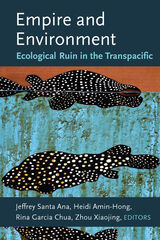 Empire and Environment: Ecological Ruin in the Transpacific
Jeffrey Santa Ana, Heidi Amin-Hong, Rina Garcia Chua, Zhou Xiaojing, Editors
University of Michigan Press, 2022 Empire and Environment argues that histories of imperialism, colonialism, militarism, and global capitalism are integral to understanding environmental violence in the transpacific region. The collection draws its rationale from the imbrication of imperialism and global environmental crisis, but its inspiration from the ecological work of activists, artists, and intellectuals across the transpacific region. Taking a postcolonial, ecocritical approach to confronting ecological ruin in an age of ecological crises and environmental catastrophes on a global scale, the collection demonstrates how Asian North American, Asian diasporic, and Indigenous Pacific Island cultural expressions critique a de-historicized sense of place, attachment, and belonging. In addition to its thirteen chapters from scholars who span the Pacific, each part of this volume begins with a poem by Craig Santos Perez. The volume also features a foreword by Macarena Gómez-Barris and an afterword by Priscilla Wald.
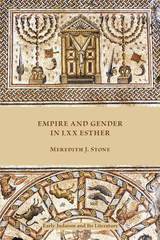 Empire and Gender in LXX Esther
Meredith J. Stone
SBL Press, 2018 A new perspective on essential aspects of Esther’s plot and characters for students and scholars
Empire and Gender in LXX Esther foregrounds and highlights empire as the central lens in this provocative new reading of Esther. This book provides a unique synchronic reading of LXX Esther with the Additions, allowing the presence and negotiation of imperial power to be further illuminated throughout the story’s plot. Stone explores and demonstrates how performances of gender are inextricably intertwined with the exertion and negotiation of imperial power portrayed in LXX Esther and offers examples of connections to the range of imperial power experienced by Jewish people during the late Second Temple period.
Features:
- An exploration of the tenets and methodology of imperial-critical approaches
- Focused attention to the final form of LXX Esther
- Construction of early audiences for LXX Esther in first-century BCE Ptolemaic Alexandria and Hasmonean Judea
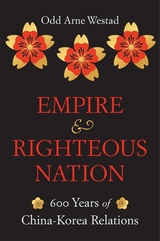 Empire and Righteous Nation: 600 Years of China-Korea Relations
Odd Arne Westad
Harvard University Press, 2020 From an award-winning historian, a concise overview of the deep and longstanding ties between China and the Koreas, providing an essential foundation for understanding East Asian geopolitics today.
In a concise, trenchant overview, Odd Arne Westad explores the cultural and political relationship between China and the Koreas over the past 600 years.
Koreans long saw China as a mentor. The first form of written Korean employed Chinese characters and remained in administrative use until the twentieth century. Confucianism, especially Neo-Confucian reasoning about the state and its role in promoting a virtuous society, was central to the construction of the Korean government in the fourteenth century. These shared Confucian principles were expressed in fraternal terms, with China the older brother and Korea the younger. During the Ming Dynasty, mentor became protector, as Korea declared itself a vassal of China in hopes of escaping ruin at the hands of the Mongols. But the friendship eventually frayed with the encroachment of Western powers in the nineteenth century. Koreans began to reassess their position, especially as Qing China seemed no longer willing or able to stand up for Korea against either the Western powers or the rising military threat from Meiji Japan. The Sino-Korean relationship underwent further change over the next century as imperialism, nationalism, revolution, and war refashioned states and peoples throughout Asia. Westad describes the disastrous impact of the Korean War on international relations in the region and considers Sino-Korean interactions today, especially the thorny question of the reunification of the Korean peninsula.
Illuminating both the ties and the tensions that have characterized the China-Korea relationship, Empire and Righteous Nation provides a valuable foundation for understanding a critical geopolitical dynamic.
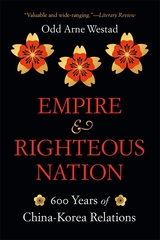 Empire and Righteous Nation: 600 Years of China-Korea Relations
Odd Arne Westad
Harvard University Press “The relationship between China and Korea is one of the most important, and least understood, in Asia. With the wisdom and clarity we have come to expect from Westad, this book illuminates the long history of these two neighbors.”
—Rana Mitter, author of China’s Good War
“A timely must-read primer on the China–Korea relationship…and its impact on and implications for our world today.”
—Carter J. Eckert, author of Park Chung Hee and Modern Korea
“Valuable and wide-ranging…As two thousand years of history have shown, China’s role in Korea is a complex one. Westad’s short and stimulating study provides many clues to understanding that relationship.”
—J. E. Hoare, Literary Review
“An insightful and entertaining primer on Korean history over the last 600 years.”
—Popular History Books
Koreans long saw China as a mentor and protector. Chinese culture heavily influenced Korea, whose first written language used Chinese characters, while Confucianism shaped the structure of Korean government. This deep, sometimes fraught, relationship has done more to shape the politics of the region than many realize.
During the Ming Dynasty, Korea agreed to become a vassal of China, in hopes of escaping ruin at the hands of the Mongols. The connection frayed in the nineteenth century, when the Qing, beset by domestic problems, did little to protect Korea from encroaching Western powers or the imperial designs of Meiji Japan. The relationship shifted again in the twentieth century as nationalism, revolution, and war refashioned Asia. Odd Arne Westad lays bare the disastrous impact of the Korean War on the region and offers a keen assessment of Sino–Korean interactions today, including the thorny question of reunification.
 Empire and the Bomb: How the U.S. Uses Nuclear Weapons to Dominate the World
Joseph Gerson
Pluto Press, 2007 The United States is the only country to have dropped the atomic bomb. Since the A-bombings of Hiroshima and Nagasaki, every U.S. president has threatened nuclear war. This concise history shows how the United States has used nuclear weapons to bolster its imperial ambitions. Leading nuclear specialist and peace campaigner Joseph Gerson explains why atomic weapons were first built and used---and how the United States uses them today to preserve its global empire.
Gerson reveals how and why the United States made more than twenty threats of nuclear attack during the Cold War---against Russia, China, Vietnam, and the Middle East. He shows how such threats continued under Presidents Bush, Clinton, and George W. Bush.
The book concludes with an appeal for the abolition of nuclear weapons and an overview of the history of the anti-nuclear movement. Drawing from a wide range of sources, including extensive government documents, this fascinating and timely account shows how the United States has used nuclear weapons to dominate the world.
Read a review of Empire and the Bomb:
http://www.jamesclayfuller.com/2007/09/terrifying-book-but-read-it-anyway.html
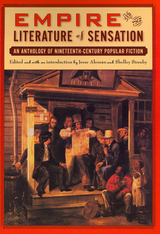 Empire and The Literature of Sensation: An Anthology of Nineteenth-Century Popular Fiction
Alemán, Jesse
Rutgers University Press, 2007 Mid-nineteenth-century American literature teems with the energy and excitement characteristic of the nation's era of expansion. It also reveals the intense anxiety and conflict of a country struggling with what it will mean, socially and culturally, to incorporate previously held Spanish territories. Empire and the Literature of Sensation is a critical anthology of some of the most popular and sensational writings published before the Civil War. It is a collection of transvestite adventures, forbidden love, class conflict, and terrifying encounters with racial "others."
Most of the accounts, although widely distributed in nineteenth-century newspapers, pamphlets, or dime store novels, have long been out of print. Reprinted here for the first time are novelettes by two superstars of the cheap fiction industry, Ned Buntline and George Lippard. Also included are selections from one of the first dime novels as well as the narratives of Leonora Siddons and Sophia Delaplain, both who claim in their autobiographical pamphlets to have cross-dressed as men and participated in the Texas rebellion and Cuban filibustering.
Originally written for entertainment and enormously popular in their day, these sensational thrillers reveal for today's audiences how the rhetoric of empire was circulated for mass consumption and how imperialism generated domestic and cultural instability during the period of the American literary renaissance.
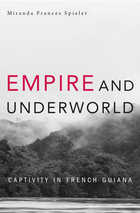 Empire and Underworld: Captivity in French Guiana
Miranda Frances Spieler
Harvard University Press, 2011 In the century after the French Revolution, the South American outpost of Guiana became a depository for exiles—outcasts of the new French citizenry—and an experimental space for the exercise of new kinds of power and violence against marginal groups. Miranda Spieler chronicles the encounter between colonial officials, planters, and others, ranging from deported political enemies to convicts, ex-convicts, vagabonds, freed slaves, non-European immigrants, and Maroons (descendants of fugitive slaves in the forest). She finds that at a time when France was advocating the revolutionary principles of liberty, equality, and fraternity, Guiana’s exiles were stripped of their legal identities and unmade by law, becoming nonpersons living in limbo.
The French Revolution invented the notion of the citizen, but as Spieler shows, it also invented the noncitizen—the person whose rights were nonexistent. Empire and Underworld discovers in Guiana’s wilderness a haunting prehistory of current moral dilemmas surrounding detainees of indeterminate legal status. Pairing the history of France with that of its underworld and challenging some of the century’s most influential theorists from Hannah Arendt to Michel Foucault, Spieler demonstrates how rights of the modern world can mutate into an apparatus of human deprivation.
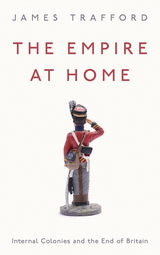 The Empire at Home: Internal Colonies and the End of Britain
James Trafford
Pluto Press, 2021 Modern Britain is forged through the redeployment of structures that facilitated and legitimized slavery, exploitation and extermination. This is the 'empire at home' and it is inseparable from the strategies of neo-colonial extraction and oppression of subjects abroad. Here, James Trafford develops the notion of internal colonies, arguing that methods and structures used in colonial rule are re-deployed internally in contemporary Britain in order to recreate and solidify imperial power relations. Using examples including housing segregation, targeted surveillance and counter-insurgency techniques used in the fight against terrorism, Trafford reveals Britain's internal colonialism to be a reactive mechanism to retain British sovereignty. As politics appears limited by nationalism and protectionism, The Empire at Home issues a powerful challenge to contemporary politics, demanding that Britain as an imperial structure must end.
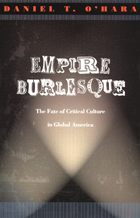 Empire Burlesque: The Fate of Critical Culture in Global America
Daniel T. O Hara
Duke University Press, 2003 Empire Burlesque traces the emergence of the contemporary global context within which American critical identity is formed. Daniel T. O’Hara argues that globalization has had a markedly negative impact on American cultural criticism, circumscribing both its material and imaginative potential, reducing much of it to absurdity. By highlighting the spectacle of its own self-parody, O’Hara aims to shock U.S. cultural criticism back into a sense of ethical responsibility. Empire Burlesque presents several interrelated analyses through readings of a range of writers and cultural figures including Henry James, Freud, Said, De Man, Derrida, and Cordwainer Smith (an academic, spy, and classic 1950s and 1960s science fiction writer). It describes the debilitating effects of globalization on the university in general and the field of literary studies in particular, it critiques literary studies’ embrace of globalization theory in the name of a blind and vacant modernization, and it meditates on the ways critical reading and writing can facilitate an imaginative alternative to institutionalized practices of modernization. Drawing on Lacanian psychoanalytical theory, it diagnoses contemporary American Studies as typically driven by the mindless abjection and transference of professional identities. A provocative commentary on contemporary cultural criticism, Empire Burlesque will inform debates on the American university across the humanities, particularly among those in literary criticism, cultural studies, and American studies.
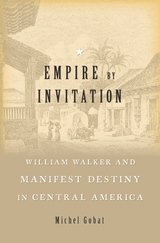 Empire by Invitation: William Walker and Manifest Destiny in Central America
Michel Gobat
Harvard University Press, 2018 Michel Gobat traces the untold story of the rise and fall of the first U.S. overseas empire to William Walker, a believer in the nation’s manifest destiny to spread its blessings not only westward but abroad as well.
In the 1850s Walker and a small group of U.S. expansionists migrated to Nicaragua determined to forge a tropical “empire of liberty.” His quest to free Central American masses from allegedly despotic elites initially enjoyed strong local support from liberal Nicaraguans who hoped U.S.-style democracy and progress would spread across the land. As Walker’s group of “filibusters” proceeded to help Nicaraguans battle the ruling conservatives, their seizure of power electrified the U.S. public and attracted some 12,000 colonists, including moral reformers. But what began with promises of liberation devolved into a reign of terror. After two years, Walker was driven out.
Nicaraguans’ initial embrace of Walker complicates assumptions about U.S. imperialism. Empire by Invitation refuses to place Walker among American slaveholders who sought to extend human bondage southward. Instead, Walker and his followers, most of whom were Northerners, must be understood as liberals and democracy promoters. Their ambition was to establish a democratic state by force. Much like their successors in liberal-internationalist and neoconservative foreign policy circles a century later in Washington, D.C., Walker and his fellow imperialists inspired a global anti-U.S. backlash. Fear of a “northern colossus” precipitated a hemispheric alliance against the United States and gave birth to the idea of Latin America.
 Empire City: The Making And Meaning Of
David Scobey
Temple University Press, 2003 New York's metamorphosis from compact port to modern metropolis occurred during the mid-nineteenth century. Empire City tells the story of the dreams that inspired the changes in the landscape and the problems that eluded solution.
Author David Scobey paints a remarkable panorama of New York's uneven development, a city-building process careening between obsessive calculation and speculative excess. Envisioning a new kind of national civilization, "bourgeois urbanists" attempted to make New York the nation's preeminent city. Ultimately, they created a mosaic of grand improvements, dynamic change, and environmental disorder. Empire City sets the stories of the city's most celebrated landmarks -- Central Park, the Brooklyn Bridge, the downtown commercial center -- within the context of this new ideal of landscape design and a politics of planned city building. Perhaps such an ambitious project for guiding growth, overcoming spatial problems, and uplifting public was bound to fail; still, it grips the imagination.
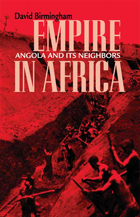 Empire in Africa: Angola and Its Neighbors
David Birmingham
Ohio University Press, 2006 The dark years of European fascism left their indelible mark on Africa. As late as the 1970s, Angola was still ruled by white autocrats, whose dictatorship was eventually overthrown by black nationalists who had never experienced either the rule of law or participatory democracy. Empire in Africa takes the long view of history and asks whether the colonizing ventures of the Portuguese can bear comparison with those of the Mediterranean Ottomans or those experienced by Angola’s neighbors in the Belgian Congo, French Equatorial Africa, or the Dutch colonies at the Cape of Good Hope and in the Transvaal. David Birmingham takes the reader through Angola’s troubled past, which included endemic warfare for the first twenty-five years of independence, and examines the fact that in the absence of a viable neocolonial referee such as Britain or France, the warring parties turned to Cold War superpowers for a supply of guns. For a decade Angola replaced Vietnam as a field in which an international war by proxy was conducted. Empire in Africa explains how this African nation went from colony to independence, how in the 1990s the Cold War legacy turned to civil war, and how peace finally dawned in 2002.
Empire in Denial: The Politics of State-Building
David Chandler
Pluto Press, 2006 In the 1990s, interventionist policies challenged the rights of individual states to self-governance. Today, non-Western states are more likely to be feted by international institutions offering programs of poverty-reduction, democratization and good governance. States without the right to self-government will always lack legitimate authority. The international policy agenda focuses on bureaucratic mechanisms, which can only institutionalize divisions between the West and the non-West and are unable to overcome the social and political divisions of post-conflict states. Highlighting the dangers of current policy—including the redefinition of sovereignty, and the subsequent erosion of ties linking power and accountability—David Chandler offers a critical look at state-building that will be of interest to all students of international affairs.
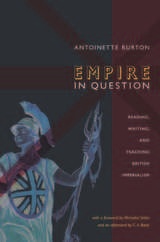 Empire in Question: Reading, Writing, and Teaching British Imperialism
Antoinette Burton
Duke University Press, 2011 Featuring essays written by the influential historian Antoinette Burton since the mid-1990s, Empire in Question traces the development of a particular, contentious strand of modern British history, the “new imperial history,” through the eyes of a scholar who helped to shape the field. In her teaching and writing, Burton has insisted that the vectors of imperial power run in multiple directions, argued that race must be incorporated into history writing, and emphasized that gender and sexuality are critical dimensions of imperial history. Empire in Question includes Burton’s groundbreaking critiques of British historiography, as well as essays in which she brings theory to bear on topics from Jane Eyre to nostalgia for colonial India. Burton’s autobiographical introduction describes how her early encounters with feminist and postcolonial critique led to her convictions that we must ask who counts as a subject of imperial history, and that we should maintain a healthy skepticism regarding the claims to objectivity that shape much modern history writing. In the coda, she candidly reflects on shortcomings in her own thinking and in the new imperial history, and she argues that British history must be repositioned in relation to world history. Much of Burton’s writing emerged from her teaching; Empire in Question is meant to engage students and teachers in debates about how to think about British imperialism in light of contemporary events.
 Empire, Incorporated: The Corporations That Built British Colonialism
Philip J. Stern
Harvard University Press, 2023 A Spectator Book of the Year
“Brilliant, ambitious, and often surprising. A remarkable contribution to the current global debate about empire.” —William Dalrymple, author of The Anarchy: The East India Company, Corporate Violence, and the Pillage of an Empire
“Remarkable…The richness of detail and evidence that Stern…brings to his subject is [new]—as is the lucidity with which he organises his material over six long chapters that stretch from the mid-16th century almost to the present.” —Linda Colley, Financial Times
“[A] commanding history of British corporate imperialism.” —Michael Ledger-Lomas, London Review of Books
Across four centuries and multiple continents, British colonialism was above all the business of corporations. Corporations conceived, promoted, financed, and governed overseas expansion, making claims over territory and peoples while ensuring that British and colonial society were invested, quite literally, in their ventures. The corporation was well-suited to overseas expansion not because it was an inevitable juggernaut but because, like empire itself, it was an elusive contradiction: public and private; person and society; subordinate and autonomous; centralized and diffuse; immortal and precarious; national and cosmopolitan—a legal fiction with very real power.
Breaking from traditional histories in which corporations take a supporting role by doing the dirty work of sovereign states in exchange for commercial monopolies, Philip Stern argues that corporations took the lead in global expansion and administration. And, as Empire, Incorporated makes clear, colonialism’s legacies continue to raise questions about corporate power that are just as relevant today as they were 400 years ago.
Challenging conventional wisdom about where power is held on a global scale, Stern complicates the supposedly firm distinction between private enterprise and the state, offering a new history of the British Empire, as well as a new history of the corporation.
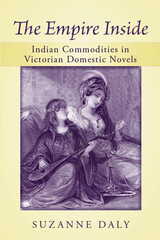 The Empire Inside: Indian Commodities in Victorian Domestic Novels
Suzanne Daly
University of Michigan Press, 2011 "The Empire Inside is unique in its tight focus on the objects from one geographical location, and their deployment in one genre of fiction. This combination results in a powerful study with a wealth of fine formal analyses of literary texts and a similar trove of marvelous historical data."
---Elaine Freedgood, New York University "In The Empire Inside, Suzanne Daly does a wonderful job integrating an array of primary materials, especially novels and journal essays, to show the extent to which these ‘foreign’ colonial products of India represented absolutely central aspects of domestic life, at once part of the unremarkable everyday experience of Victorians and rich with meanings."
---Timothy Carens, College of Charleston By the early nineteenth century, imperial commodities had become commonplace in middle-class English homes. Such Indian goods as tea, textiles, and gemstones led double lives, functioning at once as exotic foreign artifacts and as markers of proper Englishness. The Empire Inside: Indian Commodities in Victorian Domestic Novels reveals how Indian imports encapsulated new ideas about both the home and the world in Victorian literature and culture. In novels by Charlotte Brontë, Charles Dickens, and Anthony Trollope, the regularity with which Indian commodities appear bespeaks their burgeoning importance both ideologically and commercially. Such domestic details as the drinking of tea and the giving of shawls as gifts point us toward suppressed connections between the feminized realm of private life and the militarized realm of foreign commerce. Tracing the history of Indian imports yields a record of the struggles for territory and political power that marked the coming-into-being of British India; reading the novels of the period for the ways in which they infuse meaning into these imports demonstrates how imperialism was written into the fabric of everyday life in nineteenth-century England. Situated at the intersection of Victorian studies, material cultural studies, gender studies, and British Empire studies, The Empire Inside is written for academics, graduate students, and advanced undergraduates in all of these fields. Suzanne Daly is Associate Professor of English, University of Massachusetts Amherst.
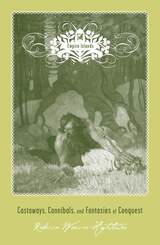 Empire Islands: Castaways, Cannibals, and Fantasies of Conquest
Rebecca Weaver-Hightower
University of Minnesota Press, 2007 Through a detailed unpacking of the castaway genre’s appeal in English literature, Empire Islands forwards our understanding of the sociopsychology of British Empire. Rebecca Weaver-Hightower argues convincingly that by helping generations of readers to make sense of—and perhaps feel better about—imperial aggression, the castaway story in effect enabled the expansion and maintenance of European empire.Empire Islands asks why so many colonial authors chose islands as the setting for their stories of imperial adventure and why so many postcolonial writers “write back” to those island castaway narratives. Drawing on insightful readings of works from Thomas More’s Utopia to Caribbean novels like George Lamming’s Water with Berries, from canonical works such as Robinson Crusoe and The Tempest to the lesser-known A Narrative of the Life and Astonishing Adventures of John Daniel by Ralph Morris, Weaver-Hightower examines themes of cannibalism, piracy, monstrosity, imperial aggression, and the concept of going native. Ending with analysis of contemporary film and the role of the United States in global neoimperialism, Weaver-Hightower exposes how island narratives continue not only to describe but to justify colonialism.Rebecca Weaver-Hightower is assistant professor of English and postcolonial studies at the University of North Dakota.
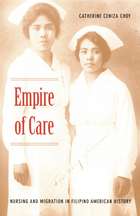 Empire of Care: Nursing and Migration in Filipino American History
Catherine Ceniza Choy
Duke University Press, 2003 In western countries, including the United States, foreign-trained nurses constitute a crucial labor supply. Far and away the largest number of these nurses come from the Philippines. Why is it that a developing nation with a comparatively greater need for trained medical professionals sends so many of its nurses to work in wealthier countries? Catherine Ceniza Choy engages this question through an examination of the unique relationship between the professionalization of nursing and the twentieth-century migration of Filipinos to the United States. The first book-length study of the history of Filipino nurses in the United States, Empire of Care brings to the fore the complicated connections among nursing, American colonialism, and the racialization of Filipinos .
Choy conducted extensive interviews with Filipino nurses in New York City and spoke with leading Filipino nurses across the United States. She combines their perspectives with various others—including those of Philippine and American government and health officials—to demonstrate how the desire of Filipino nurses to migrate abroad cannot be reduced to economic logic, but must instead be understood as a fundamentally transnational process. She argues that the origins of Filipino nurse migrations do not lie in the Philippines' independence in 1946 or the relaxation of U.S. immigration rules in 1965, but rather in the creation of an Americanized hospital training system during the period of early-twentieth-century colonial rule. Choy challenges celebratory narratives regarding professional migrants’ mobility by analyzing the scapegoating of Filipino nurses during difficult political times, the absence of professional solidarity between Filipino and American nurses, and the exploitation of foreign-trained nurses through temporary work visas. She shows how the culture of American imperialism persists today, continuing to shape the reception of Filipino nurses in the United States.
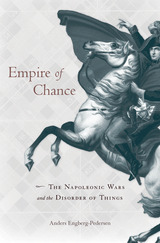 Empire of Chance: The Napoleonic Wars and the Disorder of Things
Anders Engberg-Pedersen
Harvard University Press, 2015 Napoleon’s campaigns were the most complex military undertakings in history before the nineteenth century. But the defining battles of Austerlitz, Borodino, and Waterloo changed more than the nature of warfare. Concepts of chance, contingency, and probability became permanent fixtures in the West’s understanding of how the world works. Empire of Chance examines anew the place of war in the history of Western thought, showing how the Napoleonic Wars inspired a new discourse on knowledge.
Soldiers returning from the battlefields were forced to reconsider basic questions about what it is possible to know and how decisions are made in a fog of imperfect knowledge. Artists and intellectuals came to see war as embodying modernity itself. The theory of war espoused in Carl von Clausewitz’s classic treatise responded to contemporary developments in mathematics and philosophy, and the tools for solving military problems—maps, games, and simulations—became models for how to manage chance. On the other hand, the realist novels of Balzac, Stendhal, and Tolstoy questioned whether chance and contingency could ever be described or controlled.
As Anders Engberg-Pedersen makes clear, after Napoleon the state of war no longer appeared exceptional but normative. It became a prism that revealed the underlying operative logic determining the way society is ordered and unfolds.
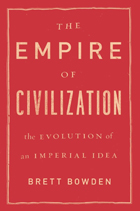 The Empire of Civilization: The Evolution of an Imperial Idea
Brett Bowden
University of Chicago Press, 2009 The term “civilization” comes with considerable baggage, dichotomizing people, cultures, and histories as “civilized”—or not. While the idea of civilization has been deployed throughout history to justify all manner of interventions and sociopolitical engineering, few scholars have stopped to consider what the concept actually means. Here, Brett Bowden examines how the idea of civilization has informed our thinking about international relations over the course of ten centuries. From the Crusades to the colonial era to the global war on terror, this sweeping volume exposes “civilization” as a stage-managed account of history that legitimizes imperialism, uniformity, and conformity to Western standards, culminating in a liberal-democratic global order. Along the way, Bowden explores the variety of confrontations and conquests—as well as those peoples and places excluded or swept aside—undertaken in the name of civilization. Concluding that the “West and the rest” have more commonalities than differences,this provocative and engaging bookultimately points the way toward an authentic intercivilizational dialogue that emphasizes cooperation over clashes.
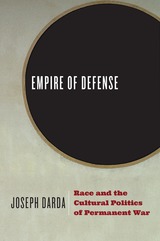 Empire of Defense: Race and the Cultural Politics of Permanent War
Joseph Darda
University of Chicago Press, 2019 Empire of Defense tells the story of how the United States turned war into defense. When the Truman administration dissolved the Department of War in 1947 and formed the Department of Defense, it marked not the end of conventional war but, Joseph Darda argues, the introduction of new racial criteria for who could wage it––for which countries and communities could claim self-defense.
From the formation of the DOD to the long wars of the twenty-first century, the United States rebranded war as the defense of Western liberalism from first communism, then crime, authoritarianism, and terrorism. Officials learned to frame state violence against Asians, Black and brown people, Arabs, and Muslims as the safeguarding of human rights from illiberal beliefs and behaviors. Through government documents, news media, and the writing and art of Joseph Heller, June Jordan, Trinh T. Minh-ha, I. F. Stone, and others, Darda shows how defense remade and sustained a weakened color line with new racial categories (the communist, the criminal, the authoritarian, the terrorist) that cast the state’s ideological enemies outside the human of human rights. Amid the rise of anticolonial and antiracist movements the world over, defense secured the future of war and white dominance.
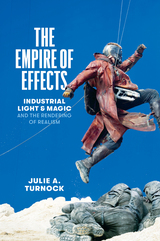 The Empire of Effects: Industrial Light and Magic and the Rendering of Realism
Julie A. Turnock
University of Texas Press, 2022 2024 Finalist, Marshall McLuhan Outstanding Book Award, Media Ecology Association How one company created the dominant aesthetic of digital realism.
Just about every major film now comes to us with an assist from digital effects. The results are obvious in superhero fantasies, yet dramas like Roma also rely on computer-generated imagery to enhance the verisimilitude of scenes. But the realism of digital effects is not actually true to life. It is a realism invented by Hollywood—by one company specifically: Industrial Light & Magic. The Empire of Effects shows how the effects company known for the puppets and space battles of the original Star Wars went on to develop the dominant aesthetic of digital realism. Julie A. Turnock finds that ILM borrowed its technique from the New Hollywood of the 1970s, incorporating lens flares, wobbly camerawork, haphazard framing, and other cinematography that called attention to the person behind the camera. In the context of digital imagery, however, these aesthetic strategies had the opposite effect, heightening the sense of realism by calling on tropes suggesting the authenticity to which viewers were accustomed. ILM’s style, on display in the most successful films of the 1980s and beyond, was so convincing that other studios were forced to follow suit, and today, ILM is a victim of its own success, having fostered a cinematic monoculture in which it is but one player among many.
Empire of Emptiness: Buddhist Art and Political Authority in Qing China
Patricia Berger
University of Hawaii Press, 2003 “The first complete translation of one of Candrakirti's major works into precise and readable English is a masterful achievement that might well encourage further collaboration between Western and Tibetan scholars. This is a contribution to be applauded.” —Journal of Religion “Huntington's philosophical interpretation . . . is argued with force and clarity. It corrects (with panache) many of the misinterpretations of Madhyamika still current among Anglophone writers.” —Journal of the American Oriental Society
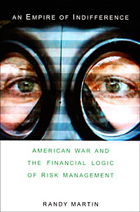 An Empire of Indifference: American War and the Financial Logic of Risk Management
Randy Martin
Duke University Press, 2007 In this significant Marxist critique of contemporary American imperialism, the cultural theorist Randy Martin argues that a finance-based logic of risk control has come to dominate Americans’ everyday lives as well as U.S. foreign and domestic policy. Risk management—the ability to adjust for risk and to leverage it for financial gain—is the key to personal finance as well as the defining element of the massive global market in financial derivatives. The United States wages its amorphous war on terror by leveraging particular interventions (such as Iraq) to much larger ends (winning the war on terror) and by deploying small numbers of troops and targeted weaponry to achieve broad effects. Both in global financial markets and on far-flung battlegrounds, the multiplier effects are difficult to foresee or control. Drawing on theorists including Michel Foucault, Giorgio Agamben, Michael Hardt, Antonio Negri, and Achille Mbembe, Martin illuminates a frightening financial logic that must be understood in order to be countered. Martin maintains that finance divides the world between those able to avail themselves of wealth opportunities through risk taking (investors) and those who cannot do so, who are considered “at risk.” He contends that modern-day American imperialism differs from previous models of imperialism, in which the occupiers engaged with the occupied to “civilize” them, siphon off wealth, or both. American imperialism, by contrast, is an empire of indifference: a massive flight from engagement. The United States urges an embrace of risk and self-management on the occupied and then ignores or dispossesses those who cannot make the grade.
Empire of Liberty: Power, Desire, and Freedom
Anthony Bogues
Dartmouth College Press, 2010 In this thoughtful and timely consideration of the nature of American power and empire, Anthony Bogues argues that America’s self-presentation as the bastion of liberty is an attempt to force upon the world a single universal truth, which has the objective of eradicating the radical imagination. Central to this project of American supremacy is the elaboration and construction of a language of power in which a form of self-government appears as the form of sovereignty. Grappling with issues of power, race, slavery, violence, and the nature of postcolonial criticism and critical theory, Bogues offers reconsiderations of the writings of W. E. B. DuBois and Frantz Fanon in order to break holes in this accepted structure of empire. At its heart this is a work of radical humanistic theory that seeks to glean from the postcolonial world and empire an alternative to its imperial form of freedom.
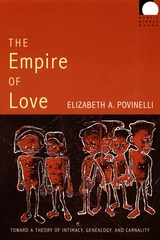 The Empire of Love: Toward a Theory of Intimacy, Genealogy, and Carnality
Elizabeth A. Povinelli
Duke University Press, 2006 In The Empire of Love anthropologist Elizabeth A. Povinelli reflects on a set of ethical and normative claims about the governance of love, sociality, and the body that circulates in liberal settler colonies such as the United States and Australia. She boldly theorizes intimate relations as pivotal sites where liberal logics and aspirations absorbed through settler imperialism are manifest, where discourses of self-sovereignty, social constraint, and value converge. For more than twenty years, Povinelli has traveled to the social worlds of indigenous men and women living at Belyuen, a small community in the Northern Territory of Australia. More recently she has moved across communities of alternative progressive queer movements in the United States, particularly those who identify as radical faeries. In this book she traces how liberal binary concepts of individual freedom and social constraint influence understandings of intimacy in these two worlds. At the same time, she describes alternative models of social relations within each group in order to highlight modes of intimacy that transcend a reductive choice between freedom and constraint. Shifting focus away from identities toward the social matrices out of which identities and divisions emerge, Povinelli offers a framework for thinking through such issues as what counts as sexuality and which forms of intimate social relations result in the distribution of rights, recognition, and resources, and which do not. In The Empire of Love Povinelli calls for, and begins to formulate, a politics of “thick life,” a way of representing social life nuanced enough to meet the density and variation of actual social worlds.
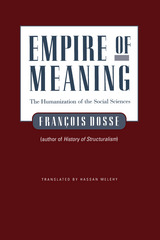 Empire Of Meaning: The Humanization Of The Social Sciences
Francois Dosse
University of Minnesota Press, 1998 After the brilliance of Derrida, Foucault, Barthes--what? By most accounts, the French intellectual scene, poststructuralism, has split in two. On one side, a few select philosophers as media stars are pressed for their opinions on virtually every subject; on the other side, an atomized community of scholars in the social sciences are bound up in technicalities and muffled by the lack of a common language. This great divide, Francois Dosse contends, augurs a tremendous change in the structure and conduct of intellectual life. What this shift means--how it has occurred and what parts various thinkers have played in shaping it--is the subject of Empire of Meaning.
An outgrowth of Dosse's magisterial History of Structuralism, Empire of Meaning is an extended encounter with some of the most influential French intellectuals. Through interviews and readings, Dosse reveals what has become of the intellectuals of the generation of '68 as they have tried to work out the implications of their revolt against structuralism and the problem of Cold War existence. Paul Ricoeur, Bruno Latour, Isabelle Stengers, Roger Chartier, Marcel Gauchet, Dany-Robert Dufour, and Michel Serres are among the many figures whose words and work unfold in these pages.
A thorough and thoroughly engrossing work of intellectual history, Empire of Meaning is a firsthand look at the reshaping of French intellectual life in our time.
"For the reader seeking rich historical detail, including names, places, schools, and research agendas, Empire of Meaning proves a veritable gold mine of information. The territory covered by Dosse is vast and impressive; the detail of his surveillance is overwhelming." --Rhetoric & Public Affairs
"Dosse reveals a new paradigm that might make us forget the great old ones: functionalism, structuralism, and Marxism. . . . Decidedly, this book is full of good news." --Le Nouveau Politis
"The immediate history of ideas is an undertaking as daring as it is risky, and Dosse here forces the relationships of trajectory and thought. . . . This book offers, in a very readable way, an overview of the current research in the social sciences." --Le Monde
Francois Dosse is a historian and author of numerous books, including History of Structuralism, Volume 1 and Volume 2.
Hassan Melehy is assistant professor of French at the University of Connecticut
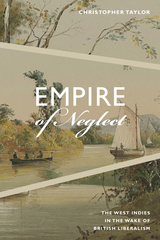 Empire of Neglect: The West Indies in the Wake of British Liberalism
Christopher Taylor
Duke University Press, 2018 Following the publication of Adam Smith’s The Wealth of Nations, nineteenth-century liberal economic thinkers insisted that a globally hegemonic Britain would profit only by abandoning the formal empire. British West Indians across the divides of race and class understood that, far from signaling an invitation to nationalist independence, this liberal economic discourse inaugurated a policy of imperial “neglect”—a way of ignoring the ties that obligated Britain to sustain the worlds of the empire’s distant fellow subjects. In Empire of Neglect Christopher Taylor examines this neglect’s cultural and literary ramifications, tracing how nineteenth-century British West Indians reoriented their affective, cultural, and political worlds toward the Americas as a response to the liberalization of the British Empire. Analyzing a wide array of sources, from plantation correspondence, political economy treatises, and novels to newspapers, socialist programs, and memoirs, Taylor shows how the Americas came to serve as a real and figurative site at which abandoned West Indians sought to imagine and invent postliberal forms of political subjecthood.
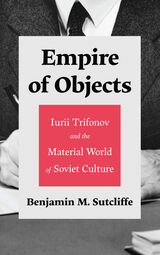 Empire of Objects: Iurii Trifonov and the Material World of Soviet Culture
Benjamin M. Sutcliffe
University of Wisconsin Press, 2023 Although understudied in the West, Iurii Trifonov was a canonical Soviet author whose lifetime spanned nearly the whole of the USSR’s history and who embodied many of its contradictions. The son of a Bolshevik murdered on Stalin’s orders, he wrote his first novel in praise of the dictator’s policies. A lifelong Muscovite, he often set his prose in the Central Asian peripheries of the USSR’s empire. A subtle critic of the communist regime, he nonetheless benefited from privileges doled out by a censorious state.
Scholars have both neglected Trifonov in recent years and focused their limited attention on the author’s most famous works, produced in the 1960s through 1980s. Yet almost half of his output was written before then. In Empire of Objects, Benjamin Sutcliffe takes care to consider the author’s entire oeuvre. Trifonov’s work reflects the paradoxes of a culture that could neither honestly confront the past nor create a viable future, one that alternated between trying to address and attempting to obscure the trauma of Stalinism. He became increasingly incensed by what he perceived as the erosion of sincerity in public and private life, by the impact of technology, and by the state’s tacit support of greed and materialism. Trifonov’s work, though fictional, offers a compelling window into Soviet culture.
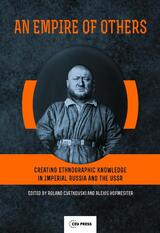 An Empire of Others: Creating Ethnographic Knowledge in Imperial Russia and the USSR
Alexis Hofmeister
Central European University Press, 2014 Ethnographers helped to perceive, to understand and also to shape imperial as well as Soviet Russia's cultural diversity. This volume focuses on the contexts in which ethnographic knowledge was created. Usually, ethnographic findings were superseded by imperial discourse: Defining regions, connecting them with ethnic origins and conceiving national entities necessarily implied the mapping of political and historical hierarchies. But beyond these spatial conceptualizations the essays particularly address the specific conditions in which ethnographic knowledge appeared and changed. On the one hand, they turn to the several fields into which ethnographic knowledge poured and materialized, i.e., history, historiography, anthropology or ideology. On the other, they equally consider the impact of the specific formats, i.e., pictures, maps, atlases, lectures, songs, museums, and exhibitions, on academic as well as non-academic manifestations.
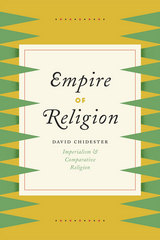 Empire of Religion: Imperialism and Comparative Religion
David Chidester
University of Chicago Press, 2014 How is knowledge about religion and religions produced, and how is that knowledge authenticated and circulated? David Chidester seeks to answer these questions in Empire of Religion, documenting and analyzing the emergence of a science of comparative religion in Great Britain during the second half of the nineteenth century and its complex relations to the colonial situation in southern Africa. In the process, Chidester provides a counterhistory of the academic study of religion, an alternative to standard accounts that have failed to link the field of comparative religion with either the power relations or the historical contingencies of the imperial project.
In developing a material history of the study of religion, Chidester documents the importance of African religion, the persistence of the divide between savagery and civilization, and the salience of mediations—imperial, colonial, and indigenous—in which knowledge about religions was produced. He then identifies the recurrence of these mediations in a number of case studies, including Friedrich Max Müller’s dependence on colonial experts, H. Rider Haggard and John Buchan’s fictional accounts of African religion, and W. E. B. Du Bois’s studies of African religion. By reclaiming these theorists for this history, Chidester shows that race, rather than theology, was formative in the emerging study of religion in Europe and North America. Sure to be controversial, Empire of Religion is a major contribution to the field of comparative religious studies.
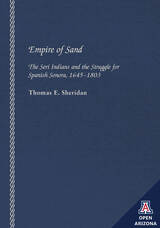 Empire of Sand: The Seri Indians and the Struggle for Spanish Sonora, 1645–1803
Compiled and edited by Thomas E. Sheridan
University of Arizona Press, 1999 From the earliest days of their empire in the New World, the Spanish sought to gain control of the native peoples and lands of what is now Sonora. While missionaries were successful in pacifying many Indians, the Seris--independent groups of hunter-gatherers who lived on the desert shores and islands of the Gulf of California--steadfastly defied Spanish efforts to subjugate them. Empire of Sand is a documentary history of Spanish attempts to convert, control, and ultimately annihilate the Seris. These papers of religious, military, and government officials attest to the Seris' resilience in the face of numerous Spanish attempts to conquer them and remove them from their lands. Most of the documents are being made available for the first time, while the few that have been published are extremely difficult to find. They include early observations of the Seris by Jesuit missionaries; the collapse of the Seri mission system in 1748; accounts of the invasion of Tibur¢n Island in 1750 and the Sonora Expedition of 1767-1771; and reports of late-eighteenth-century Seri hostilities. Thomas Sheridan's introduction puts the documents in perspective, while his notes objectively clarify their significance. In a superb analysis of contact history, Sheridan shows through these documents that Spaniards and Seris understood one another well, and it was their inability to tolerate each other's radically different societies and cultures that led to endless conflict between them. By skillfully weaving the documents into a coherent narrative of Spanish-Seri interaction, he has produced a compelling account of empire and resistance that speaks to anthropologists, historians, and all readers who take heart in stories of resistance to oppression.
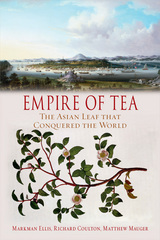 Empire of Tea: The Asian Leaf that Conquered the World
Markman Ellis, Richard Coulton, and Matthew Mauger
Reaktion Books, 2015 Although tea had been known and consumed in China and Japan for centuries, it was only in the seventeenth century that Londoners first began drinking it. Over the next two hundred years, its stimulating properties seduced all of British society, as tea found its way into cottages and castles alike. One of the first truly global commodities and now the world’s most popular drink, tea has also, today, come to epitomize British culture and identity.
This impressively detailed book offers a rich cultural history of tea, from its ancient origins in China to its spread around the world. The authors recount tea’s arrival in London and follow its increasing salability and import via the East India Company throughout the eighteenth century, inaugurating the first regular exchange—both commercial and cultural—between China and Britain. They look at European scientists’ struggles to understand tea’s history and medicinal properties, and they recount the ways its delicate flavor and exotic preparation have enchanted poets and artists. Exploring everything from its everyday use in social settings to the political and economic controversies it has stirred—such as the Boston Tea Party and the First Opium War—they offer a multilayered look at what was ultimately an imperial industry, a collusion—and often clash—between the world’s greatest powers over control of a simple beverage that has become an enduring pastime.
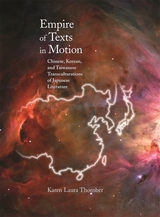 Empire of Texts in Motion: Chinese, Korean, and Taiwanese Transculturations of Japanese Literature
Karen Laura Thornber
Harvard University Press, 2009 By the turn of the twentieth century, Japan’s military and economic successes made it the dominant power in East Asia, drawing hundreds of thousands of Chinese, Korean, and Taiwanese students to the metropole and sending thousands of Japanese to other parts of East Asia. The constant movement of peoples, ideas, and texts in the Japanese empire created numerous literary contact nebulae, fluid spaces of diminished hierarchies where writers grapple with and transculturate one another’s creative output.
Drawing extensively on vernacular sources in Japanese, Chinese, and Korean, this book analyzes the most active of these contact nebulae: semicolonial Chinese, occupied Manchurian, and colonial Korean and Taiwanese transculturations of Japanese literature. It explores how colonial and semicolonial writers discussed, adapted, translated, and recast thousands of Japanese creative works, both affirming and challenging Japan’s cultural authority. Such efforts not only blurred distinctions among resistance, acquiescence, and collaboration but also shattered cultural and national barriers central to the discourse of empire. In this context, twentieth-century East Asian literatures can no longer be understood in isolation from one another, linked only by their encounters with the West, but instead must be seen in constant interaction throughout the Japanese empire and beyond.
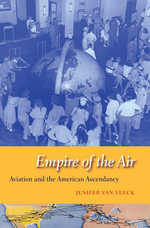 Empire of the Air: Aviation and the American Ascendancy
Jenifer Van Vleck
Harvard University Press, 2013 From the flights of the Wright brothers through the mass journeys of the jet age, airplanes inspired Americans to reimagine their nation’s place within the world. Now, Jenifer Van Vleck reveals the central role commercial aviation played in the United States’ rise to global preeminence in the twentieth century. As U.S. military and economic influence grew, the federal government partnered with the aviation industry to carry and deliver American power across the globe and to sell the very idea of the “American Century” to the public at home and abroad.
Invented on American soil and widely viewed as a symbol of national greatness, the airplane promised to extend the frontiers of the United States “to infinity,” as Pan American World Airways president Juan Trippe said. As it accelerated the global circulation of U.S. capital, consumer goods, technologies, weapons, popular culture, and expertise, few places remained distant from the influence of Wall Street and Washington. Aviation promised to secure a new type of empire—an empire of the air instead of the land, which emphasized access to markets rather than the conquest of territory and made the entire world America’s sphere of influence.
By the late 1960s, however, foreign airlines and governments were challenging America’s control of global airways, and the domestic aviation industry hit turbulent times. Just as the history of commercial aviation helps to explain the ascendance of American power, its subsequent challenges reflect the limits and contradictions of the American Century.
 Empire of the Dharma: Korean and Japanese Buddhism, 1877–1912
Hwansoo Ilmee Kim
Harvard University Press, 2013 Empire of the Dharma explores the dynamic relationship between Korean and Japanese Buddhists in the years leading up to the Japanese annexation of Korea. Conventional narratives cast this relationship in politicized terms, with Korean Buddhists portrayed as complicit in the “religious annexation” of the peninsula. However, this view fails to account for the diverse visions, interests, and strategies that drove both sides.
Hwansoo Ilmee Kim complicates this politicized account of religious interchange by reexamining the “alliance” forged in 1910 between the Japanese Soto sect and the Korean Wonjong order. The author argues that their ties involved not so much political ideology as mutual benefit. Both wished to strengthen Buddhism’s precarious position within Korean society and curb Christianity’s growing influence. Korean Buddhist monastics sought to leverage Japanese resources as a way of advancing themselves and their temples, and missionaries of Japanese Buddhist sects competed with one another to dominate Buddhism on the peninsula. This strategic alliance pushed both sides to confront new ideas about the place of religion in modern society and framed the way that many Korean and Japanese Buddhists came to think about the future of their shared religion.
Empire of the Periphery: Russia and the World System
Boris Kagarlitsky
Pluto Press, 2007 Leading writer Boris Kagarlitsky offers an ambitious account of 1000 years of Russian history. Encompassing all key periods in Russia's dramatic development, the book covers everything from early settlers, through medieval decline, Ivan the Terrible - the 'English Tsar', Peter the Great, the Crimean War and the rise of capitalism, the revolution, the Soviet period, finally ending with the return of capitalism after 1991.
Setting Russia within the context of the 'World System', as outlined by Wallerstein, this is a major work of historical Marxist theory that is set to become a future classic.
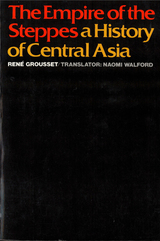 The Empire of the Steppes: A History of Central Asia
Grousset, René
Rutgers University Press, 1970 While the early history of the steppe nomads is shrouded in obscurity, this obscurity lifts somewhat after their contact with cultures possessing written histories. But even when information about them becomes relatively more plentiful, linguistic ocmplexities make its interpretation extremely difficult. Thus, while the number of specialized studies devoted to them is impressive, general works embracing the many disciplines involved, or syntheses on a grand scale encompassing the sprawling history of these peoples, are exceedingly scarce. Among these very few, The Empire of the Steppes is outstanding. The aim of this first English-language edition has been to make available a major work useful to the general reader as well as to the specialist, above all an edition which retains the majestic sweep and grandeur, as well as the overriding intellectual grasp, of Grousset's original.
Hailed as a masterpiece when first published in 1939, this great work of synthesis rapidly became indispensable to scholars fluent in French. Now, after a decade of preparation, this unique history of Central Asia is available in English, in a felicitous translation by Naomi Walford from the 1952 French edition, the last published in Grousset's lifetime. Nineteen maps have been expressly prepared for the Rutgers edition, and a comprehensive 54-page index has been added. In addition, specialists have checked the text, notes, and bibliographical references to bring this vast work into conformity with present-day academic standards.
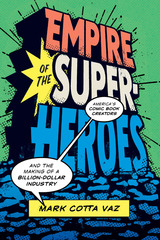 Empire of the Superheroes: America’s Comic Book Creators and the Making of a Billion-Dollar Industry
By Mark Cotta Vaz
University of Texas Press, 2021 Superman may be faster than a speeding bullet, but even he can't outrun copyright law. Since the dawn of the pulp hero in the 1930s, publishers and authors have fought over the privilege of making money off of comics, and the authors and artists usually have lost. Jerry Siegel and Joe Shuster, the creators of Superman, got all of $130 for the rights to the hero. In Empire of the Superheroes, Mark Cotta Vaz argues that licensing and litigation do as much as any ink-stained creator to shape the mythology of comic characters. Vaz reveals just how precarious life was for the legends of the industry. Siegel and Shuster—and their heirs—spent seventy years battling lawyers to regain rights to Superman. Jack Kirby and Joe Simon were cheated out of their interest in Captain America, and Kirby's children brought a case against Marvel to the doorstep of the Supreme Court. To make matters worse, the infant comics medium was nearly strangled in its crib by censorship and moral condemnation. For the writers and illustrators now celebrated as visionaries, the "golden age" of comics felt more like hard times. The fantastical characters that now earn Hollywood billions have all-too-human roots. Empire of the Superheroes digs them up, detailing the creative martyrdom at the heart of a pop-culture powerhouse.
Empire State-Building: War and Welfare in Kenya, 1925–1952
Joanna Lewis
Ohio University Press, 2001 This history of administrative thought and practice in colonial Kenya looks at the ways in which white people tried to engineer social change. It asks four questions:
- Why was Kenya’s welfare operation so idiosyncratic and spartan compared with that of other British colonies?
- Why did a transformation from social welfare to community development produce further neglect of the very poor?
- Why was there no equivalent to the French tradition of community medicine?
- If there was a transformatory element of colonial rule that sought to address poverty, where and why did it fall down? The answers offer revealing insight into the dynamics of rule in the late colonial period in Kenya.
The Empire Strikes Out: Kurd Lasswitz, Hans Dominik, and the Development of German Science Fiction
William B. Fischer
University of Wisconsin Press, 1984 German science fiction offers a most interesting contribution to the history and criticism of science fiction. William B. Fischer examines two writers, Kurd Lasswitz and Hans Dominik. He concludes that German science fiction is in distinct contrast to the “normative” tradition of modern Anglo-American science fiction and to many other literary traditions as well. His book demonstrates vividly the social relevance and enduring cultural vitality of science fiction.
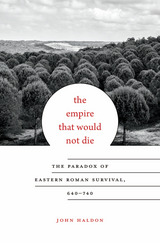 The Empire That Would Not Die: The Paradox of Eastern Roman Survival, 640–740
John Haldon
Harvard University Press, 2016 The eastern Roman Empire was the largest state in western Eurasia in the sixth century. Only a century later, it was a fraction of its former size. Surrounded by enemies, ravaged by warfare and disease, the empire seemed destined to collapse. Yet it did not die. In this holistic analysis, John Haldon elucidates the factors that allowed the eastern Roman Empire to survive against all odds into the eighth century.
By 700 CE the empire had lost three-quarters of its territory to the Islamic caliphate. But the rugged geography of its remaining territories in Anatolia and the Aegean was strategically advantageous, preventing enemies from permanently occupying imperial towns and cities while leaving them vulnerable to Roman counterattacks. The more the empire shrank, the more it became centered around the capital of Constantinople, whose ability to withstand siege after siege proved decisive. Changes in climate also played a role, permitting shifts in agricultural production that benefitted the imperial economy.
At the same time, the crisis confronting the empire forced the imperial court, the provincial ruling classes, and the church closer together. State and church together embodied a sacralized empire that held the emperor, not the patriarch, as Christendom’s symbolic head. Despite its territorial losses, the empire suffered no serious political rupture. What remained became the heartland of a medieval Christian Roman state, with a powerful political theology that predicted the emperor would eventually prevail against God’s enemies and establish Orthodox Christianity’s world dominion.
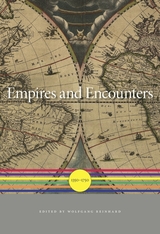 Empires and Encounters: 1350–1750
Wolfgang Reinhard
Harvard University Press, 2015 Between 1350 and 1750—a time of empires, exploration, and exposure to radically different lands and cultures—the world reached a tipping point of global connectedness. In this volume of the acclaimed series A History of the World, noted international scholars examine five critical geographical areas during this pivotal period: Eurasia between Russia and Japan; the Muslim world of the Ottoman and Persian empires; Mughal India and the Indian Ocean trading world; maritime Southeast Asia and Oceania; and a newly configured transatlantic rim. While people in many places remained unaware of anything beyond their own village, an intense period of empire building led to expanding political, economic, and cultural interaction on every continent—early signals of a shrinking globe.
By the early fourteenth century Eurasia’s Mongol empires were disintegrating. Concurrently, followers of both Islam and Christianity increased exponentially, with Islam exerting a powerful cultural influence in the spreading Ottoman and Safavid empires. India came under Mughal rule, experiencing a significant growth in trade along the Indian Ocean and East African coastlines. In Southeast Asia, Muslims engaged in expansion on the Malay Peninsula, Sumatra, Java, and the Philippines. And both sides of the Atlantic responded to the pressure of European commerce, which sowed the seeds of a world economy based on the resources of the Americas but made possible by the subjugation of Native Americans and the enslavement of Africans.
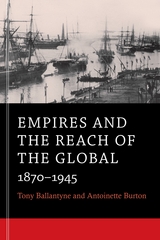 Empires and the Reach of the Global: 1870–1945
Tony Ballantyne and Antoinette Burton
Harvard University Press, 2014 Empires and the Reach of the Global brings the history of empires into sharp focus by showing how imperialism has been a shaping force not just in international politics but in the economies and cultures of today’s world. Focusing on both the strengths and limits of imperial power, Tony Ballantyne and Antoinette Burton describe the creation and disintegration of the reigning world order in the period from 1870 to 1945.
Using the British, Japanese, and Ottoman empires as case studies, the authors trace the communication, transportation, and economic networks that were instrumental to empire building. They highlight the role of empires as place-making regimes that organize geographic space as distinct territories. Militaries and missionaries, workplaces and households, all served as key domains of interaction within these territories, as colonial officials sought to manage the customs and lifeways of indigenous populations. Imperial connections contributed to the shrinking of time and space, but colonial encroachments also provoked opposition, which often played out in locations of everyday activity, from fields and factories to schools and prisons. Colonized territories sponsored a variety of forms of organized resistance, with full-fledged nationalist movements erupting onto the global scene in the interwar period.
Ballantyne and Burton stress that empire was not something fabricated in European capitals and implemented “out there.” Rather, imperial systems, with their many racial, gendered, and economic forms, affected empires in all of their parts—the metropole as well as the farthest outpost.
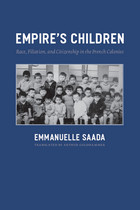 Empire's Children: Race, Filiation, and Citizenship in the French Colonies
Emmanuelle Saada
University of Chicago Press, 2012 Europe’s imperial projects were often predicated on a series of legal and scientific distinctions that were frequently challenged by the reality of social and sexual interactions between the colonized and the colonizers.When Emmanuelle Saada discovered a 1928 decree defining the status of persons of mixed parentage born in French Indochina—the métis—she found not only a remarkable artifact of colonial rule, but a legal bombshell that introduced race into French law for the first time. The decree was the culmination of a decades-long effort to resolve the “métis question”: the educational, social, and civil issues surrounding the mixed population. Operating at the intersection of history, anthropology, and law, Empire’s Children reveals the unacknowledged but central role of race in the definition of French nationality. Through extensive archival work in both France and Vietnam, and a close reading of primary and secondary material from the Pacific islands and sub-Saharan and North Africa, Saada has created in Empire’s Children an original and compelling perspective on colonialism, law, race, and culture from the end of the nineteenth century until decolonization.
 Empire's Companion: Virgilian Epics from Colonial Iberoamerica
Erika Valdivieso
University of Chicago Press A study of how Latin poetry shaped colonial aspirations in sixteenth- to eighteenth-century South and Central America.
Accompanying Iberian colonizers to the Americas, Virgil’s Aeneid inspired generations of colonial elites to write their own epic poems in Latin—priming imaginations for Spanish and Portuguese rule in the Americas. In Empire’s Companion, Erika Valdivieso recovers this lost strain of poetry for classicists and early Americanists alike. Each chapter introduces readers to a new poem that adapts Virgil for a different geographic context. These epics, Valdivieso argues, show elites working to reshape the New World in their own image, drawing on Virgil to think about the conquest of Indigenous peoples, new ideas about the globe, and shifting power dynamics between America and Europe. A powerful corrective to prevailing ideas about the reception of Virgil in the Americas, Empire’s Companion reveals the imperial potential of the Aeneid in the hands of governing elites.
Empire's Edge: American Society in Nome, Alaska, 1898-1934
Preston Jones
University of Alaska Press, 2006 In 1898, Nome, Alaska, burst into the American consciousness when one of the largest gold strikes in the world occurred on its shores. Over the next ten years, Nome’s population exploded as both men and women came north to seek their fortunes. Closer to Siberia than to New York, Nome’s citizens created their own version of small-town America on the northern frontier. Less than 150 miles from the Arctic Circle, they weathered the Great War and the diphtheria epidemic of 1925 as well as floods, fires, and the Great Depression. They enlivened the Alaska winters with pastimes such as high-school basketball and social clubs. Empire’s Edge is the story of how ordinary Americans made a life on the edge of a continent—a life both ordinary and extraordinary.
 Empire's End: Transnational Connections in the Hispanic World
Akiko Tsuchiya
Vanderbilt University Press, 2015 The fall of the Spanish Empire: that period in the nineteenth century when it lost its colonies in Spanish America and the Philippines. How did it happen? What did the process of the "end of empire" look like? Empire's End considers the nation's imperial legacy beyond this period, all the way up to the present moment. In addition to scrutinizing the political, economic, and social implications of this "end," these chapters emphasize the cultural impact of this process through an analysis of a wide range of representations—literature, literary histories, periodical publications, scientific texts, national symbols, museums, architectural monuments, and tourist routes—that formed the basis of transnational connections and exchange. The book breaks new ground by addressing the ramifications of Spain's imperial project in relation to its former colonies, not only in Spanish America, but also in North Africa and the Philippines, thus generating new insights into the circuits of cultural exchange that link these four geographical areas that are rarely considered together.
Empire's End showcases the work of scholars of literature, cultural studies, and history, centering on four interrelated issues crucial to understanding the end of the Spanish empire: the mappings of the Hispanic Atlantic, race, human rights, and the legacies of empire.
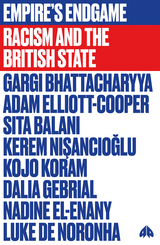 Empire's Endgame: Racism and the British State
Gargi Bhattacharyya
Pluto Press, 2021 We are in a moment of profound overlapping crises. The landscape of politics and entitlement is being rapidly and unpredictably remade. As movements against colonial legacies and state violence coincide with the rise of new authoritarian regimes, it is the analytical lens of racism, and the politics of race, that offers the sharpest focus. In Empire's Endgame, eight leading scholars make a powerful collective intervention in debates around racial capitalism and political crisis in the British context. While the 'Hostile Environment' policy and Brexit Referendum have thrown the centrality of race into sharp relief, discussions of racism have too often focused on individual attitudes and behaviors. Foregrounding instead the wider political and economic context, the authors of Empire's Endgame trace the ways in which the legacies of empire have been reshaped by global capitalism, the digital environment and the instability of the nation-state. Engaging with contemporary movements such as Black Lives Matter and Rhodes Must Fall, Empire's Endgame offers both an original perspective on race, media, the state and criminalization, and a vision of a political infrastructure that might include rather than expel in the face of crisis.
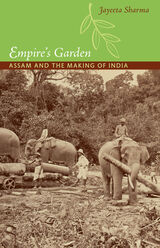 Empire's Garden: Assam and the Making of India
Jayeeta Sharma
Duke University Press, 2011 In the mid-nineteenth century the British created a landscape of tea plantations in the northeastern Indian region of Assam. The tea industry filled imperial coffers and gave the colonial state a chance to transform a jungle-laden frontier into a cultivated system of plantations. Claiming that local peasants were indolent, the British soon began importing indentured labor from central India. In the twentieth century these migrants were joined by others who came voluntarily to seek their livelihoods. In Empire’s Garden, Jayeeta Sharma explains how the settlement of more than one million migrants in Assam irrevocably changed the region’s social landscape. She argues that the racialized construction of the tea laborer catalyzed a process by which Assam’s gentry sought to insert their homeland into an imagined Indo-Aryan community and a modern Indian political space. Various linguistic and racial claims allowed these elites to defend their own modernity while pushing the burden of primitiveness onto “non-Aryan” indigenous tribals and migrant laborers. As vernacular print arenas emerged in Assam, so did competing claims to history, nationalism, and progress that continue to reverberate in the present.
Empires in Collision in Late Antiquity
G. W. Bowersock
Brandeis University Press, 2012 In this book, based on lectures delivered at the Historical Society of Israel, the famed historian G. W. Bowersock presents a searching examination of political developments in the Arabian Peninsula on the eve of the rise of Islam. Recounting the growth of Christian Ethiopia and the conflict with Jewish Arabia, he describes the fall of Jerusalem at the hands of a late resurgent Sassanian (Persian) Empire. He concludes by underscoring the importance of the Byzantine Empire’s defeat of the Sassanian forces, which destabilized the region and thus provided the opportunity for the rise and military success of Islam in the seventh century. Using close readings of surviving texts, Bowersock sheds new light on the complex causal relationships among the Byzantine, Ethiopian, Persian, and emerging Islamic forces.
 Empire's Law: The American Imperial Project and the 'War to Remake the World'
Edited by Amy Bartholomew
Pluto Press, 2006 "Empire's Law is first rate -- a 'must read' for students of international law, politics and ethics. It includes excellent contributions by key theorists and impressive case studies. This provocative and original collection should be read and taught in classes on both the undergraduate and graduate level."
Jean L. Cohen Professor of Political Science, Columbia University
"This remarkable collection of essays illuminates -- more fully than any other volume -- the world order costs of the Iraq War, especially the radical denial of the relevance of international law in the US's pursuit of global empire. To understand this overarching geopolitical challenge of the early 21st century, citizens the world over should treat Empire's Law as required reading."
Richard A. Falk, Albert G. Milbank Professor of International Law and Practice Emeritus, Princeton University and currently Visiting Professor of Global and International Studies, University of California, Santa Barbara
"Right now there can't be enough discussion of America's role in world politics ... This is a much-needed collection from leading scholars."
Neil Stammers, Senior Lecturer in the Department of International Relations and Politics, University of Sussex
What is the legacy of the war in Iraq? Can democracy and human rights really be imposed "by fire and sword"? This book brings together some of the world's most outstanding theorists in the debate over empire and international law. They provide a uniquely lucid account of the relationship between American imperialism, the use and abuse of "humanitarian intervention", and its legal implications. Empire's Law is ideal for students who want a comprehensive critical introduction to the impact that the doctrine of pre-emptive war has had on our capacity to protect human rights and promote global justice.
Leading contributors including Leo Panitch, Sam Gindin, Jurgen Habermas, Ulrich Preuss, Andrew Arato, Samir Amin, Reg Whitaker, Denis Halliday and Hans von Sponeck tackle a broad range of issues. Covering everything from the role of Europe and the UN, to people's tribunals, to broader theoretical accounts of the contradictions of war and human rights, the contributors offer new and innovative ways of examining the problems that we face. It is essential reading for all students who want a systematic framework for understanding the long-term consequences of imperialism.
Amy Bartholomew is an Associate Professor in the Department of Law at Carleton University.
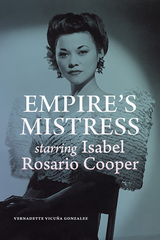 Empire's Mistress, Starring Isabel Rosario Cooper
Vernadette Vicuna Gonzalez
Duke University Press, 2021 In Empire's Mistress Vernadette Vicuña Gonzalez follows the life of Filipina vaudeville and film actress Isabel Rosario Cooper, who was the mistress of General Douglas MacArthur. If mentioned at all, their relationship exists only as a salacious footnote in MacArthur's biography—a failed love affair between a venerated war hero and a young woman of Filipino and American heritage. Following Cooper from the Philippines to Washington, D.C. to Hollywood, where she died penniless, Gonzalez frames her not as a tragic heroine, but as someone caught within the violent histories of U.S. imperialism. In this way, Gonzalez uses Cooper's life as a means to explore the contours of empire as experienced on the scale of personal relationships. Along the way, Gonzalez fills in the archival gaps of Cooper's life with speculative fictional interludes that both unsettle the authority of “official” archives and dislodge the established one-dimensional characterizations of her. By presenting Cooper as a complex historical subject who lived at the crossroads of American colonialism in the Philippines, Gonzalez demonstrates how intimacy and love are woven into the infrastructure of empire.
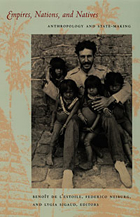 Empires, Nations, and Natives: Anthropology and State-Making
Benoît de L Estoile, Federico Neiburg and Lygia Sigaud, eds.
Duke University Press, 2005 Empires, Nations, and Natives is a groundbreaking comparative analysis of the interplay between the practice of anthropology and the politics of empires and nation-states in the colonial and postcolonial worlds. It brings together essays that demonstrate how the production of social-science knowledge about the “other” has been inextricably linked to the crafting of government policies. Subverting established boundaries between national and imperial anthropologies, the contributors explore the role of anthropology in the shifting categorizations of race in southern Africa, the identification of Indians in Brazil, the implementation of development plans in Africa and Latin America, the construction of Mexican and Portuguese nationalism, the genesis of “national character” studies in the United States during World War II, the modernizing efforts of the French colonial administration in Africa, and postcolonial architecture. The contributors—social and cultural anthropologists from the Americas and Europe—report on both historical and contemporary processes. Moving beyond controversies that cast the relationship between scholarship and politics in binary terms of complicity or autonomy, they bring into focus a dynamic process in which states, anthropological knowledge, and population groups themselves are mutually constructed. Such a reflexive endeavor is an essential contribution to a critical anthropological understanding of a changing world. Contributors: Alban Bensa, Marcio Goldman, Adam Kuper, Benoît de L’Estoile, Claudio Lomnitz, David Mills, Federico Neiburg, João Pacheco de Oliveira, Jorge Pantaleón, Omar Ribeiro Thomaz, Lygia Sigaud, Antonio Carlos de Souza Lima, Florence Weber
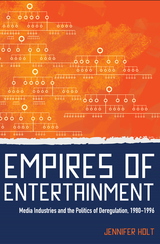 Empires of Entertainment: Media Industries and the Politics of Deregulation, 1980-1996
Holt, Jennifer
Rutgers University Press, 2011 Empires of Entertainment integrates legal, regulatory, industrial, and political histories to chronicle the dramatic transformation within the media between 1980 and 1996. As film, broadcast, and cable grew from fundamentally separate industries to interconnected, synergistic components of global media conglomerates, the concepts of vertical and horizontal integration were redesigned. The parameters and boundaries of market concentration, consolidation, and government scrutiny began to shift as America's politics changed under the Reagan administration. Through the use of case studies that highlight key moments in this transformation, Jennifer Holt explores the politics of deregulation, the reinterpretation of antitrust law, and lasting modifications in the media landscape.
Holt skillfully expands the conventional models and boundaries of media history. A fundamental part of her argument is that these media industries have been intertwined for decades and, as such, cannot be considered separately. Instead, film, cable and broadcast must be understood in relation to one another, as critical components of a common history. Empires of Entertainment is a unique account of deregulation and its impact on political economy, industrial strategies, and media culture at the end of the twentieth century.
 Empires of Hygiene, Volume 6
Judith Farquhar and Marta E. Hanson, eds.
Duke University Press Applying critical research on healing and the body to Asian studies, the articles in Empires of Hygiene challenges assumptions about the universality of medical truth. This special issue of positions investigates how medicine, the craft of healing, also acts as a sort of hygiene—a disciplinary agent against the unruly forces of nature and culture. Assuming the complicity of scientific medical practice with forms of domination and exclusion, the contributors not only demonstrate how medicine has been used as a tool of empire but also the ways in which events and institutions have literally transformed bodily life in Asia. Featuring a variety of topics and methods, essays in Empires of Hygiene compare the disease that is physically suffered to that which is scientifically classified and identified as a social problem. Diseases such as leprosy and STDs, which have biomedical identities in Western settings but in Asia emerge as inseparable from certain colonial regimes, are examined. Spermatorrhea—a disease that compromises the male body’s ability to reproduce—is discussed in relation to the disarray of the Chinese Republic during the mid-twentieth century. The collection also addresses imperial themes of prewar Japan in the literary works of Mori Rintaro and Shimazaki Tison. Contributors. Warwick Anderson, Michael Bourdaghs, Judith Farquhar, Marta Hanson, Thomas LaMarre, Philippa Levine, Hugh Shapiro, Nathan Sivin
 Empires of Ideas: Creating the Modern University from Germany to America to China
William C. Kirby
Harvard University Press, 2022 A Marginal Revolution Best Non-fiction Book
“[A] fascinating book.” –Steven Mintz, Inside Higher Ed
“Substantive on virtually every page, the author actually understands how universities work…An impressive performance.” —Tyler Cowen, Marginal Revolution
“With his extraordinary breadth of curiosity and equal ease in the histories and cultures of these countries, only Bill Kirby could have written this book. It is must-reading for everyone who cares about universities, a thought-provoking lesson in the strange mix of durability and vulnerability that defines this key modern institution.” —Richard Broadhead, President Emeritus, Duke University
“William Kirby’s new book is unique. I know of nothing else on higher education that resembles it in breadth, scope, and sheer comparative information and analysis. Anyone interested in the nature of universities during the past two centuries will want to read this volume.” —Neil L. Rudenstine, President Emeritus, Harvard University
Today American institutions dominate nearly every major ranking of global universities. Yet in historical terms, America’s preeminence is relatively new, and there is no reason to assume that US schools will continue to lead the world a century from now. Indeed, America’s supremacy in higher education is under great stress, particularly at its public universities, while Chinese universities are on the ascent. Will China threaten American primacy?
Empires of Ideas looks to the past two hundred years for answers, examining the successes of leading universities to determine how they rose to prominence and what threats they currently face. William C. Kirby gives special attention to the challenges that Chinese academic leaders must confront: reinvesting in undergraduate teaching, developing new models of funding, and navigating a political system that may undermine a true commitment to free inquiry and academic excellence.
 Empires of Islam in Renaissance Historical Thought
Margaret Meserve
Harvard University Press, 2008 Renaissance humanists believed that the origins of peoples could reveal crucial facts about their modern political character. Margaret Meserve explores what happened when European historians turned to study the political history of a faith other than their own.
Meserve investigates the methods and illuminates the motives of scholars negotiating shifting boundaries—between scholarly research and political propaganda, between a commitment to critical historical inquiry and the pressure of centuries of classical and Christian prejudice, between the academic ideals of humanism and the everyday demands of political patronage. Drawing on political oratory, diplomatic correspondence, crusade propaganda, and historical treatises, Meserve shows how research into the origins of Islamic empires sprang from—and contributed to—contemporary debates over the threat of Islamic expansion in the Mediterranean. Humanist histories of the Turks were sharply polemical, portraying the Ottomans as a rogue power. But writings on other Muslim polities include some of the first positive appraisals of Muslim statecraft in the European tradition.
This groundbreaking book offers new insights into Renaissance humanist scholarship and the longstanding European debates over the relationship between Christianity and Islam.
 Empires of the Sand: The Struggle for Mastery in the Middle East, 1789–1923
Efraim Karsh and Inari Karsh
Harvard University Press, 2001 Empires of the Sand offers a bold and comprehensive reinterpretation of the struggle for mastery in the Middle East during the long nineteenth century (1789-1923). This book denies primacy to Western imperialism in the restructuring of the region and attributes equal responsibility to regional powers. Rejecting the view of modern Middle Eastern history as an offshoot of global power politics, the authors argue that the main impetus for the developments of this momentous period came from the local actors.
Ottoman and Western imperial powers alike are implicated in a delicate balancing act of manipulation and intrigue in which they sought to exploit regional and world affairs to their greatest advantage. Backed by a wealth of archival sources, the authors refute the standard belief that Europe was responsible for the destruction of the Ottoman Empire and the region's political unity. Instead, they show how the Hashemites played a decisive role in shaping present Middle Eastern boundaries and in hastening the collapse of Ottoman rule. Similarly, local states and regimes had few qualms about seeking support and protection from the "infidel" powers they had vilified whenever their interests so required.
Karsh and Karsh see a pattern of pragmatic cooperation and conflict between the Middle East and the West during the past two centuries, rather than a "clash of civilizations." Such a vision affords daringly new ways of viewing the Middle East's past as well as its volatile present.
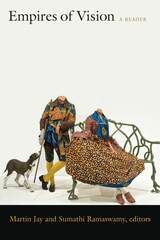 Empires of Vision: A Reader
Martin Jay and Sumathi Ramaswamy, eds.
Duke University Press, 2014 Empires of Vision brings together pieces by some of the most influential scholars working at the intersection of visual culture studies and the history of European imperialism. The essays and excerpts focus on the paintings, maps, geographical surveys, postcards, photographs, and other media that comprise the visual milieu of colonization, struggles for decolonization, and the lingering effects of empire. Taken together, they demonstrate that an appreciation of the role of visual experience is necessary for understanding the functioning of hegemonic imperial power and the ways that the colonized subjects spoke, and looked, back at their imperial rulers. Empires of Vision also makes a vital point about the complexity of image culture in the modern world: We must comprehend how regimes of visuality emerged globally, not only in the metropole but also in relation to the putative margins of a world that increasingly came to question the very distinction between center and periphery.
Contributors. Jordanna Bailkin, Roger Benjamin, Daniela Bleichmar, Zeynep Çelik, David Ciarlo, Natasha Eaton, Simon Gikandi, Serge Gruzinski, James L. Hevia, Martin Jay, Brian Larkin, Olu Oguibe, Ricardo Padrón, Christopher Pinney, Sumathi Ramaswamy, Benjamin Schmidt, Terry Smith, Robert Stam, Eric A. Stein, Nicholas Thomas, Krista A. Thompson
The Empire's Old Clothes: What the Lone Ranger, Babar, and Other Innocent Heroes Do to Our Minds
Ariel Dorfman
Duke University Press, 2010 In this powerful cultural critique, Ariel Dorfman explores the political and social implications of the smiling faces that inhabit familiar books, comics, and magazines. He reveals the ideological messages conveyed in works of popular culture such as the Donald Duck comics, the Babar children’s books, and Reader’s Digest magazine. The Empire’s Old Clothes was widely praised when it was first published in 1983. This edition, including a new preface by the author, makes a contemporary classic newly available.
 Empires on the Waterfront: Japan’s Ports and Power, 1858–1899
Catherine L. Phipps
Harvard University Press, 2015 Empires on the Waterfront offers a new spatial framework for understanding Japan’s extended transition into the modern world of nation-states. This study examines a largely unacknowledged system of “special trading ports” that operated under full Japanese jurisdiction in the shadow of the better-known treaty ports. By allowing Japan to circumvent conditions imposed on treaty ports, the special trading ports were key to achieving autonomy and regional power.
Catherine L. Phipps uses an overtly geographic approach to demonstrate that the establishment of Japan’s maritime networks depended on initiatives made and carried out on multiple geographical scales—global, national, and local. The story of the special trading ports unfolds in these three dimensions. Through an in-depth assessment of the port of Moji in northern Kyushu, Empires on the Waterfront recasts the rise of Japan’s own empire as a process deeply embedded in the complicated system of maritime relations in East Asia during the pivotal second half of the nineteenth century.
 Empires to Nations: Expansion in America, 1713-1824
Max Savelle
University of Minnesota Press, 1976
Empires to Nations was first published in 1974. Minnesota Archive Editions uses digital technology to make long-unavailable books once again accessible, and are published unaltered from the original University of Minnesota Press editions.
This history traces the growth of the Euroamerican societies in the Western Hemisphere during the eighteenth-century period of European expansion. Professor Savelle reviews the continuation and completion of the exploration of the American continent and describes the evolution of the New World empires of the English, French, Spanish, Portuguese, and Dutch, He devotes separate chapters to the development of the political structures of the colonies and the rivalries, wars, and diplomatic exchanges among the empires. He also reviews and analyzes the economic history of the colonial societies in their three-way relationships – with their mother countries, with each other, and within themselves as regional or local entities. Final chapters are devoted to the birth and growth of national self-consciousness among the new societies.
 Empire’s Twilight: Northeast Asia under the Mongols
David M. Robinson
Harvard University Press, 2009 The rise of the Mongol empire transformed world history. Its collapse in the mid-fourteenth century had equally profound consequences. Four themes dominate this study of the late Mongol empire in Northeast Asia during this chaotic era: the need for a regional perspective encompassing all states and ethnic groups in the area; the process and consequences of pan-Asian integration under the Mongols; the tendency for individual and family interests to trump those of dynasty, country, or linguistic affiliation; and finally, the need to see Koryo Korea as part of the wider Mongol empire.
Northeast Asia was an important part of the Mongol empire, and developments there are fundamental to understanding both the nature of the Mongol empire and the new post-empire world emerging in the 1350s and 1360s. In Northeast Asia, Jurchen, Mongol, Chinese, Korean, and Japanese interests intersected, and the collapse of the Great Yuan reshaped Northeast Asia dramatically. To understand this transition, or series of transitions, the author argues, one cannot examine states in isolation. The period witnessed intensified interactions among neighboring polities and new regional levels of economic, political, military, and social integration that explain the importance of personal and family interests and of Korea in the Mongol state.
Empirical and Experimental Methods in Cognitive/Functional Research
Edited by Sally Rice and John Newman
CSLI, 2010 Empirical and Experimental Methods in Cognitive/Functional Research consists of selected papers from the seventh meeting of the Conceptual Structure, Discourse, and Language Conference, held at the University of Alberta in October 2004. The papers fall into five main categories, reflecting the cognitive and functional orientation of the conference: reciprocity between lexis and syntax, semantic factors affecting form patterning, grammaticalization of basic verbs, form/meaning pairings in discourse, and experimental investigations of language/mind and language/use interactions. In addition, a plenary paper by Nick Evans on complex events, propositional overlay, and the special status of reciprocal clauses is included.
The Empirical Argument for God in Late British Thought
Peter Anthony Bertocci
Harvard University Press Through a critical analysis of several outstanding British thinkers. Peter Bertocci presents in this book an exposition of the broadest and most significant trend of thought that has developed in the philosophy of religion during the last seventy-five years. The philosophers who represent this movement at its best in England are James Martineau, Andrew Seth Pringle-Pattison, James Ward, William R. Sorley, and Frederick R Tennant. These thinkers agree in rejecting an empiricism which limits itself to the senses or to the world studied by the physical sciences, and insist on accounting especially for the moral experiences of men. Nowhere else may one find such a delineation of the meaning of empiricism for thought about God.
 The Empirical Base of Linguistics: Grammaticality Judgments and Linguistic Methodology
Carson T. Schütze
University of Chicago Press, 1996 Grammaticality judgments—intuitions about the well-formedness of sentences—often rest on subtle discriminations that are notoriously unstable and unreliable. Carson T. Schütze presents a detailed critical overview of the vast literature on the nature and utility of grammaticality judgments and other linguistic intuitions, and the ways they have been used in linguistic research. He shows how variation in the judgment process can arise and assesses the status of judgments as reliable indicators of a speaker's grammar.
Integrating substantive and methodological findings, Schütze proposes a model in which judgments result from interactions of linguistic competence with general cognitive processes, and offers practical suggestions about collecting more useful data. The result is a work of importance to linguists, cognitive psychologists, and philosophers of language alike.
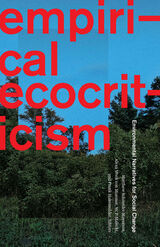 Empirical Ecocriticism: Environmental Narratives for Social Change
Matthew Schneider-Mayerson
University of Minnesota Press, 2023 A groundbreaking book that combines the environmental humanities and social sciences to study the impact of environmental stories There is a growing consensus that environmental narratives can help catalyze the social change necessary to address today’s environmental crises; however, surprisingly little is known about their impact and effectiveness. In Empirical Ecocriticism, Matthew Schneider-Mayerson, Alexa Weik von Mossner, W. P. Malecki, and Frank Hakemulder combine an environmental humanities perspective with empirical methods derived from the social sciences to study the influence of environmental stories on our affects, attitudes, and actions. Empirical Ecocriticism provides an approachable introduction to this growing field’s main methods and demonstrates their potential through case studies on topics ranging from the impact of climate fiction on readers’ willingness to engage in activism to the political empowerment that results from participating in environmental theater. Part manifesto, part toolkit, part proof of concept, and part dialogue, this introductory volume is divided into three sections: methods, case studies, and reflections. International in scope, it points toward a novel and fruitful synthesis of the environmental humanities and social sciences. Contributors: Matthew Ballew, Yale U; Helena Bilandzic, U of Augsburg; Rebecca Dirksen, Indiana U; Greg Garrard, UBC Okanagan; Matthew H. Goldberg, Yale U; Abel Gustafson, U of Cincinnati; David I. Hanauer, Indiana U of Pennsylvania; Ursula K. Heise, UCLA; Jeremy Jimenez, SUNY Cortland; Anthony Leiserowitz, Yale U; David M. Markowitz, U of Oregon; Marcus Mayorga; Jessica Gall Myrick, Penn State U; Mary Beth Oliver, Penn State U; Yan Pang, Point Park U; Mark Pedelty, U of Minnesota; Seth A. Rosenthal, Yale U; Elja Roy, U of Memphis; Nicolai Skiveren, Aarhus U; Paul Slovic, U of Oregon; Scott Slovic, U of Idaho; Nicolette Sopcak, U of Alberta; Paul Sopcak, MacEwan U; Sara Warner, Cornell U.
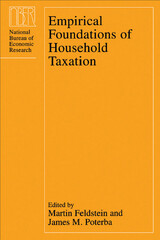 Empirical Foundations of Household Taxation
Edited by Martin Feldstein and James M. Poterba
University of Chicago Press, 1996 Tax policy debates—and reforms—depend heavily on estimates of how alternative tax rules would affect behavior. Yet there is considerable controversy about the key empirical links among tax rates, household decisions, and revenue collections.
The nine papers in this volume exploit the substantial variation in U.S. tax policy during the last two decades to investigate how taxes affect a range of household behavior, including labor-force participation, saving behavior, choice of health insurance plan, choice of child care arrangements, portfolio choice, and tax evasion. They also present new analytical results on the effects of different types of tax policy. All of this research relies on household-level data—drawn either from public-use tax return files or from large household-level surveys—to explore various aspects of the relationship between taxes and household behavior.
As debates about the effects of proposed tax reforms continue in the 1990s, this volume will be of interest to policy makers and scholars in the field of public finance.
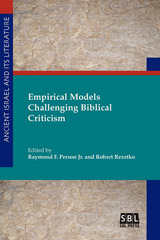 Empirical Models Challenging Biblical Criticism
Raymond F. Person
SBL Press, 2016 Cutting edge reflections on biblical text formation
Empirical models based on ancient Near Eastern literature and variations between different textual traditions have been used to lend credibility to the identification of the sources behind biblical literature and the different editorial layers. In this volume, empirical models are used to critique the exaggerated results of identifying sources and editorial layers by demonstrating that, even though much of ancient literature had such complex literary histories, our methods are often inadequate for the task of precisely identifying sources and editorial layers. The contributors are Maxine L. Grossman, Bénédicte Lemmelijn, Alan Lenzi, Sara J. Milstein, Raymond F. Person Jr., Robert Rezetko, Stefan Schorch, Julio Trebolle Barrera, Ian Young, and Joseph A. Weaks.
Features:
- Evidence that many ancient texts are composite texts with complex literary histories
- Ten essays and an introduction cover texts from Mesopotamia, the Hebrew Bible, the New Testament, and the Dead Sea Scrolls
 Empirical Models of Phonological Networks and Their Growth in English
Eva Maria Luef
Karolinum Press, 2025 This groundbreaking book unveils the crucial role of network science in understanding the lexical organization of second languages via its exploration of English learners.
Network science has become increasingly popular in the cognitive sciences, including linguistics. Phonological Networks and Their Growth in Second Languages is the first to explore lexical networks in learners of English as a second language with a focus on the relationships between phonological word forms in the mental lexicon. It highlights the contributions that network science can make to the study of lexical organization of second languages.
Within the theoretical framework of evolving networks, lexical learning is seen as a process of network growth. The book models the lexicon as a growing phonological network that increases in size as language users advance through second language proficiency stages. As such, the analysis of specific growth algorithms (such as preferential attachment) accounts for observed mechanisms of lexical acquisition. Empirical models of evolving lexical networks can help shed light on the structural changes occurring as the second language lexicon expands.
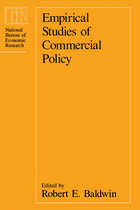 Empirical Studies of Commercial Policy
Edited by Robert E. Baldwin
University of Chicago Press, 1991 The need for careful research on trade policy is particularly acute, and this volume empirically addresses these and many other important issues. The contributors offer studies which integrate the institutional details of current trade policy with creative economic analyses.
Marked by a shift from a traditional reliance on simulation models, these papers take their inspiration from recent changes in the assumptions traditionally underlying research in international trade theory. No longer are government policies viewed as being somehow "given" to the researcher; in part 1, "Analyses with a Political Economy Perspective," four papers treat such policies as endogenous and explicable in terms of political economy. Neither are product and factor markets seen as perfectly competitive; instead, the three papers in part 2, "Trade Policy Effects under Imperfectly Competitive Market Conditions," assume that firms consider the actions of other companies when formulating their decisions. In part 3, "A New Measure of Trade Restrictiveness and Estimates of Trade Policy Effects with CGE Models," the first essay explores the quantitative restrictions on cheese to develop and implement a new model of restrictive trade. Two final contributions address problems for which simulation modeling is especially useful. The first considers the effectiveness of an import surcharge in reducing the U.S. trade deficit and the second treats the welfare effects of liberalization in South Korea where increasing returns to scale are significant
These innovative studies focus on economic behavior that will provide valuable insights for policymakers, academic economists, and students.
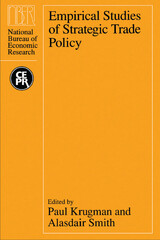 Empirical Studies of Strategic Trade Policy
Edited by Paul Krugman and Alasdair Smith
University of Chicago Press, 1994 Since the 1980s, economists have used the concept of strategic trade policy, which takes account of imperfect competition and increasing returns in the international marketplace, to criticize conventional views about free trade. According to the new view, a government can take strategic steps to raise its income at another country's expense—by subsidizing exports or erecting trade barriers, protecting certain firms from foreign competition, or promoting the development of new industries. This volume looks at the experience of specific industries in order to determine the effectiveness of strategic trade policy in promoting economic growth.
The nine papers cover the U.S. and European auto industries, the U.S. steel industry, the commercial aircraft industry, airline deregulation in Scandinavia, and labor and industrial policy in Korea and Taiwan. The authors refine the basic techniques for measuring policy effectiveness, extend them to encompass industry dynamics, and test the implications of new trade models.
International economists and trade experts in government and business will find important new insights into the role of strategic trade policy in international competitiveness.
 Empiricism and the Philosophy of Mind
Wilfrid Sellars and Richard Rorty
Harvard University Press, 1997 The most important work by one of America's greatest twentieth-century philosophers, Empiricism and the Philosophy of Mind is both the epitome of Wilfrid Sellars' entire philosophical system and a key document in the history of philosophy. First published in essay form in 1956, it helped bring about a sea change in analytic philosophy. It broke the link, which had bound Russell and Ayer to Locke and Hume--the doctrine of "knowledge by acquaintance." Sellars' attack on the Myth of the Given in Empiricism and the Philosophy of Mind was a decisive move in turning analytic philosophy away from the foundationalist motives of the logical empiricists and raised doubts about the very idea of "epistemology."
With an introduction by Richard Rorty to situate the work within the history of recent philosophy, and with a study guide by Robert Brandom, this publication of Empiricism and the Philosophy of Mind makes a difficult but indisputably significant figure in the development of analytic philosophy clear and comprehensible to anyone who would understand that philosophy or its history.
 Emplacing a Pilgrimage: The Ōyama Cult and Regional Religion in Early Modern Japan
Barbara Ambros
Harvard University Press, 2008 Towering over the Kanto Plain, the sacred mountain Ōyama (literally, “Big Mountain”) has loomed large over the religious landscape of early modern Japan.
By the Edo period (1600–1868), the revered peak had undergone a transformation from secluded spiritual retreat to popular pilgrimage destination. Its status as a regional landmark among its devotees was boosted by its proximity to the shogunal capital and the wide appeal of its amalgamation of Buddhism, Shinto, mountain asceticism, and folk beliefs. The influence of the Ōyama cult—the intersecting beliefs, practices, and infrastructure associated with the sacred site—was not lost on the ruling Tokugawa shogunate, which saw in the pilgrimage an opportunity to reinforce the communal ideals and social structures that the authorities espoused.
Barbara Ambros provides a detailed narrative history of the mountain and its place in contemporary society and popular religion by focusing on the development of the Ōyama cult and its religious, political, and socioeconomic contexts. Richly illustrated and carefully researched, this study emphasizes the importance of “site” or “region” in considering the multifaceted nature and complex history of religious practice in Tokugawa Japan.
 Employers Large and Small
Charles Brown, James T. Hamilton, and James Medoff
Harvard University Press Small business has captured the imagination of both the popular press and politicians. The tradition that has created sympathy for the small entrepreneur has been strengthened in recent years by images of small firms as dynamic, growing, and flexible and of large firms as struggling, outdated, and intractable in the face of changing competitive environments. There is, it appears, an added fervor for America’s support of “the little guy.”
Employers Large and Small draws on existing data and new research to create a more complete picture of the roles of large and small employers, challenging much of the conventional wisdom. It argues that the oft-cited achievement of small firms in generating new jobs is primarily a reflection of the fact that industries in which the typical firm is small have grown rapidly in recent years.
The authors show that there are striking differences between large and small employers—that in fact large employers pay higher wages, offer better fringe benefits, and on average offer a more attractive package of working conditions and compensation. These differences reflect real challenges faced by small firms: they pay more for their nonlabor inputs and for many fringe benefits if they choose to offer them.
Employers Large and Small also goes beyond the workplace, examining the role of large and small employers in politics. Despite the typical portrayal of small business as the underdog in policy disputes, the political resources of small employers are substantial. The PAC contributions of small business, for example, are as large as those of labor unions and nearly two-thirds those of big business.
The authors show that the economic and political differences between large and small employers are sizable, are significant influences in the working lives of Americans, and are at odds with current policy assumptions.
Employing Land-Based Anti-Ship Missiles in the Western Pacific
Terrence K. Kelly
RAND Corporation, 2013 Land-based anti-ship missiles (ASMs) feature prominently in the capabilities of many island nations in the Western Pacific, but the United States currently lacks such systems. This report illustrates the potential strategic advantages of the United States working with partners to build a coalition ASM capability, particularly in the event of a conflict with China, and includes an assessment of logistical challenges and positioning approaches.
Employment, Disability, and the Americans with Disabilities Act: Issues in Law, Public Policy, and Research
Peter David Blanck
Northwestern University Press, 2000 The Americans with Disabilities Act of 1990 (ADA) was heralded by its congressional sponsors as an "emancipation proclamation" for people with disabilities and as the most important civil rights legislation passed in a generation. Employment, Disability, and the Americans with Disabilities Act offers a meticulously documented assessment of what has occurred since the ADA's enactment. In reasoned, empirically based articles, contributors from law, health policy, government, and business reveal the unsoundness of charges from the right that the ADA will bankrupt industry and assumptions on the left that the ADA will prove ineffective in helping those with disabilities enter and remain in the workforce.
 Employment Hazards: An Investigation of Market Performance
W. Kip Viscusi
Harvard University Press, 1979 The safety of the work place is now a highly visible public issue. Many are calling for tighter regulation to reduce worker risk, while others feel government intervention is ineffective and costly. Here Kip Viscusi explores how well markets for hazardous jobs actually work. According to classical economics, other things being equal, a worker will demand more pay for a hazardous job than a safe one. However, this assumes that job related hazards are known, when often they are not. Using recent advances in the economics of information, Viscusi develops a theory of individual responses to job hazards under conditions of uncertainty.
His assumptions are that hazards are uncertain events and that learning about them is a process that takes place over time. He then employs this analysis to study the performance of job markets in matching persons and jobs and in compensating persons for exposure to hazards. Finally he tests his adaptive model of the decision to quit and finds substantial evidence that risks are indeed reflected in wage differentials and quit behavior.
Employment 'Miracles': A Critical Comparison of the Dutch, Scandinavian, Swiss, Australian and Irish Cases versus Germany and the US
Edited by Uwe Becker and Herman Schwartz
Amsterdam University Press, 2005 Why did some economies experience a boom in the 1990s? Discussing this crucial question, Employment 'Miracles' comparatively analyzes select "miracle" economies. The contributors critically analyze how the small sizes and institutional structures of seven countries—including the Netherlands, Denmark, and Ireland—accounted for their success and their status as economic models. Comparisons to the American and German markets reveal how differing policies—liberal versus corporatist/social democratic—determine job growth and levels of income inequality and poverty. The book also stresses the relevance of fortuitous circumstances such as the housing-price bubble. Employment 'Miracles' is an important resource for political scientists and economists in their study of national economies.
Emplumada
Lorna Dee Cervantes
University of Pittsburgh Press, 1981 Emplumada is Lorna Dee Cervantes’s first book, a collection of poems remarkable for their surface clarity, precision of image, and emotional urgency. Rooted in her Chicana heritage, these poems illuminate the American experience of the last quarter century and, at a time when much of what is merely fashionable in American poetry is recondite and exclusive, Cervantes has the ability to speak to and for a large audience.
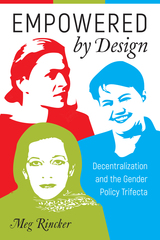 Empowered by Design: Decentralization and the Gender Policy Trifecta
Meg Rincker
Temple University Press, 2017 In her probing book, Empowered by Design, Meg Rincker asks, Under what conditions will decentralization lead to women’s empowerment in countries around the globe? Using three case studies—the United Kingdom, Poland, and Pakistan—she shows how decentralization reforms create new institutional offices as power shifts from the national level to a meso-tier level, which is located between the national government and local municipalities. These shifts impact a country’s political, administrative, and fiscal reforms as well as women’s representation. Rincker argues that this shift should be inclusive of women—or at least lead more women to participate in institutions—but this is not always the case. She indicates that three conditions, “the gender policy trifecta,” need to be met to achieve this: legislative gender quotas, women’s policy agencies, and gender-responsive budgeting at the level of governance in question. Rincker's innovative research uses original comparative data about what women want, quantitative cross-national analyses, and interviews with women’s organization leaders and politicians to show how cross-institutional policymaking can empower women. Rincker’s fine-grained analysis makes a significant contribution to the study of representation and gendered implications of decentralization, as well as how representatives go about understanding and aggregating our diverse policy preferences.
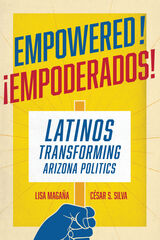 Empowered!: Latinos Transforming Arizona Politics
Lisa Magaña
University of Arizona Press, 2021 Empowered!examines Arizona’s recent political history and how it has been shaped and propelled by Latinos. It also provides a distilled reflection of U.S. politics more broadly, where the politics of exclusion and the desire for inclusion are forces of change. Lisa Magaña and César S. Silva argue that the state of Arizona is more inclusive and progressive then it has ever been. Following in the footsteps of grassroots organizers in California and the southeastern states, Latinos in Arizona have struggled and succeeded to alter the anti-immigrant and racist policies that have been affecting Latinos in the state for many years. Draconian immigration policies have plagued Arizona’s political history. Empowered! shows innovative ways that Latinos have fought these policies. Empowered! focuses on the legacy of Latino activism within politics. It raises important arguments about those who stand to profit financially and politically by stoking fear of immigrants and how resilient politicians and grassroots organizers have worked to counteract that fear mongering. Recognizing the long history of disenfranchisement and injustice surrounding minority communities in the United States, this book outlines the struggle to make Arizona a more just and equal place for Latinos to live.
Empowered: Popular Feminism and Popular Misogyny
Sarah Banet-Weiser
Duke University Press, 2018 In Empowered Sarah Banet-Weiser examines the deeply entwined relationship between popular feminism and popular misogyny as it plays out in advertising, online and multimedia platforms, and nonprofit and commercial campaigns. Examining feminist discourses that emphasize self-confidence, body positivity, and individual achievement alongside violent misogynist phenomena such as revenge porn, toxic geek masculinity, and men's rights movements, Banet-Weiser traces how popular feminism and popular misogyny are co-constituted. From Black Girls Code and the Always #LikeAGirl campaign to GamerGate and the 2016 presidential election, Banet-Weiser shows how popular feminism is met with a misogynistic backlash of mass harassment, assault, and institutional neglect. In so doing, she contends that popular feminism's problematic commitment to visibility limits its potential and collective power.
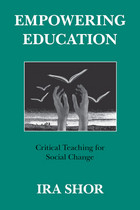 Empowering Education: Critical Teaching for Social Change
Ira Shor
University of Chicago Press, 1992 Ira Shor is a pioneer in the field of critical education who for over twenty years has been experimenting with learning methods. His work creatively adapts the ideas of Brazilian educator Paulo Freire for North American classrooms. In Empowering Education Shor offers a comprehensive theory and practice for critical pedagogy.
For Shor, empowering education is a student-centered, critical and democratic pedagogy for studying any subject matter and for self and social change. It takes shape as a dialogue in which teachers and students mutually investigate everyday themes, social issues, and academic knowledge. Through dialogue and problem-posing, students become active agents of their learning. This book shows how students can develop as critical thinkers, inspired learners, skilled workers, and involved citizens.
Shor carefully analyzes obstacles to and resources for empowering education, suggesting ways for teachers to transform traditional approaches into critical and democratic ones. He offers many examples and applications for the elementary grades through college and adult education.
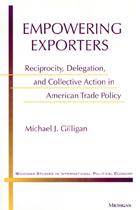 Empowering Exporters: Reciprocity, Delegation, and Collective Action in American Trade Policy
Michael J. Gilligan
University of Michigan Press, 1997 Until the New Deal, most groups seeking protection from imports were successful in obtaining relief from Congress. In general the cost of paying the tariffs for consumers was less than the cost of mounting collective action to stop the tariffs. In 1934, with the passage of the Reciprocal Trade Agreements Act, all of this changed. The six decades that followed have produced a remarkable liberalization of trade policy in the United States. This occurred despite the fact that domestic politics, according to some of the best developed theories, should have prevented this liberalization.
Michael Gilligan argues that liberalization has succeeded because it has been reciprocal with liberalization in other countries. Our trade barriers have been reduced as an explicit quid pro quo for reduction of trade barriers in other countries. Reciprocity, Gilligan argues, gives exporters the incentive to support free trade policies because it gives them a clear gain from free trade and thus enables the exporters to overcome collective action problems. The lobbying by exporters, balancing the interests of groups seeking protection, changes the preferences of political leaders in favor of more liberalization.
Gilligan tests his theory in a detailed exploration of the history of American trade policy and in a quantitative analysis showing increases in the demand for liberalization as the result of reciprocity in trade legislation from 1890 to the present. This book should appeal to political scientists, economists, and those who want to understand the political underpinnings of American trade policy.
Michael J. Gilligan is Assistant Professor of Politics, New York University.
 Empowering Latina Narratives: Navigating the Education/Educación Conflict in the Third Space
Margaret Cantú-Sánchez
University of Arizona Press, 2025 In this groundbreaking book, author Margaret Cantú-Sánchez takes on the U.S. educational system. Cantú-Sánchez introduces the concept of the education/educación conflict, where Latinas navigate the clash between home and school epistemologies under Anglocentric, assimilationist pedagogies. By analyzing literature, such as Barbara Renaud González’s Golondrina, Why Did You Leave Me?, and education testimonios from seminal works like This Bridge Called My Back and Telling to Live, Cantú-Sánchez reveals how Latina/Chicana protagonists and students negotiate this conflict through a mestizaje of epistemologies—blending elements of both home and school cultures within the third space of education. Cantú-Sánchez utilizes an interdisciplinary approach, deploying critical race theory, Chicana third-space feminism, and other pedagogical theories like sentipensante (a sensing/thinking) pedagogy employed by education scholar Laura Rendon, among others. By providing pivotal insights and strategies, she demonstrates how educators can implement culturally relevant pedagogies in their classrooms from K–12 through higher education, fostering environments where Latina/Chicana students can thrive without forsaking their cultural identities. Empowering Latina Narratives not only identifies the challenges Latina/Chicana students face but also offers a roadmap for overcoming them, making this book an essential resource for scholars, educators, and students committed to culturally inclusive education.
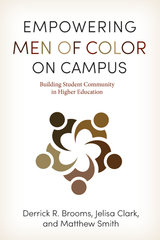 Empowering Men of Color on Campus: Building Student Community in Higher Education
Brooms, Derrick R.
Rutgers University Press, 2018 While recruitment efforts toward men of color have increased at many colleges and universities, their retention and graduation rates still lag behind those of their white peers. Men of color, particularly black and Latino men, face a number of unique challenges in their educational careers that often impact their presence on campus and inhibit their collegiate success. Empowering Men of Color on Campus examines how men of color negotiate college through their engagement in Brothers for United Success (B4US), an institutionally-based male-centered program at a Hispanic Serving Institution. Derrick R. Brooms, Jelisa Clark, and Matthew Smith introduce the concept of educational agency, which is harbored in cultural wealth and demonstrates how ongoing B4US engagement empowers the men’s efforts and abilities to persist in college. They found that the cultural wealth(s) of the community enhanced the students’ educational agency, which bolstered their academic aspirations, academic and social engagement, and personal development. The authors demonstrate how educational agency and cultural wealth can be developed and refined given salient and meaningful immersions, experiences, engagements, and communal connections.
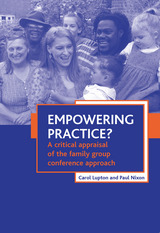 Empowering practice?: A critical appraisal of the family group conference approach
Carol Lupton and Paul Nixon
Bristol University Press, 1999 This innovative and timely book examines the nature and meaning of 'empowerment' in child welfare and protection, using the family group conference (FGC) approach to decision making as an example. In response to the growing clamour for 'evidence-based practice', the book addresses the central question of how the idea of empowerment can be operationalised and evaluated.One of the aims of FGCs is to empower children and their families by enabling them more effectively to participate in the decision-making process and by affording them greater control over the outcomes of that process. Empowering practice? critically assesses the available evidence on the empowerment potential of FGCs and examines the implications of the approach for professionals, their agencies and the children and families involved.Empowering practice? is essential reading for academics and professionals working in a wide range of health, education and social care areas.
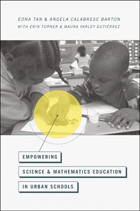 Empowering Science and Mathematics Education in Urban Schools
Edna Tan and Angela Calabrese Barton with Erin Turner and Maura Varley Gutiérrez
University of Chicago Press, 2012 Math and science hold powerful places in contemporary society, setting the foundations for entry into some of the most robust and highest-paying industries. However, effective math and science education is not equally available to all students, with some of the poorest students—those who would benefit most—going egregiously underserved. This ongoing problem with education highlights one of the core causes of the widening class gap. While this educational inequality can be attributed to a number of economic and political causes, in Empowering Science and Mathematics Education in Urban Communities, Angela Calabrese Barton and Edna Tan demonstrate that it is augmented by a consistent failure to integrate student history, culture, and social needs into the core curriculum. They argue that teachers and schools should create hybrid third spaces—neither classroom nor home—in which underserved students can merge their personal worlds with those of math and science. A host of examples buttress this argument: schools where these spaces have been instituted now provide students not only an immediate motivation to engage the subjects most critical to their future livelihoods but also the broader math and science literacy necessary for robust societal engagement. A unique look at a frustratingly understudied subject, Empowering Science and Mathematics Education pushes beyond the idea of teaching for social justice and into larger questions of how and why students participate in math and science.
|
|



